Challenges with ESOL in China: Reasons for Lack of Progress and Recommendations
VerifiedAdded on 2023/06/07
|42
|15208
|220
AI Summary
This research investigates the reasons for lack of progress in ESOL classes and English language acquisition in China. It provides recommendations to improve the situation and focuses on the challenges faced by ESOL students in China.
Contribute Materials
Your contribution can guide someone’s learning journey. Share your
documents today.
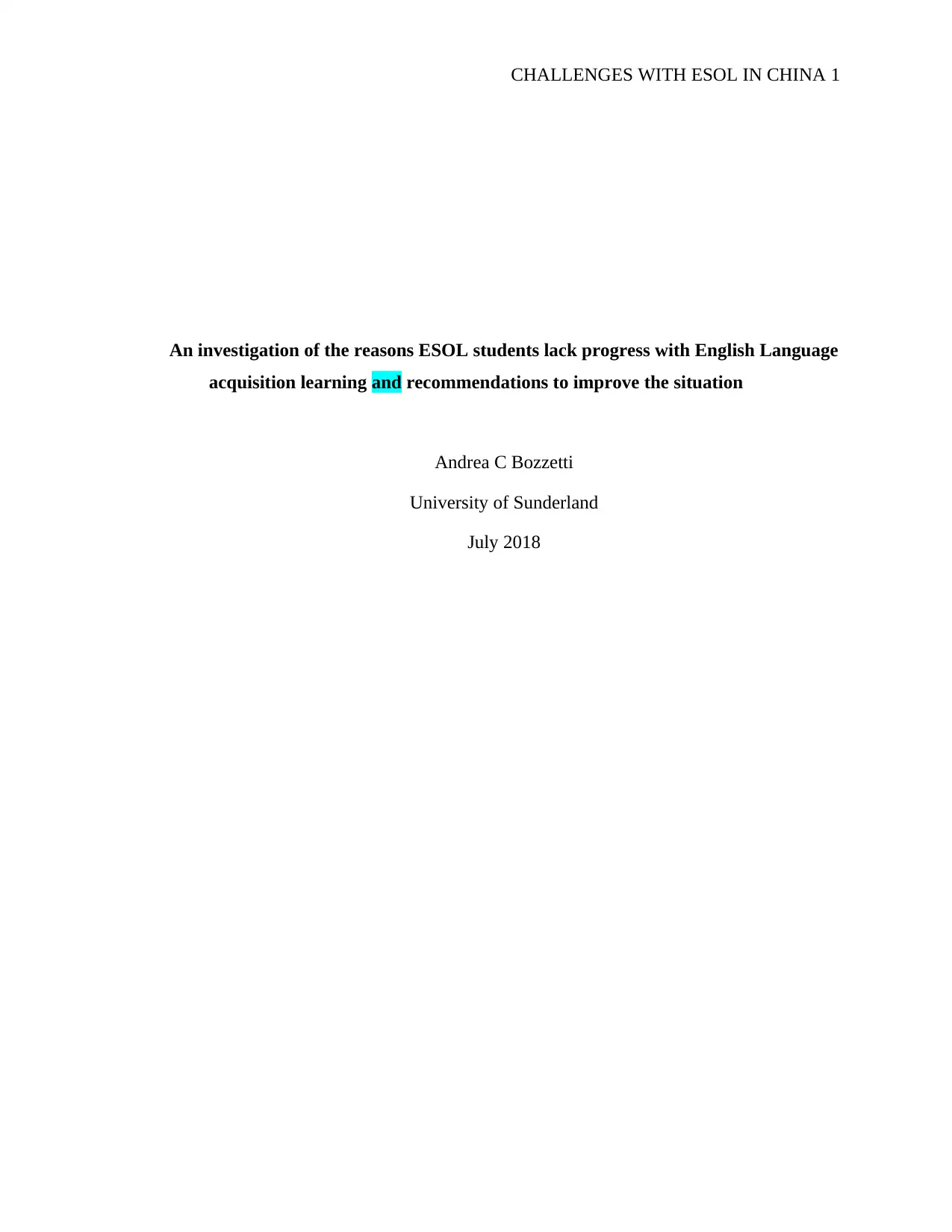
CHALLENGES WITH ESOL IN CHINA 1
An investigation of the reasons ESOL students lack progress with English Language
acquisition learning and recommendations to improve the situation
Andrea C Bozzetti
University of Sunderland
July 2018
An investigation of the reasons ESOL students lack progress with English Language
acquisition learning and recommendations to improve the situation
Andrea C Bozzetti
University of Sunderland
July 2018
Secure Best Marks with AI Grader
Need help grading? Try our AI Grader for instant feedback on your assignments.

CHALLENGES WITH ESOL IN CHINA 2
Table of Contents
Chapter 1- Introduction 5
1.1. Introduction 5
1.2. Background of the study 6
1.3. Problem statement 7
1.4. Aim of the research 9
1.5. Objectives of the research 9
1.6. Question 9
1.7. Significance of the study 10
1.8. Research setting 10
1.9. Summary 10
Chapter Two: Literature Review 10
2.1 Introduction to the Chapter 10
2.2 ESL in China 11
2.3 Theories Supporting ESOL Learning 13
2.3.1 Behaviorist View 13
2.3.2 Contrastive Analysis Theory 15
2.3.3 The theory of second language acquisition 17
2.4 Problems facing learners of English language 19
2.4.1 Mother tongue (L1) interference in English Language Learning 19
2.4.2 Lack of necessary material and poor background to equip the learners 20
2.4.3 Shortage of teaching practitioners of English language 20
2.4.4 Insufficient and inconsistent information for teachers 21
2.4.5 Psychological problems 23
Table of Contents
Chapter 1- Introduction 5
1.1. Introduction 5
1.2. Background of the study 6
1.3. Problem statement 7
1.4. Aim of the research 9
1.5. Objectives of the research 9
1.6. Question 9
1.7. Significance of the study 10
1.8. Research setting 10
1.9. Summary 10
Chapter Two: Literature Review 10
2.1 Introduction to the Chapter 10
2.2 ESL in China 11
2.3 Theories Supporting ESOL Learning 13
2.3.1 Behaviorist View 13
2.3.2 Contrastive Analysis Theory 15
2.3.3 The theory of second language acquisition 17
2.4 Problems facing learners of English language 19
2.4.1 Mother tongue (L1) interference in English Language Learning 19
2.4.2 Lack of necessary material and poor background to equip the learners 20
2.4.3 Shortage of teaching practitioners of English language 20
2.4.4 Insufficient and inconsistent information for teachers 21
2.4.5 Psychological problems 23
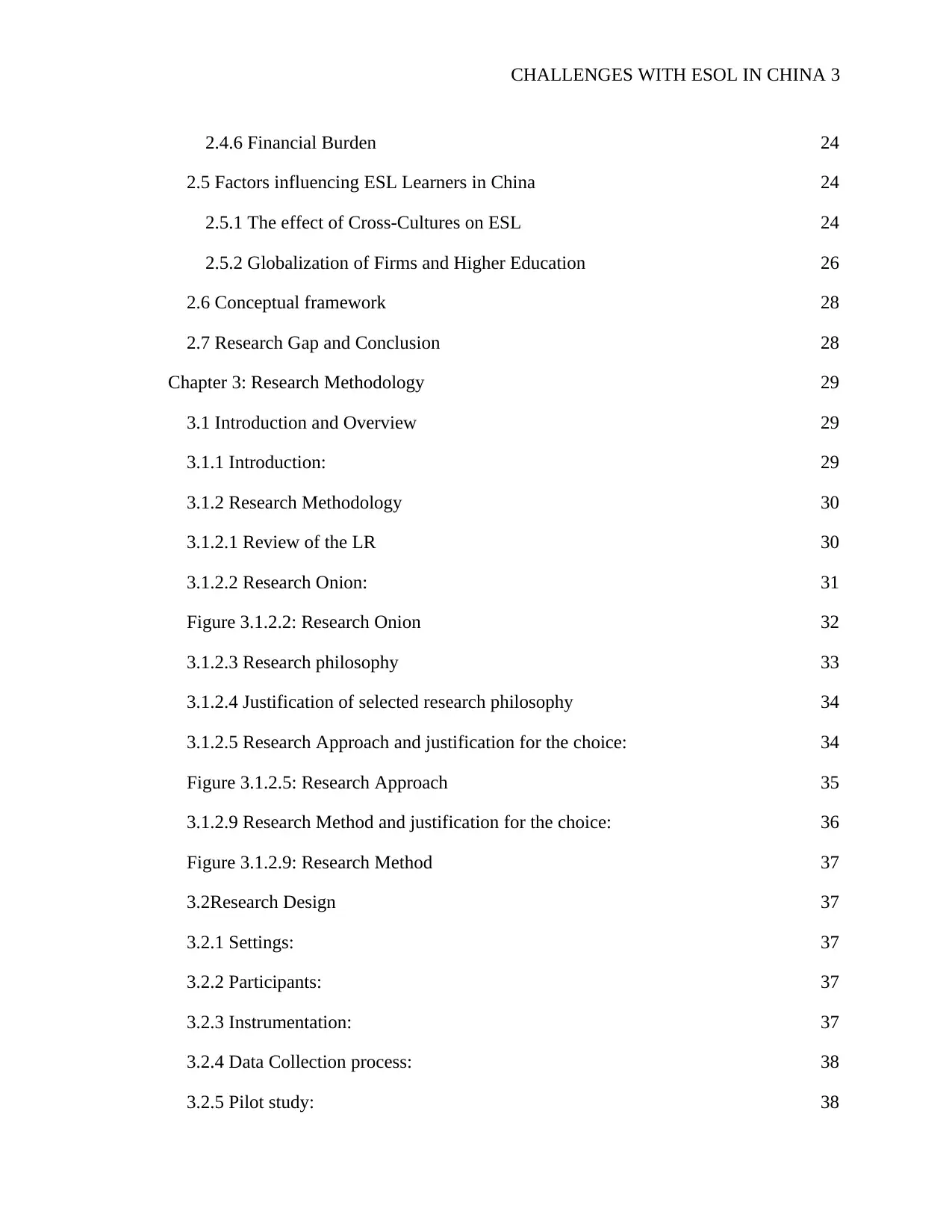
CHALLENGES WITH ESOL IN CHINA 3
2.4.6 Financial Burden 24
2.5 Factors influencing ESL Learners in China 24
2.5.1 The effect of Cross-Cultures on ESL 24
2.5.2 Globalization of Firms and Higher Education 26
2.6 Conceptual framework 28
2.7 Research Gap and Conclusion 28
Chapter 3: Research Methodology 29
3.1 Introduction and Overview 29
3.1.1 Introduction: 29
3.1.2 Research Methodology 30
3.1.2.1 Review of the LR 30
3.1.2.2 Research Onion: 31
Figure 3.1.2.2: Research Onion 32
3.1.2.3 Research philosophy 33
3.1.2.4 Justification of selected research philosophy 34
3.1.2.5 Research Approach and justification for the choice: 34
Figure 3.1.2.5: Research Approach 35
3.1.2.9 Research Method and justification for the choice: 36
Figure 3.1.2.9: Research Method 37
3.2Research Design 37
3.2.1 Settings: 37
3.2.2 Participants: 37
3.2.3 Instrumentation: 37
3.2.4 Data Collection process: 38
3.2.5 Pilot study: 38
2.4.6 Financial Burden 24
2.5 Factors influencing ESL Learners in China 24
2.5.1 The effect of Cross-Cultures on ESL 24
2.5.2 Globalization of Firms and Higher Education 26
2.6 Conceptual framework 28
2.7 Research Gap and Conclusion 28
Chapter 3: Research Methodology 29
3.1 Introduction and Overview 29
3.1.1 Introduction: 29
3.1.2 Research Methodology 30
3.1.2.1 Review of the LR 30
3.1.2.2 Research Onion: 31
Figure 3.1.2.2: Research Onion 32
3.1.2.3 Research philosophy 33
3.1.2.4 Justification of selected research philosophy 34
3.1.2.5 Research Approach and justification for the choice: 34
Figure 3.1.2.5: Research Approach 35
3.1.2.9 Research Method and justification for the choice: 36
Figure 3.1.2.9: Research Method 37
3.2Research Design 37
3.2.1 Settings: 37
3.2.2 Participants: 37
3.2.3 Instrumentation: 37
3.2.4 Data Collection process: 38
3.2.5 Pilot study: 38
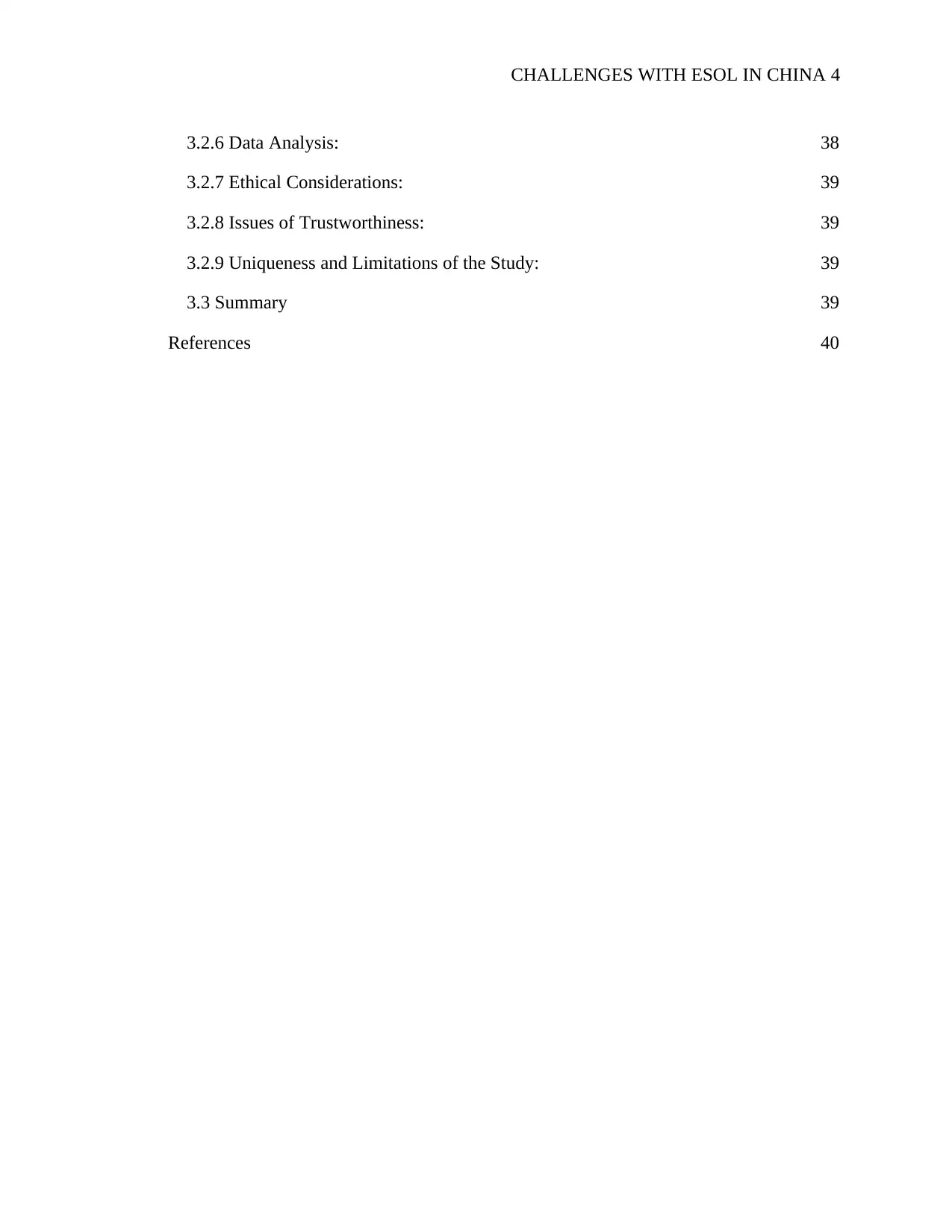
CHALLENGES WITH ESOL IN CHINA 4
3.2.6 Data Analysis: 38
3.2.7 Ethical Considerations: 39
3.2.8 Issues of Trustworthiness: 39
3.2.9 Uniqueness and Limitations of the Study: 39
3.3 Summary 39
References 40
3.2.6 Data Analysis: 38
3.2.7 Ethical Considerations: 39
3.2.8 Issues of Trustworthiness: 39
3.2.9 Uniqueness and Limitations of the Study: 39
3.3 Summary 39
References 40
Secure Best Marks with AI Grader
Need help grading? Try our AI Grader for instant feedback on your assignments.
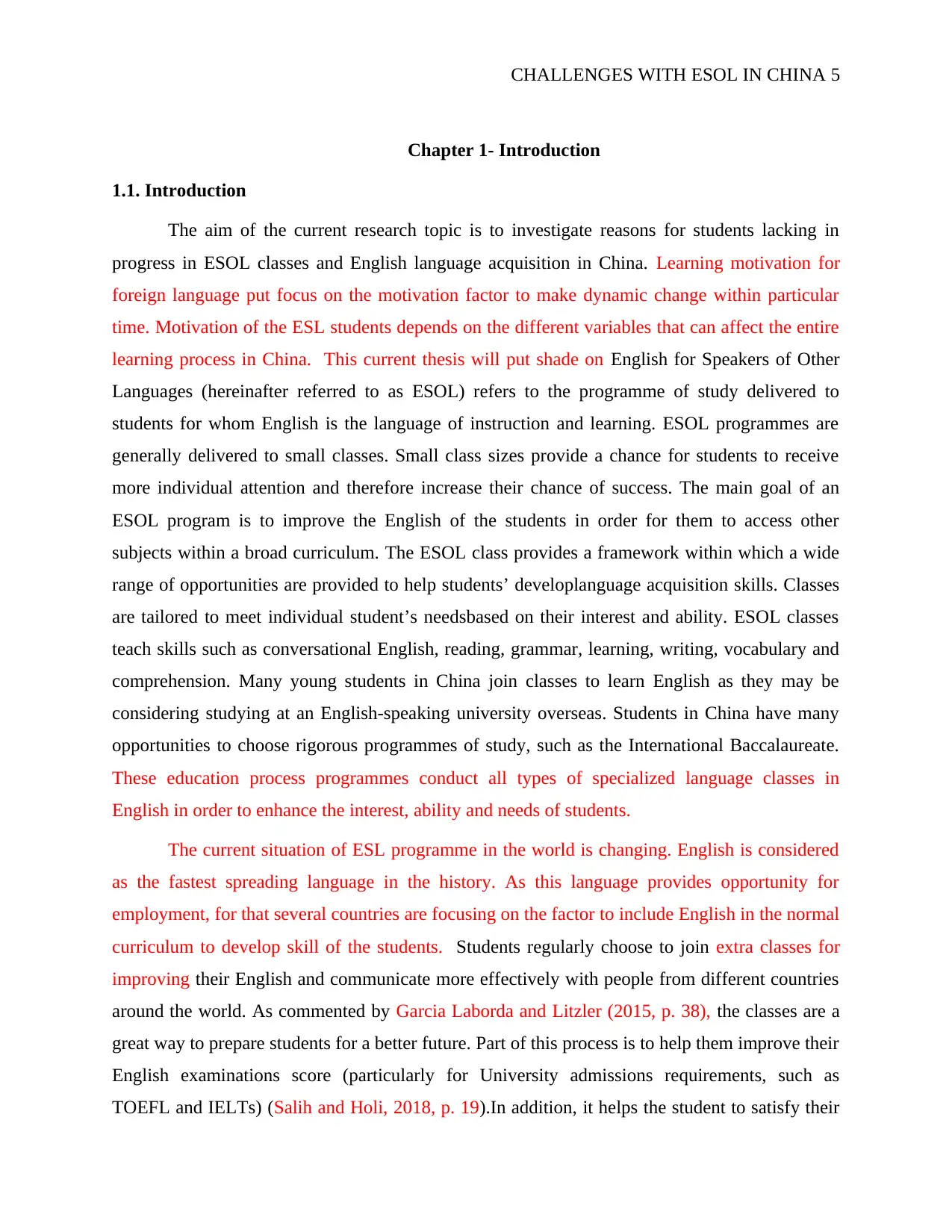
CHALLENGES WITH ESOL IN CHINA 5
Chapter 1- Introduction
1.1. Introduction
The aim of the current research topic is to investigate reasons for students lacking in
progress in ESOL classes and English language acquisition in China. Learning motivation for
foreign language put focus on the motivation factor to make dynamic change within particular
time. Motivation of the ESL students depends on the different variables that can affect the entire
learning process in China. This current thesis will put shade on English for Speakers of Other
Languages (hereinafter referred to as ESOL) refers to the programme of study delivered to
students for whom English is the language of instruction and learning. ESOL programmes are
generally delivered to small classes. Small class sizes provide a chance for students to receive
more individual attention and therefore increase their chance of success. The main goal of an
ESOL program is to improve the English of the students in order for them to access other
subjects within a broad curriculum. The ESOL class provides a framework within which a wide
range of opportunities are provided to help students’ developlanguage acquisition skills. Classes
are tailored to meet individual student’s needsbased on their interest and ability. ESOL classes
teach skills such as conversational English, reading, grammar, learning, writing, vocabulary and
comprehension. Many young students in China join classes to learn English as they may be
considering studying at an English-speaking university overseas. Students in China have many
opportunities to choose rigorous programmes of study, such as the International Baccalaureate.
These education process programmes conduct all types of specialized language classes in
English in order to enhance the interest, ability and needs of students.
The current situation of ESL programme in the world is changing. English is considered
as the fastest spreading language in the history. As this language provides opportunity for
employment, for that several countries are focusing on the factor to include English in the normal
curriculum to develop skill of the students. Students regularly choose to join extra classes for
improving their English and communicate more effectively with people from different countries
around the world. As commented by Garcia Laborda and Litzler (2015, p. 38), the classes are a
great way to prepare students for a better future. Part of this process is to help them improve their
English examinations score (particularly for University admissions requirements, such as
TOEFL and IELTs) (Salih and Holi, 2018, p. 19).In addition, it helps the student to satisfy their
Chapter 1- Introduction
1.1. Introduction
The aim of the current research topic is to investigate reasons for students lacking in
progress in ESOL classes and English language acquisition in China. Learning motivation for
foreign language put focus on the motivation factor to make dynamic change within particular
time. Motivation of the ESL students depends on the different variables that can affect the entire
learning process in China. This current thesis will put shade on English for Speakers of Other
Languages (hereinafter referred to as ESOL) refers to the programme of study delivered to
students for whom English is the language of instruction and learning. ESOL programmes are
generally delivered to small classes. Small class sizes provide a chance for students to receive
more individual attention and therefore increase their chance of success. The main goal of an
ESOL program is to improve the English of the students in order for them to access other
subjects within a broad curriculum. The ESOL class provides a framework within which a wide
range of opportunities are provided to help students’ developlanguage acquisition skills. Classes
are tailored to meet individual student’s needsbased on their interest and ability. ESOL classes
teach skills such as conversational English, reading, grammar, learning, writing, vocabulary and
comprehension. Many young students in China join classes to learn English as they may be
considering studying at an English-speaking university overseas. Students in China have many
opportunities to choose rigorous programmes of study, such as the International Baccalaureate.
These education process programmes conduct all types of specialized language classes in
English in order to enhance the interest, ability and needs of students.
The current situation of ESL programme in the world is changing. English is considered
as the fastest spreading language in the history. As this language provides opportunity for
employment, for that several countries are focusing on the factor to include English in the normal
curriculum to develop skill of the students. Students regularly choose to join extra classes for
improving their English and communicate more effectively with people from different countries
around the world. As commented by Garcia Laborda and Litzler (2015, p. 38), the classes are a
great way to prepare students for a better future. Part of this process is to help them improve their
English examinations score (particularly for University admissions requirements, such as
TOEFL and IELTs) (Salih and Holi, 2018, p. 19).In addition, it helps the student to satisfy their
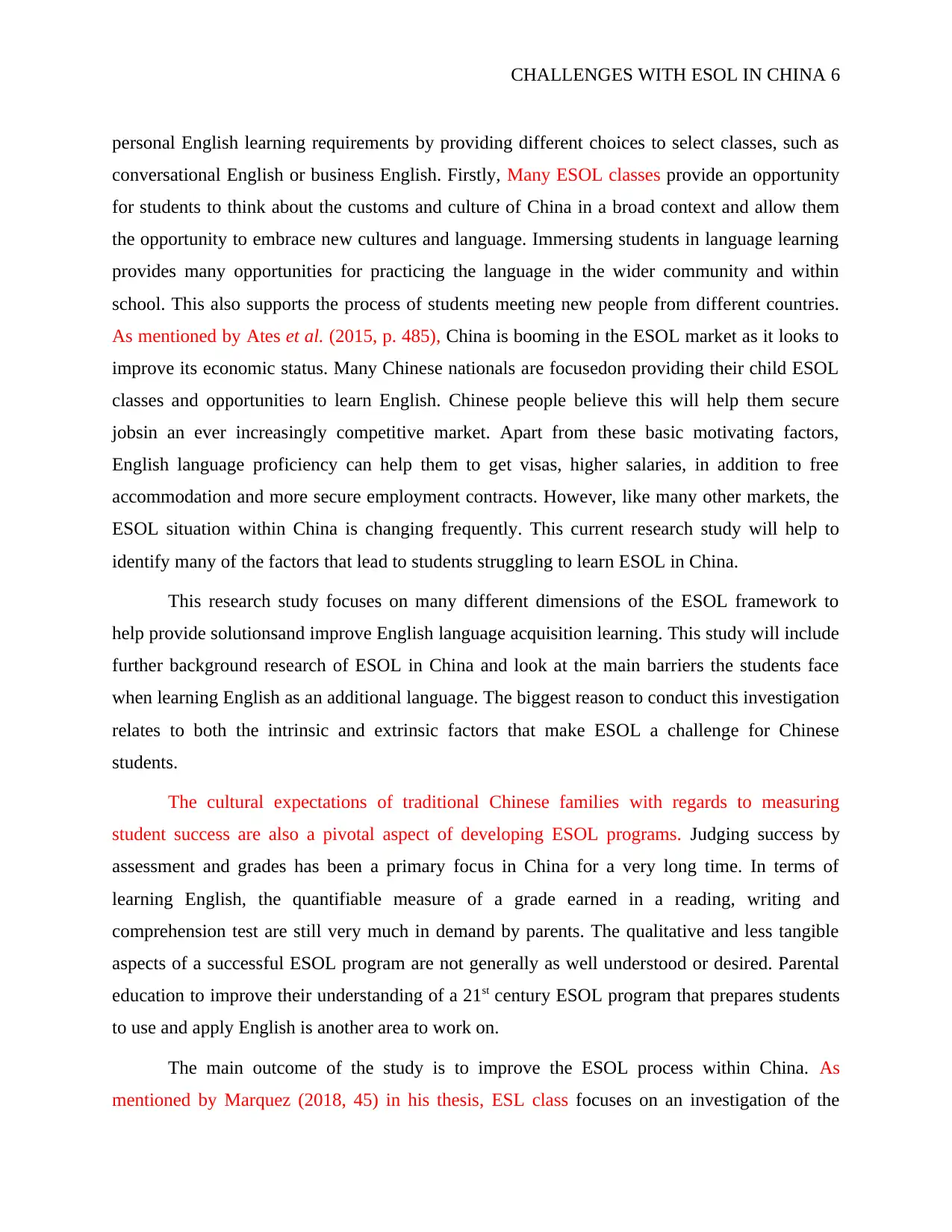
CHALLENGES WITH ESOL IN CHINA 6
personal English learning requirements by providing different choices to select classes, such as
conversational English or business English. Firstly, Many ESOL classes provide an opportunity
for students to think about the customs and culture of China in a broad context and allow them
the opportunity to embrace new cultures and language. Immersing students in language learning
provides many opportunities for practicing the language in the wider community and within
school. This also supports the process of students meeting new people from different countries.
As mentioned by Ates et al. (2015, p. 485), China is booming in the ESOL market as it looks to
improve its economic status. Many Chinese nationals are focusedon providing their child ESOL
classes and opportunities to learn English. Chinese people believe this will help them secure
jobsin an ever increasingly competitive market. Apart from these basic motivating factors,
English language proficiency can help them to get visas, higher salaries, in addition to free
accommodation and more secure employment contracts. However, like many other markets, the
ESOL situation within China is changing frequently. This current research study will help to
identify many of the factors that lead to students struggling to learn ESOL in China.
This research study focuses on many different dimensions of the ESOL framework to
help provide solutionsand improve English language acquisition learning. This study will include
further background research of ESOL in China and look at the main barriers the students face
when learning English as an additional language. The biggest reason to conduct this investigation
relates to both the intrinsic and extrinsic factors that make ESOL a challenge for Chinese
students.
The cultural expectations of traditional Chinese families with regards to measuring
student success are also a pivotal aspect of developing ESOL programs. Judging success by
assessment and grades has been a primary focus in China for a very long time. In terms of
learning English, the quantifiable measure of a grade earned in a reading, writing and
comprehension test are still very much in demand by parents. The qualitative and less tangible
aspects of a successful ESOL program are not generally as well understood or desired. Parental
education to improve their understanding of a 21st century ESOL program that prepares students
to use and apply English is another area to work on.
The main outcome of the study is to improve the ESOL process within China. As
mentioned by Marquez (2018, 45) in his thesis, ESL class focuses on an investigation of the
personal English learning requirements by providing different choices to select classes, such as
conversational English or business English. Firstly, Many ESOL classes provide an opportunity
for students to think about the customs and culture of China in a broad context and allow them
the opportunity to embrace new cultures and language. Immersing students in language learning
provides many opportunities for practicing the language in the wider community and within
school. This also supports the process of students meeting new people from different countries.
As mentioned by Ates et al. (2015, p. 485), China is booming in the ESOL market as it looks to
improve its economic status. Many Chinese nationals are focusedon providing their child ESOL
classes and opportunities to learn English. Chinese people believe this will help them secure
jobsin an ever increasingly competitive market. Apart from these basic motivating factors,
English language proficiency can help them to get visas, higher salaries, in addition to free
accommodation and more secure employment contracts. However, like many other markets, the
ESOL situation within China is changing frequently. This current research study will help to
identify many of the factors that lead to students struggling to learn ESOL in China.
This research study focuses on many different dimensions of the ESOL framework to
help provide solutionsand improve English language acquisition learning. This study will include
further background research of ESOL in China and look at the main barriers the students face
when learning English as an additional language. The biggest reason to conduct this investigation
relates to both the intrinsic and extrinsic factors that make ESOL a challenge for Chinese
students.
The cultural expectations of traditional Chinese families with regards to measuring
student success are also a pivotal aspect of developing ESOL programs. Judging success by
assessment and grades has been a primary focus in China for a very long time. In terms of
learning English, the quantifiable measure of a grade earned in a reading, writing and
comprehension test are still very much in demand by parents. The qualitative and less tangible
aspects of a successful ESOL program are not generally as well understood or desired. Parental
education to improve their understanding of a 21st century ESOL program that prepares students
to use and apply English is another area to work on.
The main outcome of the study is to improve the ESOL process within China. As
mentioned by Marquez (2018, 45) in his thesis, ESL class focuses on an investigation of the
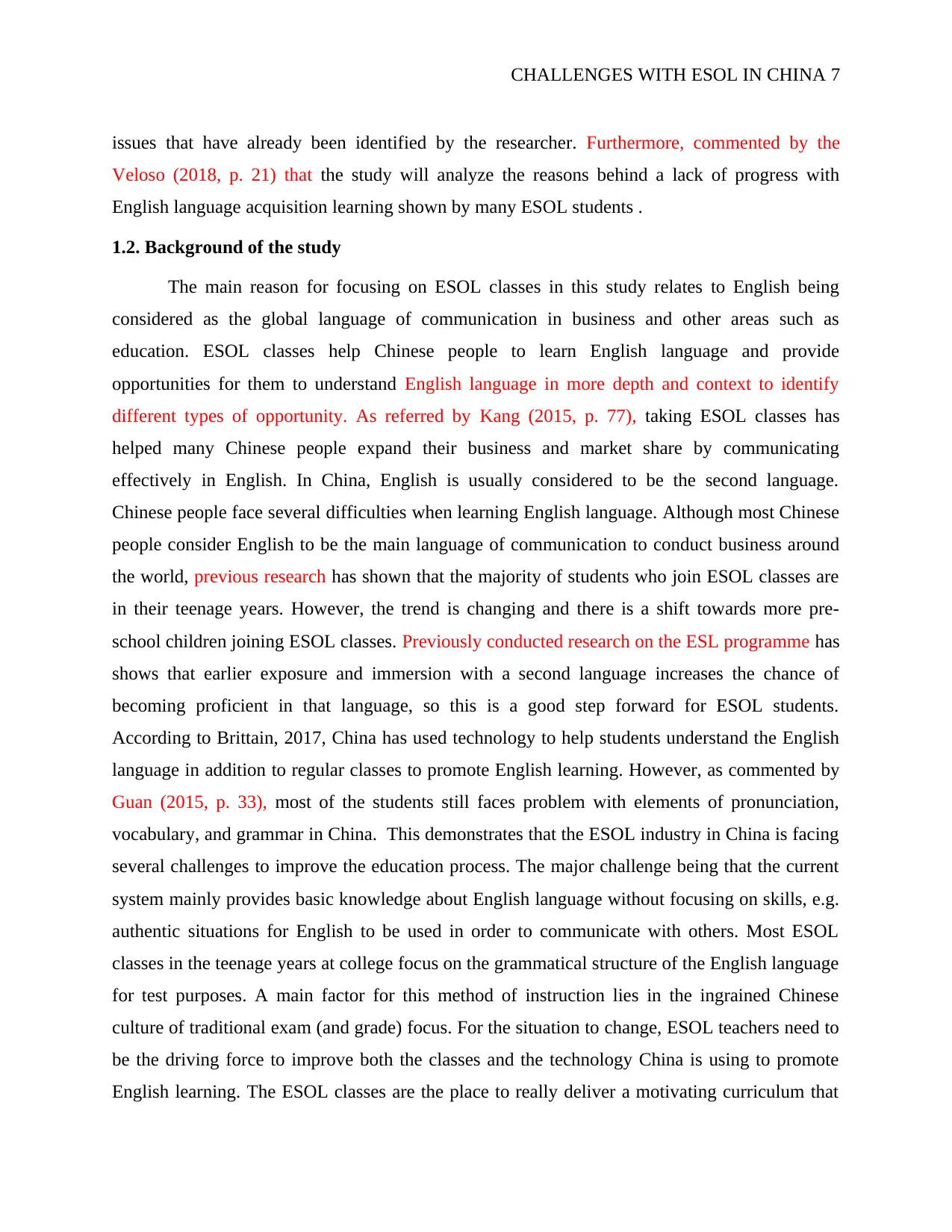
CHALLENGES WITH ESOL IN CHINA 7
issues that have already been identified by the researcher. Furthermore, commented by the
Veloso (2018, p. 21) that the study will analyze the reasons behind a lack of progress with
English language acquisition learning shown by many ESOL students .
1.2. Background of the study
The main reason for focusing on ESOL classes in this study relates to English being
considered as the global language of communication in business and other areas such as
education. ESOL classes help Chinese people to learn English language and provide
opportunities for them to understand English language in more depth and context to identify
different types of opportunity. As referred by Kang (2015, p. 77), taking ESOL classes has
helped many Chinese people expand their business and market share by communicating
effectively in English. In China, English is usually considered to be the second language.
Chinese people face several difficulties when learning English language. Although most Chinese
people consider English to be the main language of communication to conduct business around
the world, previous research has shown that the majority of students who join ESOL classes are
in their teenage years. However, the trend is changing and there is a shift towards more pre-
school children joining ESOL classes. Previously conducted research on the ESL programme has
shows that earlier exposure and immersion with a second language increases the chance of
becoming proficient in that language, so this is a good step forward for ESOL students.
According to Brittain, 2017, China has used technology to help students understand the English
language in addition to regular classes to promote English learning. However, as commented by
Guan (2015, p. 33), most of the students still faces problem with elements of pronunciation,
vocabulary, and grammar in China. This demonstrates that the ESOL industry in China is facing
several challenges to improve the education process. The major challenge being that the current
system mainly provides basic knowledge about English language without focusing on skills, e.g.
authentic situations for English to be used in order to communicate with others. Most ESOL
classes in the teenage years at college focus on the grammatical structure of the English language
for test purposes. A main factor for this method of instruction lies in the ingrained Chinese
culture of traditional exam (and grade) focus. For the situation to change, ESOL teachers need to
be the driving force to improve both the classes and the technology China is using to promote
English learning. The ESOL classes are the place to really deliver a motivating curriculum that
issues that have already been identified by the researcher. Furthermore, commented by the
Veloso (2018, p. 21) that the study will analyze the reasons behind a lack of progress with
English language acquisition learning shown by many ESOL students .
1.2. Background of the study
The main reason for focusing on ESOL classes in this study relates to English being
considered as the global language of communication in business and other areas such as
education. ESOL classes help Chinese people to learn English language and provide
opportunities for them to understand English language in more depth and context to identify
different types of opportunity. As referred by Kang (2015, p. 77), taking ESOL classes has
helped many Chinese people expand their business and market share by communicating
effectively in English. In China, English is usually considered to be the second language.
Chinese people face several difficulties when learning English language. Although most Chinese
people consider English to be the main language of communication to conduct business around
the world, previous research has shown that the majority of students who join ESOL classes are
in their teenage years. However, the trend is changing and there is a shift towards more pre-
school children joining ESOL classes. Previously conducted research on the ESL programme has
shows that earlier exposure and immersion with a second language increases the chance of
becoming proficient in that language, so this is a good step forward for ESOL students.
According to Brittain, 2017, China has used technology to help students understand the English
language in addition to regular classes to promote English learning. However, as commented by
Guan (2015, p. 33), most of the students still faces problem with elements of pronunciation,
vocabulary, and grammar in China. This demonstrates that the ESOL industry in China is facing
several challenges to improve the education process. The major challenge being that the current
system mainly provides basic knowledge about English language without focusing on skills, e.g.
authentic situations for English to be used in order to communicate with others. Most ESOL
classes in the teenage years at college focus on the grammatical structure of the English language
for test purposes. A main factor for this method of instruction lies in the ingrained Chinese
culture of traditional exam (and grade) focus. For the situation to change, ESOL teachers need to
be the driving force to improve both the classes and the technology China is using to promote
English learning. The ESOL classes are the place to really deliver a motivating curriculum that
Paraphrase This Document
Need a fresh take? Get an instant paraphrase of this document with our AI Paraphraser

CHALLENGES WITH ESOL IN CHINA 8
engages students and improves their authentic use of English in situations that will help them
communicate effectively in the Global context.
1.3. Problem statement
Chen & Wright (2017), highlight the problem of a general lack of progress in language
acquisition learning for the betterment of the students. There are a number of key factors that are
negatively impacting the success of ESOL programs in China. The sheer scale of China’s
population makes it difficult to provide a consistent approach to English acquisition learning in
the classroom. As commented by the Nunan (2015, p. 19), the traditional Chinese methods of
teaching and learning of English in local schools has not been particularly effective and,
crucially, has not modeled the most effective, engaging and successful ESOL teaching methods
(MacWhinney, 2014, p. 21). As a result, many of the current teachers of English within China
are the product of this rote learning style which means they are often teaching English in the
same way they learned it (Valdés, 2014, p. 49). This helps the students of China to memorize the
English language through repeated class. Rote learning mainly provides associative and active
learning of English.
Zhang (2016), supports this observation and highlights the problem of many ESOL
teachers not being qualified enough to make the student understand the language properly.
Unqualified teachers are a significant problem that has been overlooked by China. As mentioned
by Looney and Lusin (2015, p. 1299), the process of developing and training more qualified
ESOL teachers who possess the right skills and attributes to be effective educators will take
significant time and investment for China.
The sheer scale of the numbers involved in the ESOL movement in China means that it
will take time and coordination to resolve. Another factor to consider is the demand for ESOL
seems to be more than the supply of effectively trained teachers available. Larger class sizes and
a high turnover of staff lead to less efficiency and slower progress for students. Add in the short-
term solutions that schools frequently take. As referred by Syder and Pawley (2014, p. 203),
replacing teachers on a like for like basis (inconsistently trained teachers with varying skill
levels), as well as poorly equipped learning environments (as highlighted by Yeh, Joshi, & Ji,
2015).
engages students and improves their authentic use of English in situations that will help them
communicate effectively in the Global context.
1.3. Problem statement
Chen & Wright (2017), highlight the problem of a general lack of progress in language
acquisition learning for the betterment of the students. There are a number of key factors that are
negatively impacting the success of ESOL programs in China. The sheer scale of China’s
population makes it difficult to provide a consistent approach to English acquisition learning in
the classroom. As commented by the Nunan (2015, p. 19), the traditional Chinese methods of
teaching and learning of English in local schools has not been particularly effective and,
crucially, has not modeled the most effective, engaging and successful ESOL teaching methods
(MacWhinney, 2014, p. 21). As a result, many of the current teachers of English within China
are the product of this rote learning style which means they are often teaching English in the
same way they learned it (Valdés, 2014, p. 49). This helps the students of China to memorize the
English language through repeated class. Rote learning mainly provides associative and active
learning of English.
Zhang (2016), supports this observation and highlights the problem of many ESOL
teachers not being qualified enough to make the student understand the language properly.
Unqualified teachers are a significant problem that has been overlooked by China. As mentioned
by Looney and Lusin (2015, p. 1299), the process of developing and training more qualified
ESOL teachers who possess the right skills and attributes to be effective educators will take
significant time and investment for China.
The sheer scale of the numbers involved in the ESOL movement in China means that it
will take time and coordination to resolve. Another factor to consider is the demand for ESOL
seems to be more than the supply of effectively trained teachers available. Larger class sizes and
a high turnover of staff lead to less efficiency and slower progress for students. Add in the short-
term solutions that schools frequently take. As referred by Syder and Pawley (2014, p. 203),
replacing teachers on a like for like basis (inconsistently trained teachers with varying skill
levels), as well as poorly equipped learning environments (as highlighted by Yeh, Joshi, & Ji,
2015).

CHALLENGES WITH ESOL IN CHINA 9
Apart from that, use of home language within classesand the picture of ESOL in China
remains complex and disjointed (Porter, 2017, p. 211).
Underneath all the challenges and issues discussed above, there is the fundamental matter
of student motivation. The reason for a student’s motivation is to study English in the first place
is a critical factor in their success. Without a level of intrinsic motivation and desire to learn and
use English, progress will always be limited no matter who teaches the lesson, where and when.
As I mentioned in the introduction, the cultural expectation within China places a high
premium on grades. Under qualified teachers, high class sizes, use of mother tongue language
within the classroom, high staff turnover (who often have inconsistent approaches to teaching
ESOL) and many other factors means that student grades are unlikely to meet the expectations
placed on the student by parents and family. Student motivation for grades is very reliant on
parent expectation and pressure in China.
MacKinnon et al. 2017, talk about making the ESOL structure and provision more
effective to help China grow economically and improve the lives of the people who live there. It
is very difficult for academic institutions to really help the students understand this big picture of
China in its current global position.
As mentioned by Ramirez et al. (2011), academic institutions need to focus on the
financial aspects of ESOL class provision. Many students face difficulties with paying and being
able to afford ESOL (or any other second language learning) classes. The study system of China
has not still managed to include English in the normal curriculum. For that, learner requires to
pay extra amount to learn English in context of China. Additionally, paying for the English
classes is creating difficulty for the students.
As it have explained in this section, the current provision and ESOL structure within
China is in real need of consistency and investment as well as a change of mindset in terms of
how ESOL is perceived. ESOL is not just another exam grade to be chased, it is a language skill
that offers great opportunities for students to change their lives and so the economy of China.
1.4. Aim of the research
The aim of current research topic is to investigate reasons why students lack progress in
ESOL classes and English language acquisition in China.
Apart from that, use of home language within classesand the picture of ESOL in China
remains complex and disjointed (Porter, 2017, p. 211).
Underneath all the challenges and issues discussed above, there is the fundamental matter
of student motivation. The reason for a student’s motivation is to study English in the first place
is a critical factor in their success. Without a level of intrinsic motivation and desire to learn and
use English, progress will always be limited no matter who teaches the lesson, where and when.
As I mentioned in the introduction, the cultural expectation within China places a high
premium on grades. Under qualified teachers, high class sizes, use of mother tongue language
within the classroom, high staff turnover (who often have inconsistent approaches to teaching
ESOL) and many other factors means that student grades are unlikely to meet the expectations
placed on the student by parents and family. Student motivation for grades is very reliant on
parent expectation and pressure in China.
MacKinnon et al. 2017, talk about making the ESOL structure and provision more
effective to help China grow economically and improve the lives of the people who live there. It
is very difficult for academic institutions to really help the students understand this big picture of
China in its current global position.
As mentioned by Ramirez et al. (2011), academic institutions need to focus on the
financial aspects of ESOL class provision. Many students face difficulties with paying and being
able to afford ESOL (or any other second language learning) classes. The study system of China
has not still managed to include English in the normal curriculum. For that, learner requires to
pay extra amount to learn English in context of China. Additionally, paying for the English
classes is creating difficulty for the students.
As it have explained in this section, the current provision and ESOL structure within
China is in real need of consistency and investment as well as a change of mindset in terms of
how ESOL is perceived. ESOL is not just another exam grade to be chased, it is a language skill
that offers great opportunities for students to change their lives and so the economy of China.
1.4. Aim of the research
The aim of current research topic is to investigate reasons why students lack progress in
ESOL classes and English language acquisition in China.
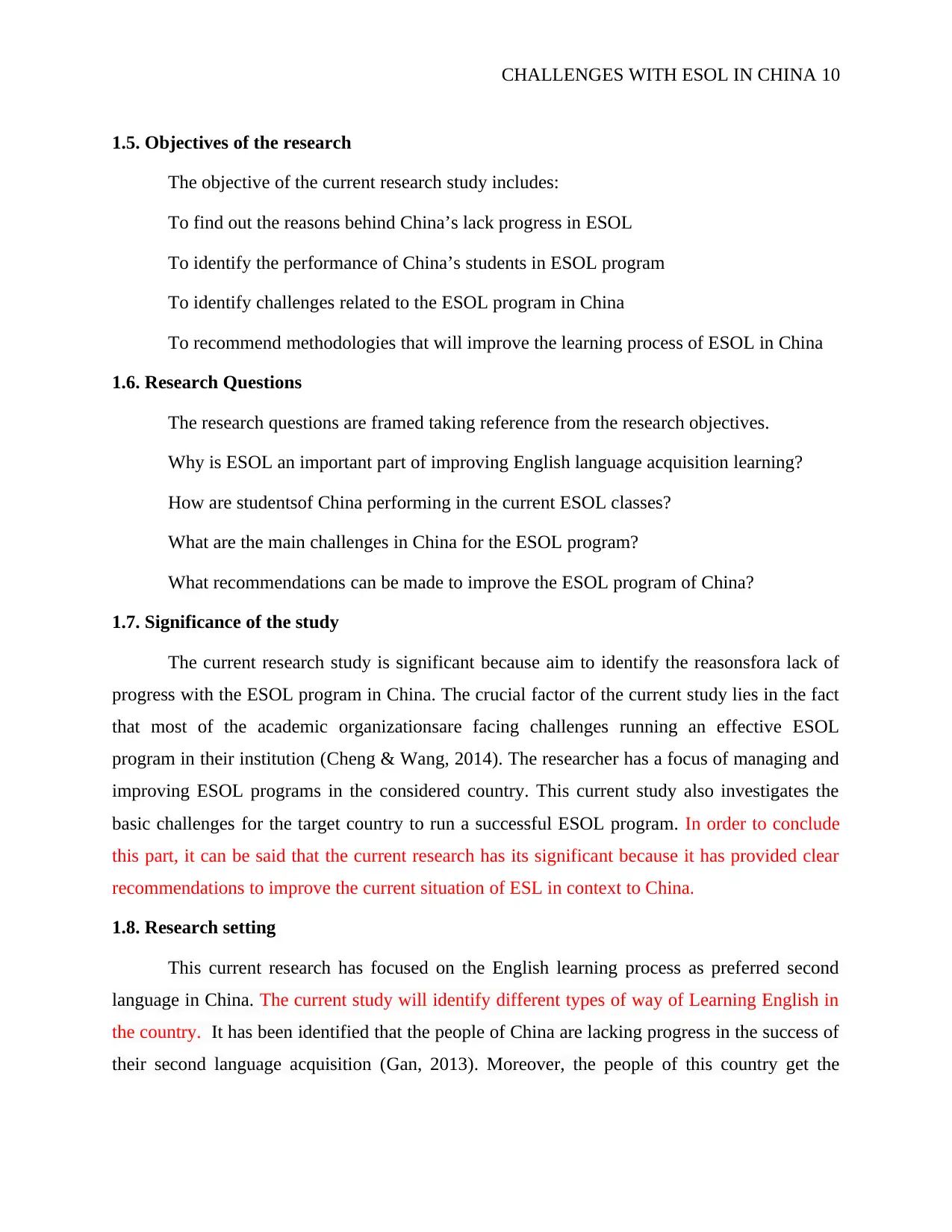
CHALLENGES WITH ESOL IN CHINA 10
1.5. Objectives of the research
The objective of the current research study includes:
To find out the reasons behind China’s lack progress in ESOL
To identify the performance of China’s students in ESOL program
To identify challenges related to the ESOL program in China
To recommend methodologies that will improve the learning process of ESOL in China
1.6. Research Questions
The research questions are framed taking reference from the research objectives.
Why is ESOL an important part of improving English language acquisition learning?
How are studentsof China performing in the current ESOL classes?
What are the main challenges in China for the ESOL program?
What recommendations can be made to improve the ESOL program of China?
1.7. Significance of the study
The current research study is significant because aim to identify the reasonsfora lack of
progress with the ESOL program in China. The crucial factor of the current study lies in the fact
that most of the academic organizationsare facing challenges running an effective ESOL
program in their institution (Cheng & Wang, 2014). The researcher has a focus of managing and
improving ESOL programs in the considered country. This current study also investigates the
basic challenges for the target country to run a successful ESOL program. In order to conclude
this part, it can be said that the current research has its significant because it has provided clear
recommendations to improve the current situation of ESL in context to China.
1.8. Research setting
This current research has focused on the English learning process as preferred second
language in China. The current study will identify different types of way of Learning English in
the country. It has been identified that the people of China are lacking progress in the success of
their second language acquisition (Gan, 2013). Moreover, the people of this country get the
1.5. Objectives of the research
The objective of the current research study includes:
To find out the reasons behind China’s lack progress in ESOL
To identify the performance of China’s students in ESOL program
To identify challenges related to the ESOL program in China
To recommend methodologies that will improve the learning process of ESOL in China
1.6. Research Questions
The research questions are framed taking reference from the research objectives.
Why is ESOL an important part of improving English language acquisition learning?
How are studentsof China performing in the current ESOL classes?
What are the main challenges in China for the ESOL program?
What recommendations can be made to improve the ESOL program of China?
1.7. Significance of the study
The current research study is significant because aim to identify the reasonsfora lack of
progress with the ESOL program in China. The crucial factor of the current study lies in the fact
that most of the academic organizationsare facing challenges running an effective ESOL
program in their institution (Cheng & Wang, 2014). The researcher has a focus of managing and
improving ESOL programs in the considered country. This current study also investigates the
basic challenges for the target country to run a successful ESOL program. In order to conclude
this part, it can be said that the current research has its significant because it has provided clear
recommendations to improve the current situation of ESL in context to China.
1.8. Research setting
This current research has focused on the English learning process as preferred second
language in China. The current study will identify different types of way of Learning English in
the country. It has been identified that the people of China are lacking progress in the success of
their second language acquisition (Gan, 2013). Moreover, the people of this country get the
Secure Best Marks with AI Grader
Need help grading? Try our AI Grader for instant feedback on your assignments.
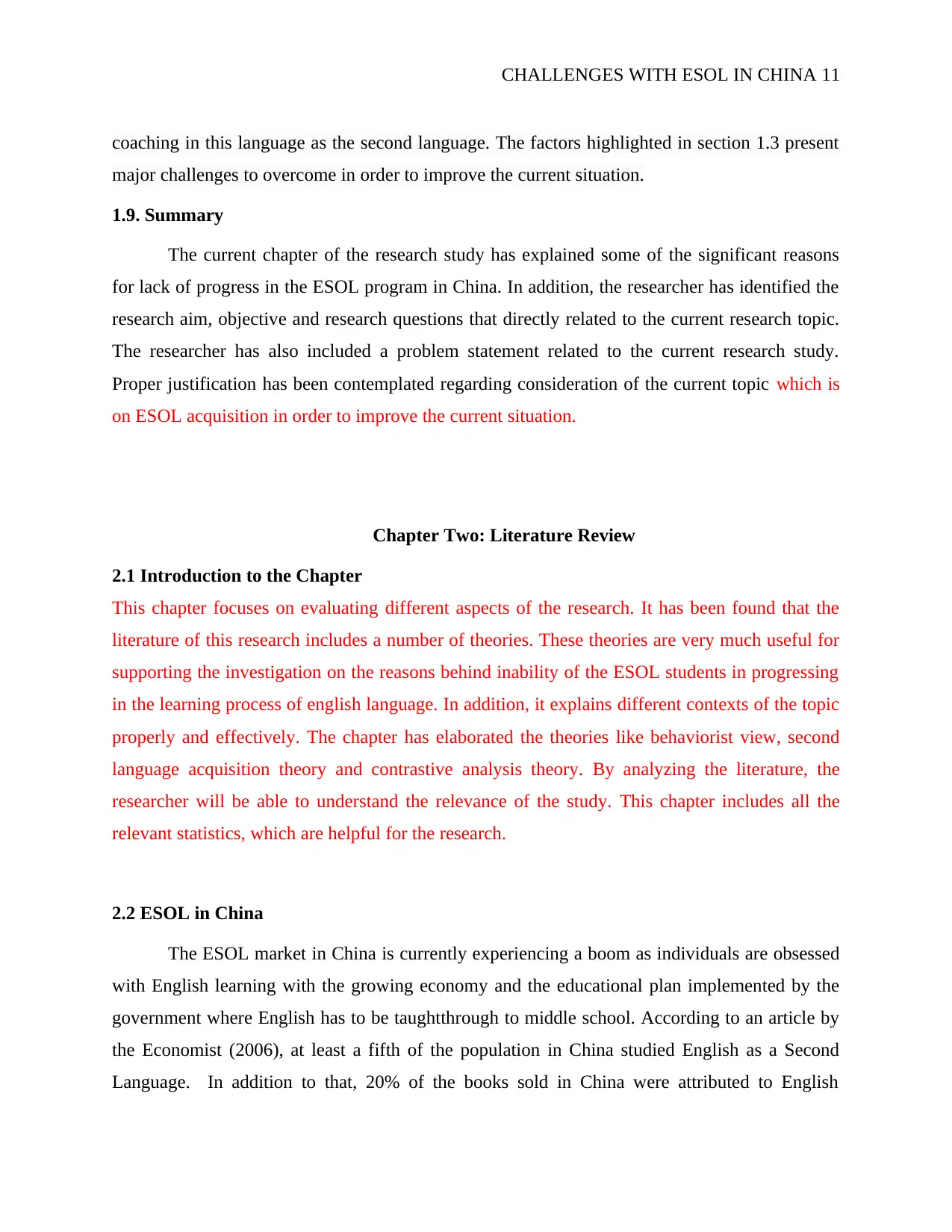
CHALLENGES WITH ESOL IN CHINA 11
coaching in this language as the second language. The factors highlighted in section 1.3 present
major challenges to overcome in order to improve the current situation.
1.9. Summary
The current chapter of the research study has explained some of the significant reasons
for lack of progress in the ESOL program in China. In addition, the researcher has identified the
research aim, objective and research questions that directly related to the current research topic.
The researcher has also included a problem statement related to the current research study.
Proper justification has been contemplated regarding consideration of the current topic which is
on ESOL acquisition in order to improve the current situation.
Chapter Two: Literature Review
2.1 Introduction to the Chapter
This chapter focuses on evaluating different aspects of the research. It has been found that the
literature of this research includes a number of theories. These theories are very much useful for
supporting the investigation on the reasons behind inability of the ESOL students in progressing
in the learning process of english language. In addition, it explains different contexts of the topic
properly and effectively. The chapter has elaborated the theories like behaviorist view, second
language acquisition theory and contrastive analysis theory. By analyzing the literature, the
researcher will be able to understand the relevance of the study. This chapter includes all the
relevant statistics, which are helpful for the research.
2.2 ESOL in China
The ESOL market in China is currently experiencing a boom as individuals are obsessed
with English learning with the growing economy and the educational plan implemented by the
government where English has to be taughtthrough to middle school. According to an article by
the Economist (2006), at least a fifth of the population in China studied English as a Second
Language. In addition to that, 20% of the books sold in China were attributed to English
coaching in this language as the second language. The factors highlighted in section 1.3 present
major challenges to overcome in order to improve the current situation.
1.9. Summary
The current chapter of the research study has explained some of the significant reasons
for lack of progress in the ESOL program in China. In addition, the researcher has identified the
research aim, objective and research questions that directly related to the current research topic.
The researcher has also included a problem statement related to the current research study.
Proper justification has been contemplated regarding consideration of the current topic which is
on ESOL acquisition in order to improve the current situation.
Chapter Two: Literature Review
2.1 Introduction to the Chapter
This chapter focuses on evaluating different aspects of the research. It has been found that the
literature of this research includes a number of theories. These theories are very much useful for
supporting the investigation on the reasons behind inability of the ESOL students in progressing
in the learning process of english language. In addition, it explains different contexts of the topic
properly and effectively. The chapter has elaborated the theories like behaviorist view, second
language acquisition theory and contrastive analysis theory. By analyzing the literature, the
researcher will be able to understand the relevance of the study. This chapter includes all the
relevant statistics, which are helpful for the research.
2.2 ESOL in China
The ESOL market in China is currently experiencing a boom as individuals are obsessed
with English learning with the growing economy and the educational plan implemented by the
government where English has to be taughtthrough to middle school. According to an article by
the Economist (2006), at least a fifth of the population in China studied English as a Second
Language. In addition to that, 20% of the books sold in China were attributed to English

CHALLENGES WITH ESOL IN CHINA 12
language (Xu, 2012). As at 2013, the number of students learning English in the Chinese context
was estimated to be 300,000 individuals. With respect to matters relating to net worth of the
English –training industry, it was estimated to account for $4.5 billion with the prospects
expected to expand at a rate of 12% to 15%. The evidence of the market lies in the Wall Street
English whereby the largest English training institution in China was seeking an investment of
$15.6 million to expand its services to other regions such as Chongqing, Wuhan and Chengdu.
The surging number has attracted ESOL learners as well as teachers in response to the changing
culture of the population (Meer and Modood, 2012).
In the early days, ESOL students in China were mostly adults. However, the trends is
changing as preschooler as young as 4years old are introduced to the subject. Besides, public
schools have revised their approach to introducing students to ESOL from 12 to 9 years. Due to
the importance of English language, households spend over half of their household income in
order to ensure their children are conversant with the language (Linville, 2015). In addition,the
ability to speak English fluently has been adopted by parents who wish to indicate their status to
their fellow neighbors or members of the community. English in China is regarded as a source of
prestige that is linked to knowledge or success.
At the core of the growing demand of ESOL lies technology. Technology has been
integrated in order to alter the English landscape in Chinese society. Interactive smart boards
have already been incorporated into Kindergarten English classrooms as early as 2006. This
technology allows the teachers to expose the students to various movies, songs, internet content
and other materials that are linked to English. Besides, adults are also exposed to free online
content that offers ESOL. The online platform uses culturally relevant materials and video clips
to enhance the learning process (Xu, 2012). The result of this improved technology is an increase
in the number of individuals seeking English lessons within the Chinese context. The implication
of this has been an increase in the use of technology to expand access to materials for all, whilst
at the same time at the lowest cost. As a consequence, more individuals have been interested in
ESOL. However, it can also pose as a danger to an early learner. The individual may access
content that makes it beyond his/her comprehension thus affecting his/her learning progress.
Furthermore,students tend to rely on translation, which can slow their English language
acquisition. Besides, in the initial classes, the individual requires an instructor to supervise him
language (Xu, 2012). As at 2013, the number of students learning English in the Chinese context
was estimated to be 300,000 individuals. With respect to matters relating to net worth of the
English –training industry, it was estimated to account for $4.5 billion with the prospects
expected to expand at a rate of 12% to 15%. The evidence of the market lies in the Wall Street
English whereby the largest English training institution in China was seeking an investment of
$15.6 million to expand its services to other regions such as Chongqing, Wuhan and Chengdu.
The surging number has attracted ESOL learners as well as teachers in response to the changing
culture of the population (Meer and Modood, 2012).
In the early days, ESOL students in China were mostly adults. However, the trends is
changing as preschooler as young as 4years old are introduced to the subject. Besides, public
schools have revised their approach to introducing students to ESOL from 12 to 9 years. Due to
the importance of English language, households spend over half of their household income in
order to ensure their children are conversant with the language (Linville, 2015). In addition,the
ability to speak English fluently has been adopted by parents who wish to indicate their status to
their fellow neighbors or members of the community. English in China is regarded as a source of
prestige that is linked to knowledge or success.
At the core of the growing demand of ESOL lies technology. Technology has been
integrated in order to alter the English landscape in Chinese society. Interactive smart boards
have already been incorporated into Kindergarten English classrooms as early as 2006. This
technology allows the teachers to expose the students to various movies, songs, internet content
and other materials that are linked to English. Besides, adults are also exposed to free online
content that offers ESOL. The online platform uses culturally relevant materials and video clips
to enhance the learning process (Xu, 2012). The result of this improved technology is an increase
in the number of individuals seeking English lessons within the Chinese context. The implication
of this has been an increase in the use of technology to expand access to materials for all, whilst
at the same time at the lowest cost. As a consequence, more individuals have been interested in
ESOL. However, it can also pose as a danger to an early learner. The individual may access
content that makes it beyond his/her comprehension thus affecting his/her learning progress.
Furthermore,students tend to rely on translation, which can slow their English language
acquisition. Besides, in the initial classes, the individual requires an instructor to supervise him
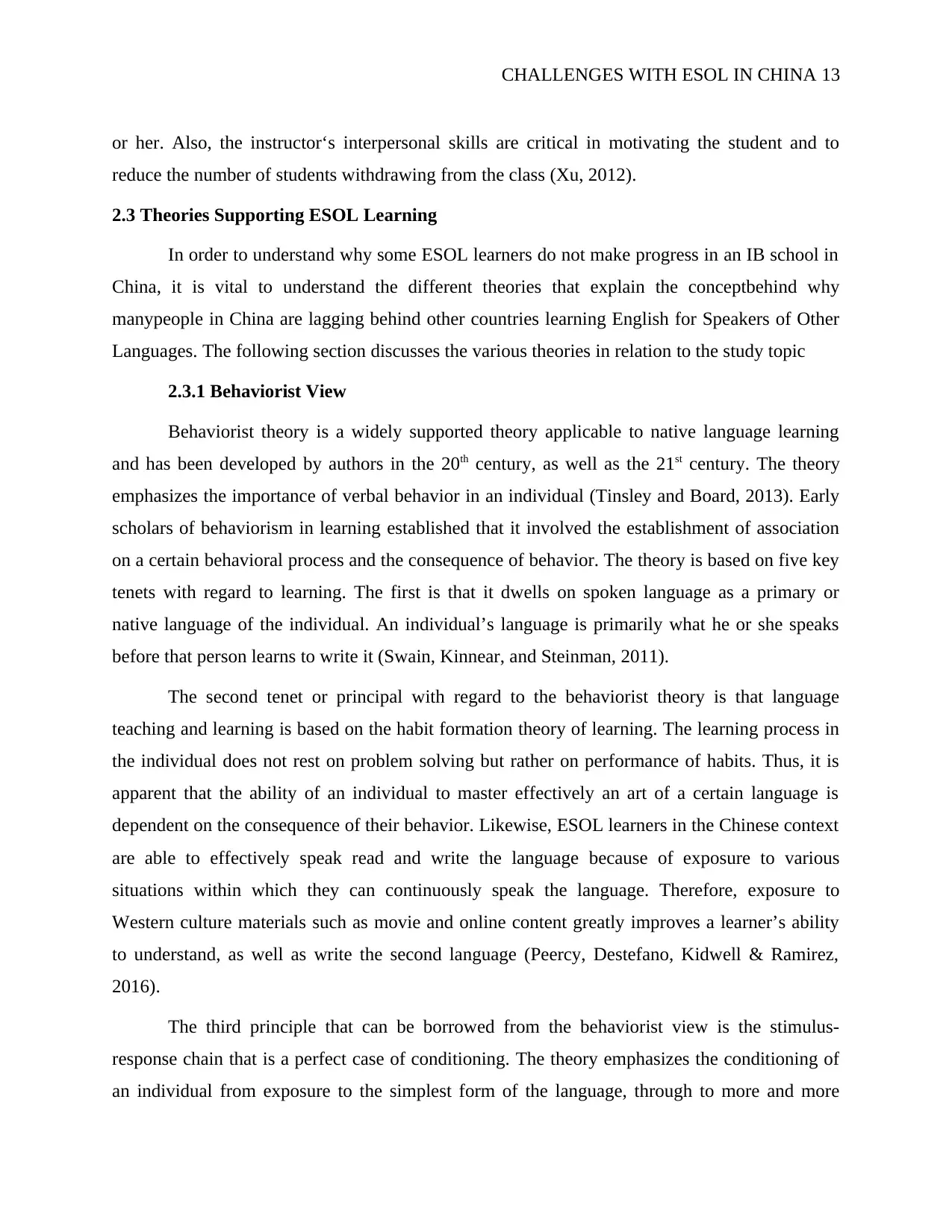
CHALLENGES WITH ESOL IN CHINA 13
or her. Also, the instructor‘s interpersonal skills are critical in motivating the student and to
reduce the number of students withdrawing from the class (Xu, 2012).
2.3 Theories Supporting ESOL Learning
In order to understand why some ESOL learners do not make progress in an IB school in
China, it is vital to understand the different theories that explain the conceptbehind why
manypeople in China are lagging behind other countries learning English for Speakers of Other
Languages. The following section discusses the various theories in relation to the study topic
2.3.1 Behaviorist View
Behaviorist theory is a widely supported theory applicable to native language learning
and has been developed by authors in the 20th century, as well as the 21st century. The theory
emphasizes the importance of verbal behavior in an individual (Tinsley and Board, 2013). Early
scholars of behaviorism in learning established that it involved the establishment of association
on a certain behavioral process and the consequence of behavior. The theory is based on five key
tenets with regard to learning. The first is that it dwells on spoken language as a primary or
native language of the individual. An individual’s language is primarily what he or she speaks
before that person learns to write it (Swain, Kinnear, and Steinman, 2011).
The second tenet or principal with regard to the behaviorist theory is that language
teaching and learning is based on the habit formation theory of learning. The learning process in
the individual does not rest on problem solving but rather on performance of habits. Thus, it is
apparent that the ability of an individual to master effectively an art of a certain language is
dependent on the consequence of their behavior. Likewise, ESOL learners in the Chinese context
are able to effectively speak read and write the language because of exposure to various
situations within which they can continuously speak the language. Therefore, exposure to
Western culture materials such as movie and online content greatly improves a learner’s ability
to understand, as well as write the second language (Peercy, Destefano, Kidwell & Ramirez,
2016).
The third principle that can be borrowed from the behaviorist view is the stimulus-
response chain that is a perfect case of conditioning. The theory emphasizes the conditioning of
an individual from exposure to the simplest form of the language, through to more and more
or her. Also, the instructor‘s interpersonal skills are critical in motivating the student and to
reduce the number of students withdrawing from the class (Xu, 2012).
2.3 Theories Supporting ESOL Learning
In order to understand why some ESOL learners do not make progress in an IB school in
China, it is vital to understand the different theories that explain the conceptbehind why
manypeople in China are lagging behind other countries learning English for Speakers of Other
Languages. The following section discusses the various theories in relation to the study topic
2.3.1 Behaviorist View
Behaviorist theory is a widely supported theory applicable to native language learning
and has been developed by authors in the 20th century, as well as the 21st century. The theory
emphasizes the importance of verbal behavior in an individual (Tinsley and Board, 2013). Early
scholars of behaviorism in learning established that it involved the establishment of association
on a certain behavioral process and the consequence of behavior. The theory is based on five key
tenets with regard to learning. The first is that it dwells on spoken language as a primary or
native language of the individual. An individual’s language is primarily what he or she speaks
before that person learns to write it (Swain, Kinnear, and Steinman, 2011).
The second tenet or principal with regard to the behaviorist theory is that language
teaching and learning is based on the habit formation theory of learning. The learning process in
the individual does not rest on problem solving but rather on performance of habits. Thus, it is
apparent that the ability of an individual to master effectively an art of a certain language is
dependent on the consequence of their behavior. Likewise, ESOL learners in the Chinese context
are able to effectively speak read and write the language because of exposure to various
situations within which they can continuously speak the language. Therefore, exposure to
Western culture materials such as movie and online content greatly improves a learner’s ability
to understand, as well as write the second language (Peercy, Destefano, Kidwell & Ramirez,
2016).
The third principle that can be borrowed from the behaviorist view is the stimulus-
response chain that is a perfect case of conditioning. The theory emphasizes the conditioning of
an individual from exposure to the simplest form of the language, through to more and more
Paraphrase This Document
Need a fresh take? Get an instant paraphrase of this document with our AI Paraphraser
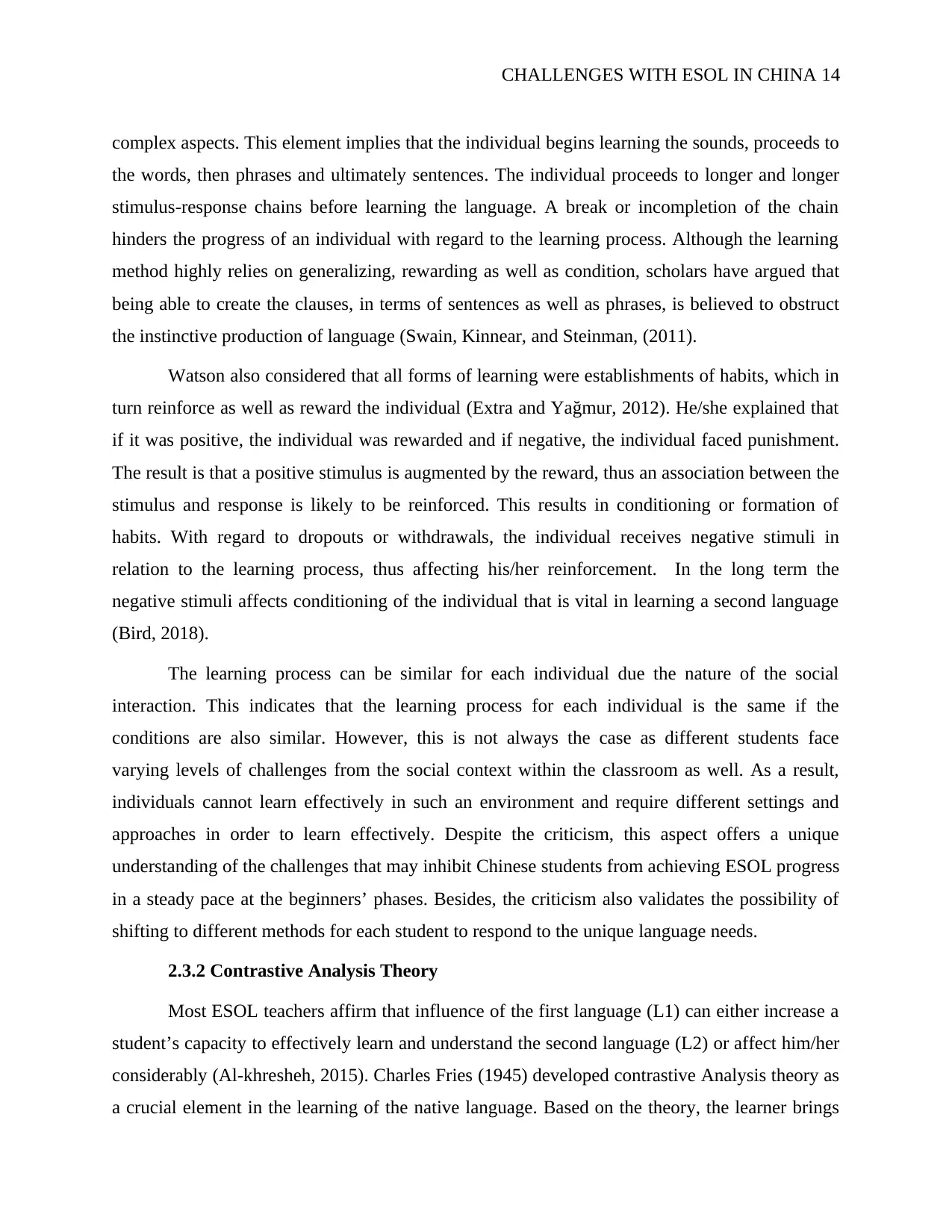
CHALLENGES WITH ESOL IN CHINA 14
complex aspects. This element implies that the individual begins learning the sounds, proceeds to
the words, then phrases and ultimately sentences. The individual proceeds to longer and longer
stimulus-response chains before learning the language. A break or incompletion of the chain
hinders the progress of an individual with regard to the learning process. Although the learning
method highly relies on generalizing, rewarding as well as condition, scholars have argued that
being able to create the clauses, in terms of sentences as well as phrases, is believed to obstruct
the instinctive production of language (Swain, Kinnear, and Steinman, (2011).
Watson also considered that all forms of learning were establishments of habits, which in
turn reinforce as well as reward the individual (Extra and Yağmur, 2012). He/she explained that
if it was positive, the individual was rewarded and if negative, the individual faced punishment.
The result is that a positive stimulus is augmented by the reward, thus an association between the
stimulus and response is likely to be reinforced. This results in conditioning or formation of
habits. With regard to dropouts or withdrawals, the individual receives negative stimuli in
relation to the learning process, thus affecting his/her reinforcement. In the long term the
negative stimuli affects conditioning of the individual that is vital in learning a second language
(Bird, 2018).
The learning process can be similar for each individual due the nature of the social
interaction. This indicates that the learning process for each individual is the same if the
conditions are also similar. However, this is not always the case as different students face
varying levels of challenges from the social context within the classroom as well. As a result,
individuals cannot learn effectively in such an environment and require different settings and
approaches in order to learn effectively. Despite the criticism, this aspect offers a unique
understanding of the challenges that may inhibit Chinese students from achieving ESOL progress
in a steady pace at the beginners’ phases. Besides, the criticism also validates the possibility of
shifting to different methods for each student to respond to the unique language needs.
2.3.2 Contrastive Analysis Theory
Most ESOL teachers affirm that influence of the first language (L1) can either increase a
student’s capacity to effectively learn and understand the second language (L2) or affect him/her
considerably (Al-khresheh, 2015). Charles Fries (1945) developed contrastive Analysis theory as
a crucial element in the learning of the native language. Based on the theory, the learner brings
complex aspects. This element implies that the individual begins learning the sounds, proceeds to
the words, then phrases and ultimately sentences. The individual proceeds to longer and longer
stimulus-response chains before learning the language. A break or incompletion of the chain
hinders the progress of an individual with regard to the learning process. Although the learning
method highly relies on generalizing, rewarding as well as condition, scholars have argued that
being able to create the clauses, in terms of sentences as well as phrases, is believed to obstruct
the instinctive production of language (Swain, Kinnear, and Steinman, (2011).
Watson also considered that all forms of learning were establishments of habits, which in
turn reinforce as well as reward the individual (Extra and Yağmur, 2012). He/she explained that
if it was positive, the individual was rewarded and if negative, the individual faced punishment.
The result is that a positive stimulus is augmented by the reward, thus an association between the
stimulus and response is likely to be reinforced. This results in conditioning or formation of
habits. With regard to dropouts or withdrawals, the individual receives negative stimuli in
relation to the learning process, thus affecting his/her reinforcement. In the long term the
negative stimuli affects conditioning of the individual that is vital in learning a second language
(Bird, 2018).
The learning process can be similar for each individual due the nature of the social
interaction. This indicates that the learning process for each individual is the same if the
conditions are also similar. However, this is not always the case as different students face
varying levels of challenges from the social context within the classroom as well. As a result,
individuals cannot learn effectively in such an environment and require different settings and
approaches in order to learn effectively. Despite the criticism, this aspect offers a unique
understanding of the challenges that may inhibit Chinese students from achieving ESOL progress
in a steady pace at the beginners’ phases. Besides, the criticism also validates the possibility of
shifting to different methods for each student to respond to the unique language needs.
2.3.2 Contrastive Analysis Theory
Most ESOL teachers affirm that influence of the first language (L1) can either increase a
student’s capacity to effectively learn and understand the second language (L2) or affect him/her
considerably (Al-khresheh, 2015). Charles Fries (1945) developed contrastive Analysis theory as
a crucial element in the learning of the native language. Based on the theory, the learner brings

CHALLENGES WITH ESOL IN CHINA 15
the knowledge of the native language with him. It extends to assert the importance of the native
language in consideration for the development of the second language. Fries also acknowledges
that the most effective materials for teaching a second language to an individual are those based
on scientific analysis of the language in question and the based mechanism brings certain
features of the native language that the resemble those off the second language. As a result, the
theory proposes pedagogical materials that aim to address the problem of the language that is
being learnt by a student (Tinsley and Board, 2013).
The basis of this theory rests on the notion that the learner of the second language
will transfer the formal features of L1 to L2, that is, carrying different behaviors or habits. The
transfer process plays a vital role at all the levels of learning of the second language. The first
aspect is the transfer of various sounds as well as meanings from the main language to the
foreign language (Peercy and Ramirez, 2016). This process is known as semantic transfer. The
semantics of English language and Chinese are completely different. Hence, relying on them
creates difficulties in terms of learning the second language; thus challenging the method as an
appropriate mechanism for the students in the Chinese context. The transfer of the language can
be further grouped into two key areas. They include; the positive and negative transfer.
According to Spada, Nina, and Yasuyo (2010), positive transfer is linked to correct or proper
pronunciations of the language and tends to facilitate the learning process, while negative
transfer is linked to incorrect outcomes or deviations in the learning process.
The theory asserts that in order for the students to learn a given language
effectively it is vital for the instructor to compare the similarities between the native language
and the second language. In doing so, he/she establishes a basis or materials for teaching the
second language. This approach is known to only explore the errors likely to be made but also
assist them to expect and correct the appropriately. However, scholars have emphasized the need
to keep the errors hypothetical unless conclusive evidence has been established with respect to
transfer of native language to foreign or second language. Based on the pieces of literature with
respect to the theory, four key errors have been established by academician in the discipline.
They include; overproduction, that is, the propensity for a learner to speak L2 statement or
sounds with an emphasis on the native language structure (Liontas, 2015).
the knowledge of the native language with him. It extends to assert the importance of the native
language in consideration for the development of the second language. Fries also acknowledges
that the most effective materials for teaching a second language to an individual are those based
on scientific analysis of the language in question and the based mechanism brings certain
features of the native language that the resemble those off the second language. As a result, the
theory proposes pedagogical materials that aim to address the problem of the language that is
being learnt by a student (Tinsley and Board, 2013).
The basis of this theory rests on the notion that the learner of the second language
will transfer the formal features of L1 to L2, that is, carrying different behaviors or habits. The
transfer process plays a vital role at all the levels of learning of the second language. The first
aspect is the transfer of various sounds as well as meanings from the main language to the
foreign language (Peercy and Ramirez, 2016). This process is known as semantic transfer. The
semantics of English language and Chinese are completely different. Hence, relying on them
creates difficulties in terms of learning the second language; thus challenging the method as an
appropriate mechanism for the students in the Chinese context. The transfer of the language can
be further grouped into two key areas. They include; the positive and negative transfer.
According to Spada, Nina, and Yasuyo (2010), positive transfer is linked to correct or proper
pronunciations of the language and tends to facilitate the learning process, while negative
transfer is linked to incorrect outcomes or deviations in the learning process.
The theory asserts that in order for the students to learn a given language
effectively it is vital for the instructor to compare the similarities between the native language
and the second language. In doing so, he/she establishes a basis or materials for teaching the
second language. This approach is known to only explore the errors likely to be made but also
assist them to expect and correct the appropriately. However, scholars have emphasized the need
to keep the errors hypothetical unless conclusive evidence has been established with respect to
transfer of native language to foreign or second language. Based on the pieces of literature with
respect to the theory, four key errors have been established by academician in the discipline.
They include; overproduction, that is, the propensity for a learner to speak L2 statement or
sounds with an emphasis on the native language structure (Liontas, 2015).
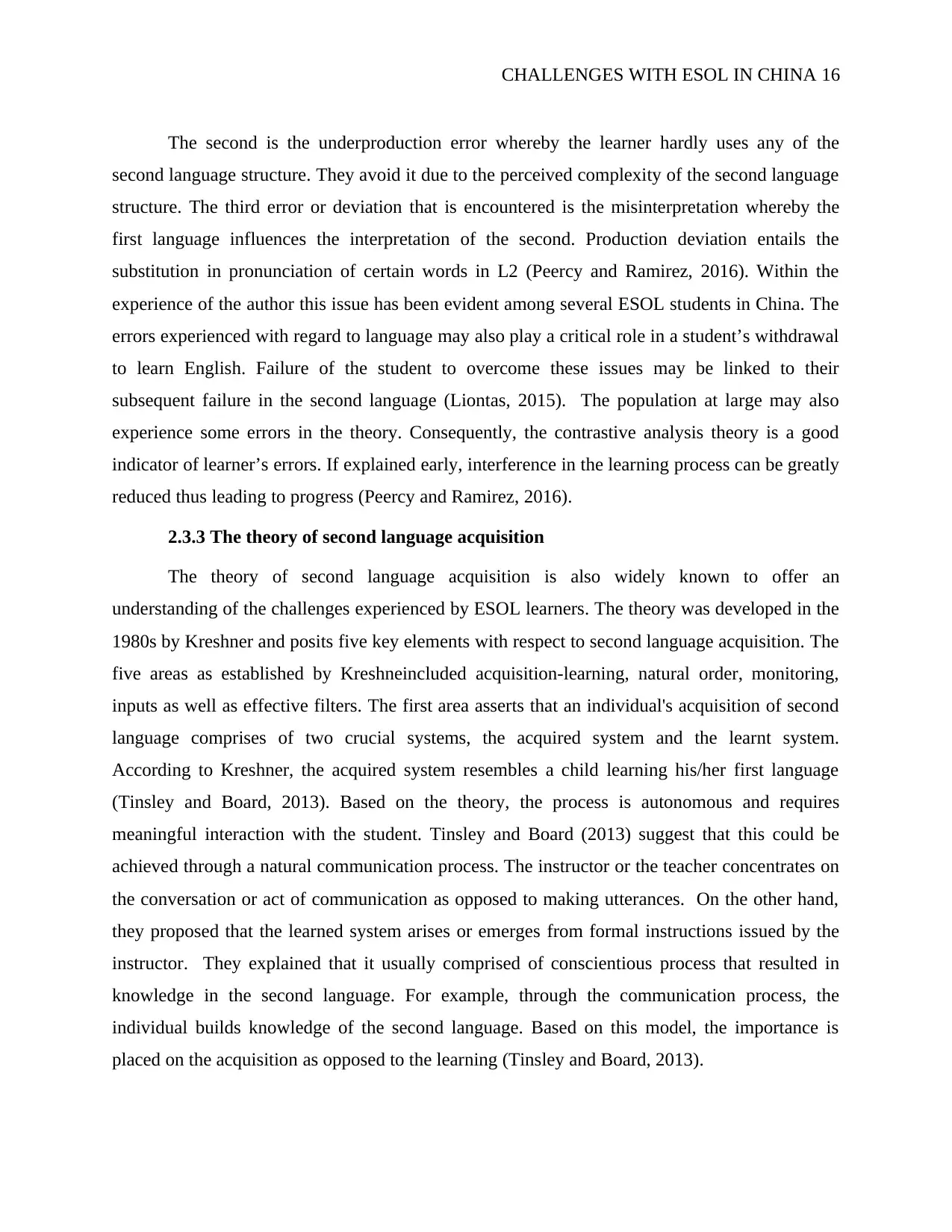
CHALLENGES WITH ESOL IN CHINA 16
The second is the underproduction error whereby the learner hardly uses any of the
second language structure. They avoid it due to the perceived complexity of the second language
structure. The third error or deviation that is encountered is the misinterpretation whereby the
first language influences the interpretation of the second. Production deviation entails the
substitution in pronunciation of certain words in L2 (Peercy and Ramirez, 2016). Within the
experience of the author this issue has been evident among several ESOL students in China. The
errors experienced with regard to language may also play a critical role in a student’s withdrawal
to learn English. Failure of the student to overcome these issues may be linked to their
subsequent failure in the second language (Liontas, 2015). The population at large may also
experience some errors in the theory. Consequently, the contrastive analysis theory is a good
indicator of learner’s errors. If explained early, interference in the learning process can be greatly
reduced thus leading to progress (Peercy and Ramirez, 2016).
2.3.3 The theory of second language acquisition
The theory of second language acquisition is also widely known to offer an
understanding of the challenges experienced by ESOL learners. The theory was developed in the
1980s by Kreshner and posits five key elements with respect to second language acquisition. The
five areas as established by Kreshneincluded acquisition-learning, natural order, monitoring,
inputs as well as effective filters. The first area asserts that an individual's acquisition of second
language comprises of two crucial systems, the acquired system and the learnt system.
According to Kreshner, the acquired system resembles a child learning his/her first language
(Tinsley and Board, 2013). Based on the theory, the process is autonomous and requires
meaningful interaction with the student. Tinsley and Board (2013) suggest that this could be
achieved through a natural communication process. The instructor or the teacher concentrates on
the conversation or act of communication as opposed to making utterances. On the other hand,
they proposed that the learned system arises or emerges from formal instructions issued by the
instructor. They explained that it usually comprised of conscientious process that resulted in
knowledge in the second language. For example, through the communication process, the
individual builds knowledge of the second language. Based on this model, the importance is
placed on the acquisition as opposed to the learning (Tinsley and Board, 2013).
The second is the underproduction error whereby the learner hardly uses any of the
second language structure. They avoid it due to the perceived complexity of the second language
structure. The third error or deviation that is encountered is the misinterpretation whereby the
first language influences the interpretation of the second. Production deviation entails the
substitution in pronunciation of certain words in L2 (Peercy and Ramirez, 2016). Within the
experience of the author this issue has been evident among several ESOL students in China. The
errors experienced with regard to language may also play a critical role in a student’s withdrawal
to learn English. Failure of the student to overcome these issues may be linked to their
subsequent failure in the second language (Liontas, 2015). The population at large may also
experience some errors in the theory. Consequently, the contrastive analysis theory is a good
indicator of learner’s errors. If explained early, interference in the learning process can be greatly
reduced thus leading to progress (Peercy and Ramirez, 2016).
2.3.3 The theory of second language acquisition
The theory of second language acquisition is also widely known to offer an
understanding of the challenges experienced by ESOL learners. The theory was developed in the
1980s by Kreshner and posits five key elements with respect to second language acquisition. The
five areas as established by Kreshneincluded acquisition-learning, natural order, monitoring,
inputs as well as effective filters. The first area asserts that an individual's acquisition of second
language comprises of two crucial systems, the acquired system and the learnt system.
According to Kreshner, the acquired system resembles a child learning his/her first language
(Tinsley and Board, 2013). Based on the theory, the process is autonomous and requires
meaningful interaction with the student. Tinsley and Board (2013) suggest that this could be
achieved through a natural communication process. The instructor or the teacher concentrates on
the conversation or act of communication as opposed to making utterances. On the other hand,
they proposed that the learned system arises or emerges from formal instructions issued by the
instructor. They explained that it usually comprised of conscientious process that resulted in
knowledge in the second language. For example, through the communication process, the
individual builds knowledge of the second language. Based on this model, the importance is
placed on the acquisition as opposed to the learning (Tinsley and Board, 2013).
Secure Best Marks with AI Grader
Need help grading? Try our AI Grader for instant feedback on your assignments.
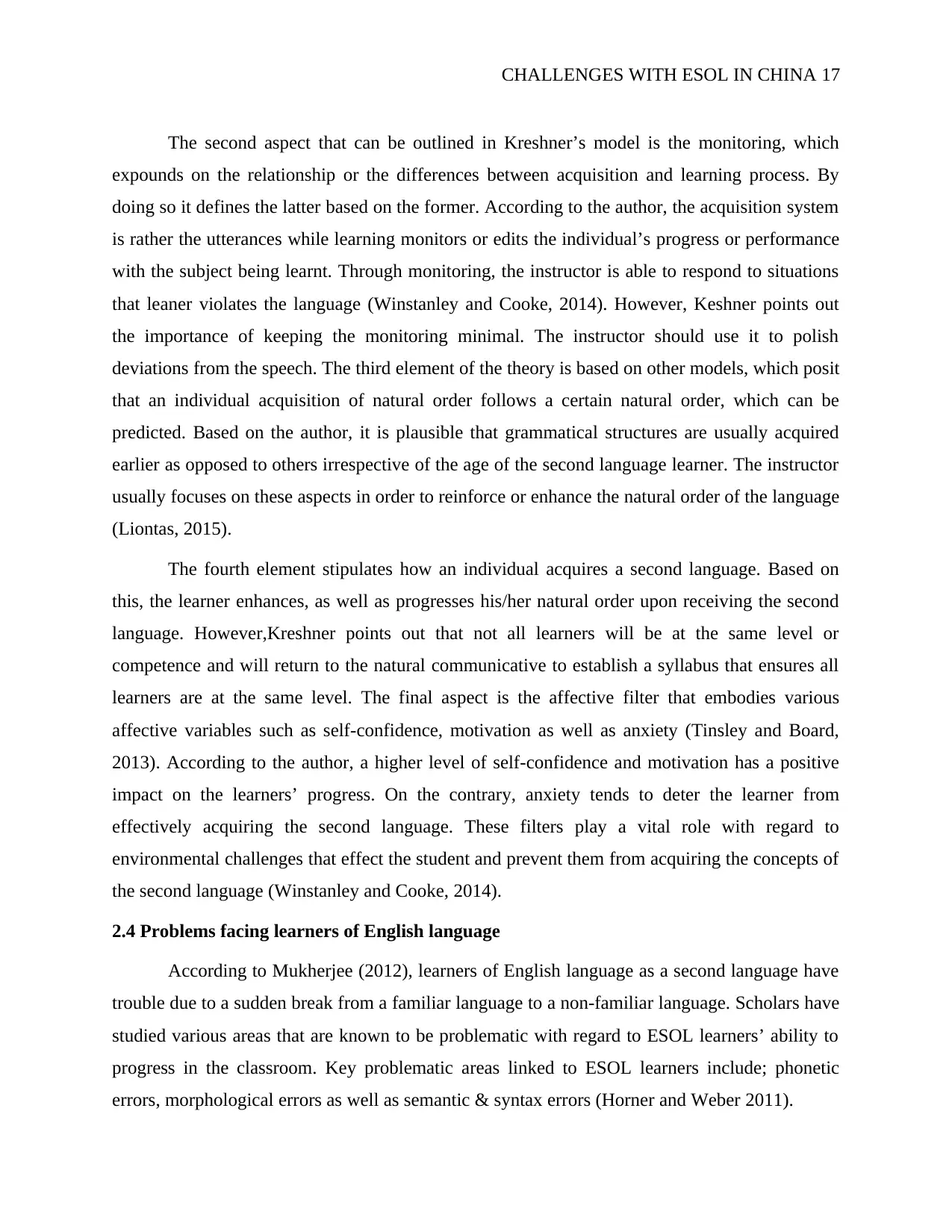
CHALLENGES WITH ESOL IN CHINA 17
The second aspect that can be outlined in Kreshner’s model is the monitoring, which
expounds on the relationship or the differences between acquisition and learning process. By
doing so it defines the latter based on the former. According to the author, the acquisition system
is rather the utterances while learning monitors or edits the individual’s progress or performance
with the subject being learnt. Through monitoring, the instructor is able to respond to situations
that leaner violates the language (Winstanley and Cooke, 2014). However, Keshner points out
the importance of keeping the monitoring minimal. The instructor should use it to polish
deviations from the speech. The third element of the theory is based on other models, which posit
that an individual acquisition of natural order follows a certain natural order, which can be
predicted. Based on the author, it is plausible that grammatical structures are usually acquired
earlier as opposed to others irrespective of the age of the second language learner. The instructor
usually focuses on these aspects in order to reinforce or enhance the natural order of the language
(Liontas, 2015).
The fourth element stipulates how an individual acquires a second language. Based on
this, the learner enhances, as well as progresses his/her natural order upon receiving the second
language. However,Kreshner points out that not all learners will be at the same level or
competence and will return to the natural communicative to establish a syllabus that ensures all
learners are at the same level. The final aspect is the affective filter that embodies various
affective variables such as self-confidence, motivation as well as anxiety (Tinsley and Board,
2013). According to the author, a higher level of self-confidence and motivation has a positive
impact on the learners’ progress. On the contrary, anxiety tends to deter the learner from
effectively acquiring the second language. These filters play a vital role with regard to
environmental challenges that effect the student and prevent them from acquiring the concepts of
the second language (Winstanley and Cooke, 2014).
2.4 Problems facing learners of English language
According to Mukherjee (2012), learners of English language as a second language have
trouble due to a sudden break from a familiar language to a non-familiar language. Scholars have
studied various areas that are known to be problematic with regard to ESOL learners’ ability to
progress in the classroom. Key problematic areas linked to ESOL learners include; phonetic
errors, morphological errors as well as semantic & syntax errors (Horner and Weber 2011).
The second aspect that can be outlined in Kreshner’s model is the monitoring, which
expounds on the relationship or the differences between acquisition and learning process. By
doing so it defines the latter based on the former. According to the author, the acquisition system
is rather the utterances while learning monitors or edits the individual’s progress or performance
with the subject being learnt. Through monitoring, the instructor is able to respond to situations
that leaner violates the language (Winstanley and Cooke, 2014). However, Keshner points out
the importance of keeping the monitoring minimal. The instructor should use it to polish
deviations from the speech. The third element of the theory is based on other models, which posit
that an individual acquisition of natural order follows a certain natural order, which can be
predicted. Based on the author, it is plausible that grammatical structures are usually acquired
earlier as opposed to others irrespective of the age of the second language learner. The instructor
usually focuses on these aspects in order to reinforce or enhance the natural order of the language
(Liontas, 2015).
The fourth element stipulates how an individual acquires a second language. Based on
this, the learner enhances, as well as progresses his/her natural order upon receiving the second
language. However,Kreshner points out that not all learners will be at the same level or
competence and will return to the natural communicative to establish a syllabus that ensures all
learners are at the same level. The final aspect is the affective filter that embodies various
affective variables such as self-confidence, motivation as well as anxiety (Tinsley and Board,
2013). According to the author, a higher level of self-confidence and motivation has a positive
impact on the learners’ progress. On the contrary, anxiety tends to deter the learner from
effectively acquiring the second language. These filters play a vital role with regard to
environmental challenges that effect the student and prevent them from acquiring the concepts of
the second language (Winstanley and Cooke, 2014).
2.4 Problems facing learners of English language
According to Mukherjee (2012), learners of English language as a second language have
trouble due to a sudden break from a familiar language to a non-familiar language. Scholars have
studied various areas that are known to be problematic with regard to ESOL learners’ ability to
progress in the classroom. Key problematic areas linked to ESOL learners include; phonetic
errors, morphological errors as well as semantic & syntax errors (Horner and Weber 2011).

CHALLENGES WITH ESOL IN CHINA 18
2.4.1 Mother tongue (L1) interference in English Language Learning
Second language learners experience mother tongue interference that inhibits a learner’s
acquisition of new skills. This is because the learner transfers the new language skills to his
native language (L1) which affects learning process or creates difficulties in responding to the
concepts. As aforementioned, the problem ranges from phonological (mispronunciations),
syntactic (grammatical) or semantic. A study by Oluwole (2014) at the University of Ilorin,
within which he criticized the low performance of new entrants in situation that needed logical
inference as well as advanced reasoning tasks. The low performance of the students was linked
to subsequent withdrawal or an incomplete status of the learner. With respect to phonology,
ESOL leaners also experience an inability to pronounce certain words. The native language, such
as Chinese requires unique pronunciation that is completely different from the English language.
Hence, the individual must understand the new sound which may oftenbe absent in their first or
native language (Lamarre, 2013).
2.4.2 Lack of necessary material and poor background to equip the learners
Scholars from different backgrounds have also investigated this phenomenon and its
influence in the underperformers of ESOL learners. The lack of core facilities & equipment
hinders the teaching practitioner from effectively transferring the knowledge. This problem is
double-edged, as it also hinders the students from learning at the desired pace. Most of the
literature in the library in certain foreign country is published in their native language (Court,
2017). Besides, it is only after understanding the concepts that an ESOL learner is able to
effectively access the materials from an online source. In order to effectively communicate and
comprehend the English language, the learner needs vital learning materials. In addition, the
background also affects the learner’s cognitive processes, as he/she requires exposition to other
individuals with knowledge or understanding of the language in order to speed up the learning
process. For example, a participatory ESOL classroom is driven by exchanges between the
students. The subject of these exchanges, which are initiated by the students, are always meant to
be relevant and meaningful to their livelihoods. If individuals lack interest in the language it also
affects the ability of other students to participate in these exchanges (Boothe, and Wickstrom,
2017).
2.4.1 Mother tongue (L1) interference in English Language Learning
Second language learners experience mother tongue interference that inhibits a learner’s
acquisition of new skills. This is because the learner transfers the new language skills to his
native language (L1) which affects learning process or creates difficulties in responding to the
concepts. As aforementioned, the problem ranges from phonological (mispronunciations),
syntactic (grammatical) or semantic. A study by Oluwole (2014) at the University of Ilorin,
within which he criticized the low performance of new entrants in situation that needed logical
inference as well as advanced reasoning tasks. The low performance of the students was linked
to subsequent withdrawal or an incomplete status of the learner. With respect to phonology,
ESOL leaners also experience an inability to pronounce certain words. The native language, such
as Chinese requires unique pronunciation that is completely different from the English language.
Hence, the individual must understand the new sound which may oftenbe absent in their first or
native language (Lamarre, 2013).
2.4.2 Lack of necessary material and poor background to equip the learners
Scholars from different backgrounds have also investigated this phenomenon and its
influence in the underperformers of ESOL learners. The lack of core facilities & equipment
hinders the teaching practitioner from effectively transferring the knowledge. This problem is
double-edged, as it also hinders the students from learning at the desired pace. Most of the
literature in the library in certain foreign country is published in their native language (Court,
2017). Besides, it is only after understanding the concepts that an ESOL learner is able to
effectively access the materials from an online source. In order to effectively communicate and
comprehend the English language, the learner needs vital learning materials. In addition, the
background also affects the learner’s cognitive processes, as he/she requires exposition to other
individuals with knowledge or understanding of the language in order to speed up the learning
process. For example, a participatory ESOL classroom is driven by exchanges between the
students. The subject of these exchanges, which are initiated by the students, are always meant to
be relevant and meaningful to their livelihoods. If individuals lack interest in the language it also
affects the ability of other students to participate in these exchanges (Boothe, and Wickstrom,
2017).

CHALLENGES WITH ESOL IN CHINA 19
2.4.3 Shortage of teaching practitioners of English language
Unlike other learners such as non-ELL and ELL, studies have shown ESOL learners
experience significant difficulties due to the levels of staff shortages. Statistics in the USshow
that most English teachers are trained to equip the grade level learners. Only a small portion exist
to assist and serve the burgeoning ELL and ESOL market. Besides, in order to assist the learners
they require certain qualification. The consequence is that the barriers to such ESOL students are
heightened, leading to lower progress in the education system. Studies by Tellez & Waxman
(2005), highlighted the importance of English as a second language and bilingual educational
teachers. Their authors also discovered the low levels of attention paid by regulators to the
essential standards, knowledge and skills required to effectively provide instructions to ESOL
learners. In response to the influx of teaching staff in the region, the Chinese government has
been seen to attempt to make the requirements of ESOL teachers more rigorous. According to
data published by Bureau of Foreign Experts Affairs, the certification bodies recognize only
30,000 foreign expert teachers. On the contrary, the region requires at least 100,000 foreign
teachers in order to effectively meet the demand (Xu, 2012).
The rapid growth of ESOL learners across China without measures to respond to the
demand has also been linked to the shortage. According to Boothe and Wickstrom (2017), the
current population has not been sufficiently matched to the teachers. The effect of this is that the
most regions are struggling to deal with the weight of rising ESOL learners who are not able to
demonstrate efficiency in academic areas such as reading, writing or speaking the language.
Based on a research conducted by James (2016), affirmed the unique challenge experienced by
educators as well as the federal government regarding ESOL and ELL. This is because while
various statutes and educational laws protect other students of the language, this group of
learners are not protected adequately to ensure that they succeed in their education.
2.4.4 Insufficient and inconsistent information for teachers
Research shows that even the most advanced nations, such as the US, experience
insufficient information regarding the various stages of ESOL teacher preparation, certification
and evaluation. It is arguable that these teachers require appropriate training in order to meet the
students’ language and learning needs thus facilitating academic growth (Mukherjee, 2012). The
absence of specific required coursework in China relating to unique learning needs of ESOL
2.4.3 Shortage of teaching practitioners of English language
Unlike other learners such as non-ELL and ELL, studies have shown ESOL learners
experience significant difficulties due to the levels of staff shortages. Statistics in the USshow
that most English teachers are trained to equip the grade level learners. Only a small portion exist
to assist and serve the burgeoning ELL and ESOL market. Besides, in order to assist the learners
they require certain qualification. The consequence is that the barriers to such ESOL students are
heightened, leading to lower progress in the education system. Studies by Tellez & Waxman
(2005), highlighted the importance of English as a second language and bilingual educational
teachers. Their authors also discovered the low levels of attention paid by regulators to the
essential standards, knowledge and skills required to effectively provide instructions to ESOL
learners. In response to the influx of teaching staff in the region, the Chinese government has
been seen to attempt to make the requirements of ESOL teachers more rigorous. According to
data published by Bureau of Foreign Experts Affairs, the certification bodies recognize only
30,000 foreign expert teachers. On the contrary, the region requires at least 100,000 foreign
teachers in order to effectively meet the demand (Xu, 2012).
The rapid growth of ESOL learners across China without measures to respond to the
demand has also been linked to the shortage. According to Boothe and Wickstrom (2017), the
current population has not been sufficiently matched to the teachers. The effect of this is that the
most regions are struggling to deal with the weight of rising ESOL learners who are not able to
demonstrate efficiency in academic areas such as reading, writing or speaking the language.
Based on a research conducted by James (2016), affirmed the unique challenge experienced by
educators as well as the federal government regarding ESOL and ELL. This is because while
various statutes and educational laws protect other students of the language, this group of
learners are not protected adequately to ensure that they succeed in their education.
2.4.4 Insufficient and inconsistent information for teachers
Research shows that even the most advanced nations, such as the US, experience
insufficient information regarding the various stages of ESOL teacher preparation, certification
and evaluation. It is arguable that these teachers require appropriate training in order to meet the
students’ language and learning needs thus facilitating academic growth (Mukherjee, 2012). The
absence of specific required coursework in China relating to unique learning needs of ESOL
Paraphrase This Document
Need a fresh take? Get an instant paraphrase of this document with our AI Paraphraser
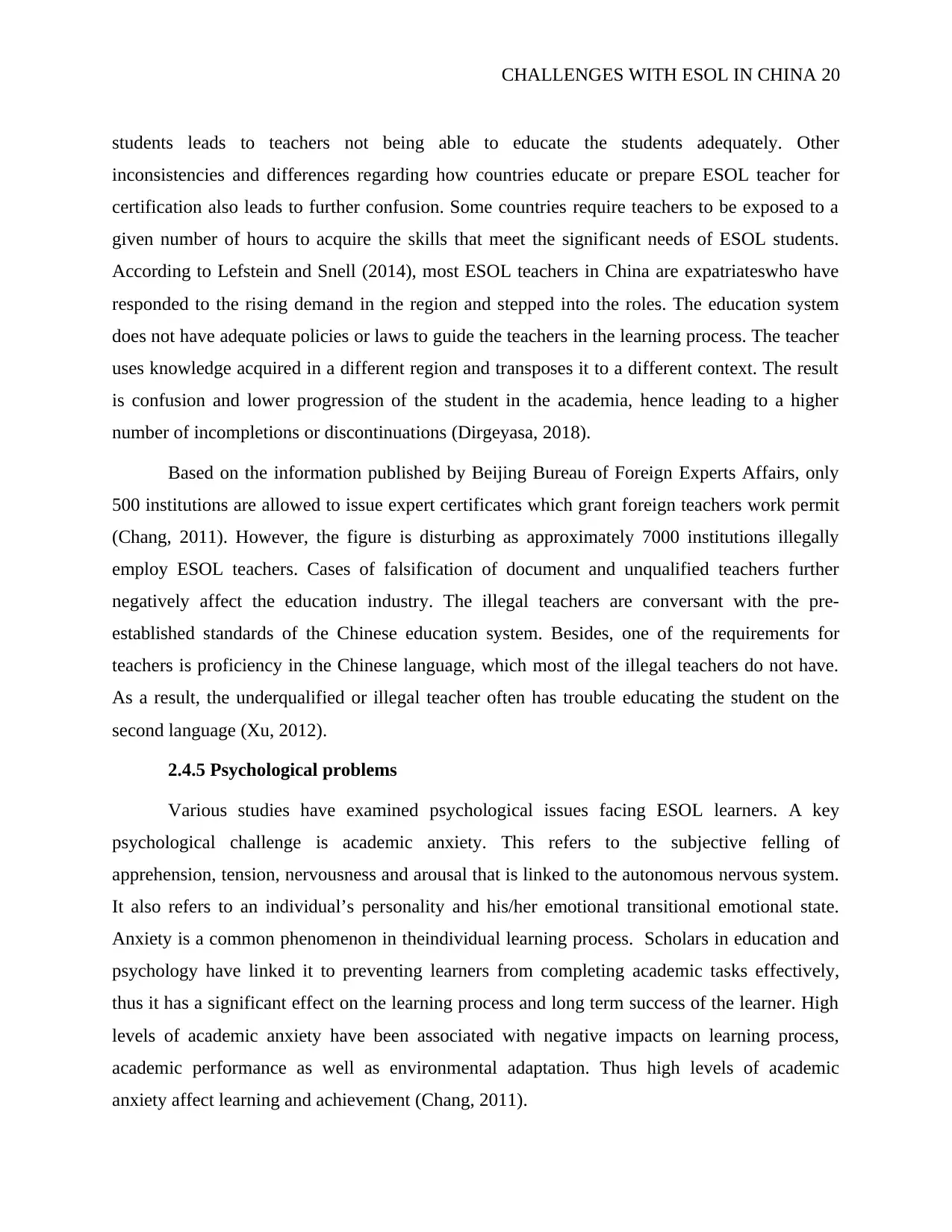
CHALLENGES WITH ESOL IN CHINA 20
students leads to teachers not being able to educate the students adequately. Other
inconsistencies and differences regarding how countries educate or prepare ESOL teacher for
certification also leads to further confusion. Some countries require teachers to be exposed to a
given number of hours to acquire the skills that meet the significant needs of ESOL students.
According to Lefstein and Snell (2014), most ESOL teachers in China are expatriateswho have
responded to the rising demand in the region and stepped into the roles. The education system
does not have adequate policies or laws to guide the teachers in the learning process. The teacher
uses knowledge acquired in a different region and transposes it to a different context. The result
is confusion and lower progression of the student in the academia, hence leading to a higher
number of incompletions or discontinuations (Dirgeyasa, 2018).
Based on the information published by Beijing Bureau of Foreign Experts Affairs, only
500 institutions are allowed to issue expert certificates which grant foreign teachers work permit
(Chang, 2011). However, the figure is disturbing as approximately 7000 institutions illegally
employ ESOL teachers. Cases of falsification of document and unqualified teachers further
negatively affect the education industry. The illegal teachers are conversant with the pre-
established standards of the Chinese education system. Besides, one of the requirements for
teachers is proficiency in the Chinese language, which most of the illegal teachers do not have.
As a result, the underqualified or illegal teacher often has trouble educating the student on the
second language (Xu, 2012).
2.4.5 Psychological problems
Various studies have examined psychological issues facing ESOL learners. A key
psychological challenge is academic anxiety. This refers to the subjective felling of
apprehension, tension, nervousness and arousal that is linked to the autonomous nervous system.
It also refers to an individual’s personality and his/her emotional transitional emotional state.
Anxiety is a common phenomenon in theindividual learning process. Scholars in education and
psychology have linked it to preventing learners from completing academic tasks effectively,
thus it has a significant effect on the learning process and long term success of the learner. High
levels of academic anxiety have been associated with negative impacts on learning process,
academic performance as well as environmental adaptation. Thus high levels of academic
anxiety affect learning and achievement (Chang, 2011).
students leads to teachers not being able to educate the students adequately. Other
inconsistencies and differences regarding how countries educate or prepare ESOL teacher for
certification also leads to further confusion. Some countries require teachers to be exposed to a
given number of hours to acquire the skills that meet the significant needs of ESOL students.
According to Lefstein and Snell (2014), most ESOL teachers in China are expatriateswho have
responded to the rising demand in the region and stepped into the roles. The education system
does not have adequate policies or laws to guide the teachers in the learning process. The teacher
uses knowledge acquired in a different region and transposes it to a different context. The result
is confusion and lower progression of the student in the academia, hence leading to a higher
number of incompletions or discontinuations (Dirgeyasa, 2018).
Based on the information published by Beijing Bureau of Foreign Experts Affairs, only
500 institutions are allowed to issue expert certificates which grant foreign teachers work permit
(Chang, 2011). However, the figure is disturbing as approximately 7000 institutions illegally
employ ESOL teachers. Cases of falsification of document and unqualified teachers further
negatively affect the education industry. The illegal teachers are conversant with the pre-
established standards of the Chinese education system. Besides, one of the requirements for
teachers is proficiency in the Chinese language, which most of the illegal teachers do not have.
As a result, the underqualified or illegal teacher often has trouble educating the student on the
second language (Xu, 2012).
2.4.5 Psychological problems
Various studies have examined psychological issues facing ESOL learners. A key
psychological challenge is academic anxiety. This refers to the subjective felling of
apprehension, tension, nervousness and arousal that is linked to the autonomous nervous system.
It also refers to an individual’s personality and his/her emotional transitional emotional state.
Anxiety is a common phenomenon in theindividual learning process. Scholars in education and
psychology have linked it to preventing learners from completing academic tasks effectively,
thus it has a significant effect on the learning process and long term success of the learner. High
levels of academic anxiety have been associated with negative impacts on learning process,
academic performance as well as environmental adaptation. Thus high levels of academic
anxiety affect learning and achievement (Chang, 2011).
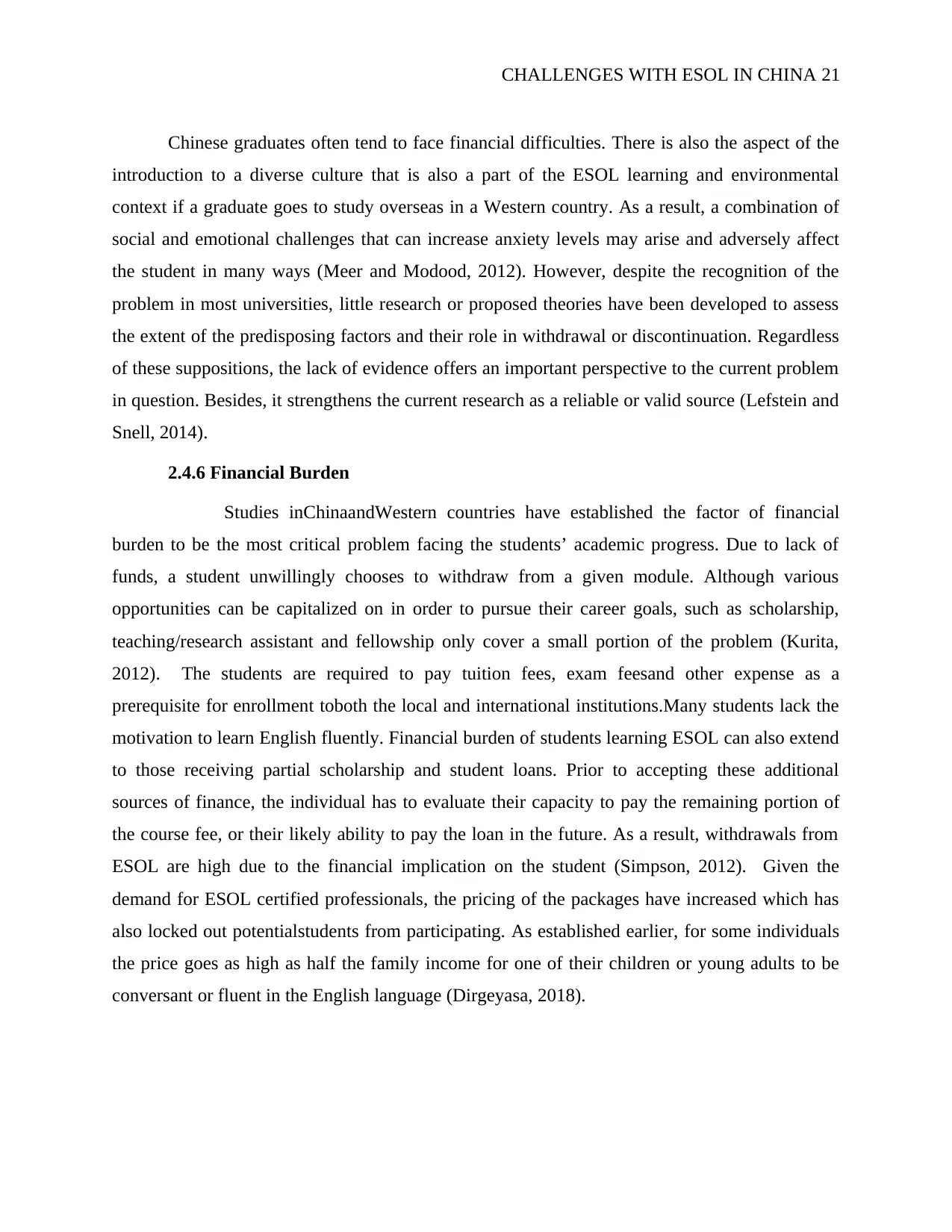
CHALLENGES WITH ESOL IN CHINA 21
Chinese graduates often tend to face financial difficulties. There is also the aspect of the
introduction to a diverse culture that is also a part of the ESOL learning and environmental
context if a graduate goes to study overseas in a Western country. As a result, a combination of
social and emotional challenges that can increase anxiety levels may arise and adversely affect
the student in many ways (Meer and Modood, 2012). However, despite the recognition of the
problem in most universities, little research or proposed theories have been developed to assess
the extent of the predisposing factors and their role in withdrawal or discontinuation. Regardless
of these suppositions, the lack of evidence offers an important perspective to the current problem
in question. Besides, it strengthens the current research as a reliable or valid source (Lefstein and
Snell, 2014).
2.4.6 Financial Burden
Studies inChinaandWestern countries have established the factor of financial
burden to be the most critical problem facing the students’ academic progress. Due to lack of
funds, a student unwillingly chooses to withdraw from a given module. Although various
opportunities can be capitalized on in order to pursue their career goals, such as scholarship,
teaching/research assistant and fellowship only cover a small portion of the problem (Kurita,
2012). The students are required to pay tuition fees, exam feesand other expense as a
prerequisite for enrollment toboth the local and international institutions.Many students lack the
motivation to learn English fluently. Financial burden of students learning ESOL can also extend
to those receiving partial scholarship and student loans. Prior to accepting these additional
sources of finance, the individual has to evaluate their capacity to pay the remaining portion of
the course fee, or their likely ability to pay the loan in the future. As a result, withdrawals from
ESOL are high due to the financial implication on the student (Simpson, 2012). Given the
demand for ESOL certified professionals, the pricing of the packages have increased which has
also locked out potentialstudents from participating. As established earlier, for some individuals
the price goes as high as half the family income for one of their children or young adults to be
conversant or fluent in the English language (Dirgeyasa, 2018).
Chinese graduates often tend to face financial difficulties. There is also the aspect of the
introduction to a diverse culture that is also a part of the ESOL learning and environmental
context if a graduate goes to study overseas in a Western country. As a result, a combination of
social and emotional challenges that can increase anxiety levels may arise and adversely affect
the student in many ways (Meer and Modood, 2012). However, despite the recognition of the
problem in most universities, little research or proposed theories have been developed to assess
the extent of the predisposing factors and their role in withdrawal or discontinuation. Regardless
of these suppositions, the lack of evidence offers an important perspective to the current problem
in question. Besides, it strengthens the current research as a reliable or valid source (Lefstein and
Snell, 2014).
2.4.6 Financial Burden
Studies inChinaandWestern countries have established the factor of financial
burden to be the most critical problem facing the students’ academic progress. Due to lack of
funds, a student unwillingly chooses to withdraw from a given module. Although various
opportunities can be capitalized on in order to pursue their career goals, such as scholarship,
teaching/research assistant and fellowship only cover a small portion of the problem (Kurita,
2012). The students are required to pay tuition fees, exam feesand other expense as a
prerequisite for enrollment toboth the local and international institutions.Many students lack the
motivation to learn English fluently. Financial burden of students learning ESOL can also extend
to those receiving partial scholarship and student loans. Prior to accepting these additional
sources of finance, the individual has to evaluate their capacity to pay the remaining portion of
the course fee, or their likely ability to pay the loan in the future. As a result, withdrawals from
ESOL are high due to the financial implication on the student (Simpson, 2012). Given the
demand for ESOL certified professionals, the pricing of the packages have increased which has
also locked out potentialstudents from participating. As established earlier, for some individuals
the price goes as high as half the family income for one of their children or young adults to be
conversant or fluent in the English language (Dirgeyasa, 2018).

CHALLENGES WITH ESOL IN CHINA 22
2.5 Factors influencing ESOL Learners in China
2.5.1 The effect of Cross-Cultures on ESOL
A culture refers to a system of beliefs, values and practices that have been tested and
accepted over a significant period of time. Culture helps to distinguish one community from
another. Meer and Modood (2012), have established language as a fundamental aspect of culture.
The process of globalization, with people as well as activities, has led to a more“global culture”
developing. Hence, the need to conform to the global culture and practices arises. English has
emerged as one of the primary second languages of communication in this global culture. This
demand for more ESOL opportunities puts the student at the centre of the process. The
fundamental principles of ESOL involves a dynamic process of student participation and
practice; students are at the center of the curriculum as opposed to a curriculum followed by the
student. For example; Chinese individuals are attracted to the global culture that has emerged
due to globalization. Exposure the Western culture content through various forms of media and
technology increases their urge to learn the new language. The uniqueness of the West, including
the ability to interact with people through platforms such as social media sites and programs also
influences the need to learn and understand the language (Dirgeyasa, 2018).
Due to the economic importance of China in the global economy, individuals from other
countries are also learning Chinese in order to communicate effectively and conduct business.
The ESOL teachers may also have a background of Chinese language learning and this may help
to effectively assist the learners. As individuals from different cultures intermingle, they tend to
learn each other’s ways or principles thus leading to emergence of a new culture. According to
Court (2017), individuals from a dominant culture tend to suffer from an inferiority complex. As
a result, they tend to imitate practices such as dressing, language and other behaviors. Gilquin,
and Paquot. (2008).This notion can be extended to China, a country that dominates a global
market through their imitations and copies of various products and services in the Western
world. Such imitations can be seen in many different dimensions, such as trade, education and
lifestyle. The Western culture is attractive to the Chinese culture and individuals within China
wish to learn more about Westen culture, including their language (Prichard and Moore, 2016).
2.5 Factors influencing ESOL Learners in China
2.5.1 The effect of Cross-Cultures on ESOL
A culture refers to a system of beliefs, values and practices that have been tested and
accepted over a significant period of time. Culture helps to distinguish one community from
another. Meer and Modood (2012), have established language as a fundamental aspect of culture.
The process of globalization, with people as well as activities, has led to a more“global culture”
developing. Hence, the need to conform to the global culture and practices arises. English has
emerged as one of the primary second languages of communication in this global culture. This
demand for more ESOL opportunities puts the student at the centre of the process. The
fundamental principles of ESOL involves a dynamic process of student participation and
practice; students are at the center of the curriculum as opposed to a curriculum followed by the
student. For example; Chinese individuals are attracted to the global culture that has emerged
due to globalization. Exposure the Western culture content through various forms of media and
technology increases their urge to learn the new language. The uniqueness of the West, including
the ability to interact with people through platforms such as social media sites and programs also
influences the need to learn and understand the language (Dirgeyasa, 2018).
Due to the economic importance of China in the global economy, individuals from other
countries are also learning Chinese in order to communicate effectively and conduct business.
The ESOL teachers may also have a background of Chinese language learning and this may help
to effectively assist the learners. As individuals from different cultures intermingle, they tend to
learn each other’s ways or principles thus leading to emergence of a new culture. According to
Court (2017), individuals from a dominant culture tend to suffer from an inferiority complex. As
a result, they tend to imitate practices such as dressing, language and other behaviors. Gilquin,
and Paquot. (2008).This notion can be extended to China, a country that dominates a global
market through their imitations and copies of various products and services in the Western
world. Such imitations can be seen in many different dimensions, such as trade, education and
lifestyle. The Western culture is attractive to the Chinese culture and individuals within China
wish to learn more about Westen culture, including their language (Prichard and Moore, 2016).
Secure Best Marks with AI Grader
Need help grading? Try our AI Grader for instant feedback on your assignments.
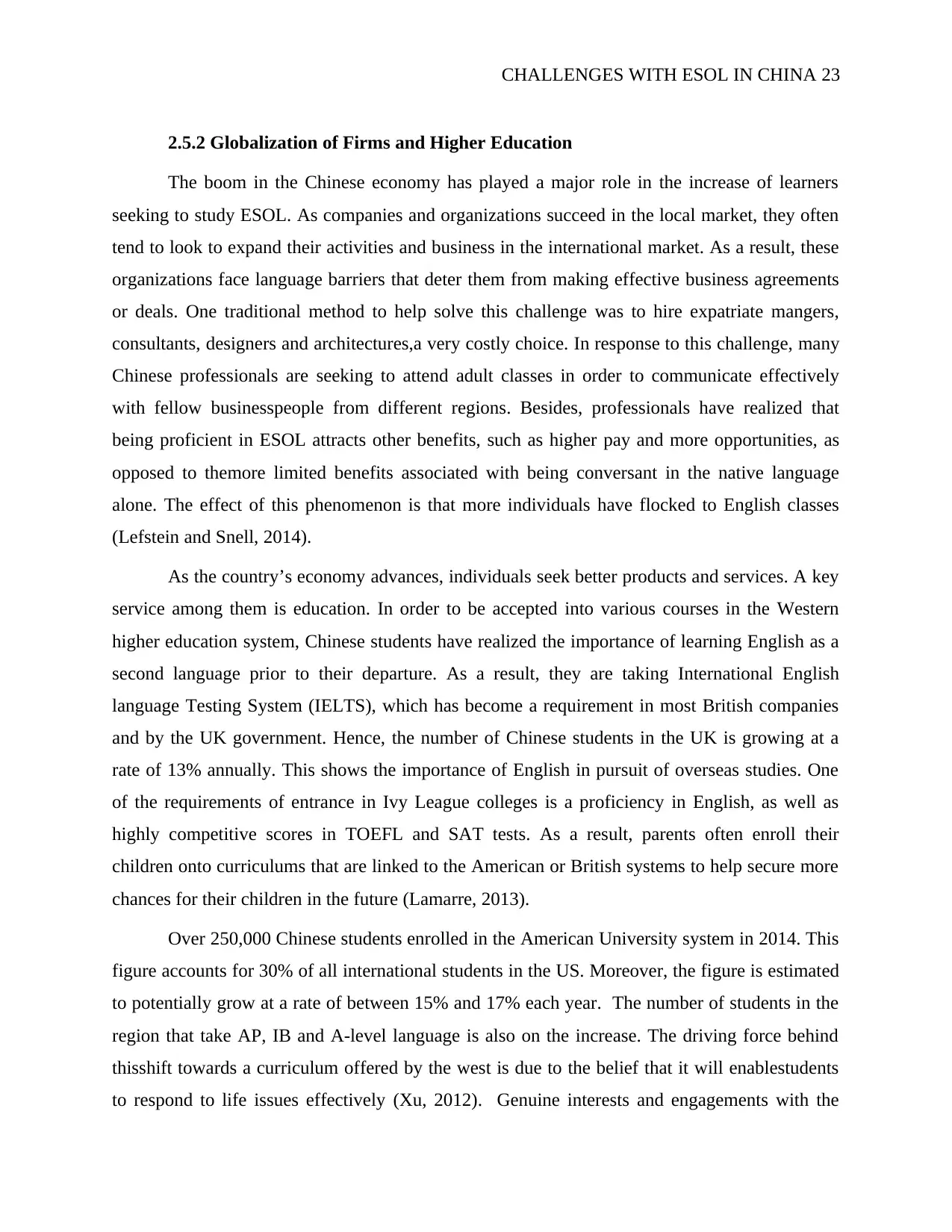
CHALLENGES WITH ESOL IN CHINA 23
2.5.2 Globalization of Firms and Higher Education
The boom in the Chinese economy has played a major role in the increase of learners
seeking to study ESOL. As companies and organizations succeed in the local market, they often
tend to look to expand their activities and business in the international market. As a result, these
organizations face language barriers that deter them from making effective business agreements
or deals. One traditional method to help solve this challenge was to hire expatriate mangers,
consultants, designers and architectures,a very costly choice. In response to this challenge, many
Chinese professionals are seeking to attend adult classes in order to communicate effectively
with fellow businesspeople from different regions. Besides, professionals have realized that
being proficient in ESOL attracts other benefits, such as higher pay and more opportunities, as
opposed to themore limited benefits associated with being conversant in the native language
alone. The effect of this phenomenon is that more individuals have flocked to English classes
(Lefstein and Snell, 2014).
As the country’s economy advances, individuals seek better products and services. A key
service among them is education. In order to be accepted into various courses in the Western
higher education system, Chinese students have realized the importance of learning English as a
second language prior to their departure. As a result, they are taking International English
language Testing System (IELTS), which has become a requirement in most British companies
and by the UK government. Hence, the number of Chinese students in the UK is growing at a
rate of 13% annually. This shows the importance of English in pursuit of overseas studies. One
of the requirements of entrance in Ivy League colleges is a proficiency in English, as well as
highly competitive scores in TOEFL and SAT tests. As a result, parents often enroll their
children onto curriculums that are linked to the American or British systems to help secure more
chances for their children in the future (Lamarre, 2013).
Over 250,000 Chinese students enrolled in the American University system in 2014. This
figure accounts for 30% of all international students in the US. Moreover, the figure is estimated
to potentially grow at a rate of between 15% and 17% each year. The number of students in the
region that take AP, IB and A-level language is also on the increase. The driving force behind
thisshift towards a curriculum offered by the west is due to the belief that it will enablestudents
to respond to life issues effectively (Xu, 2012). Genuine interests and engagements with the
2.5.2 Globalization of Firms and Higher Education
The boom in the Chinese economy has played a major role in the increase of learners
seeking to study ESOL. As companies and organizations succeed in the local market, they often
tend to look to expand their activities and business in the international market. As a result, these
organizations face language barriers that deter them from making effective business agreements
or deals. One traditional method to help solve this challenge was to hire expatriate mangers,
consultants, designers and architectures,a very costly choice. In response to this challenge, many
Chinese professionals are seeking to attend adult classes in order to communicate effectively
with fellow businesspeople from different regions. Besides, professionals have realized that
being proficient in ESOL attracts other benefits, such as higher pay and more opportunities, as
opposed to themore limited benefits associated with being conversant in the native language
alone. The effect of this phenomenon is that more individuals have flocked to English classes
(Lefstein and Snell, 2014).
As the country’s economy advances, individuals seek better products and services. A key
service among them is education. In order to be accepted into various courses in the Western
higher education system, Chinese students have realized the importance of learning English as a
second language prior to their departure. As a result, they are taking International English
language Testing System (IELTS), which has become a requirement in most British companies
and by the UK government. Hence, the number of Chinese students in the UK is growing at a
rate of 13% annually. This shows the importance of English in pursuit of overseas studies. One
of the requirements of entrance in Ivy League colleges is a proficiency in English, as well as
highly competitive scores in TOEFL and SAT tests. As a result, parents often enroll their
children onto curriculums that are linked to the American or British systems to help secure more
chances for their children in the future (Lamarre, 2013).
Over 250,000 Chinese students enrolled in the American University system in 2014. This
figure accounts for 30% of all international students in the US. Moreover, the figure is estimated
to potentially grow at a rate of between 15% and 17% each year. The number of students in the
region that take AP, IB and A-level language is also on the increase. The driving force behind
thisshift towards a curriculum offered by the west is due to the belief that it will enablestudents
to respond to life issues effectively (Xu, 2012). Genuine interests and engagements with the
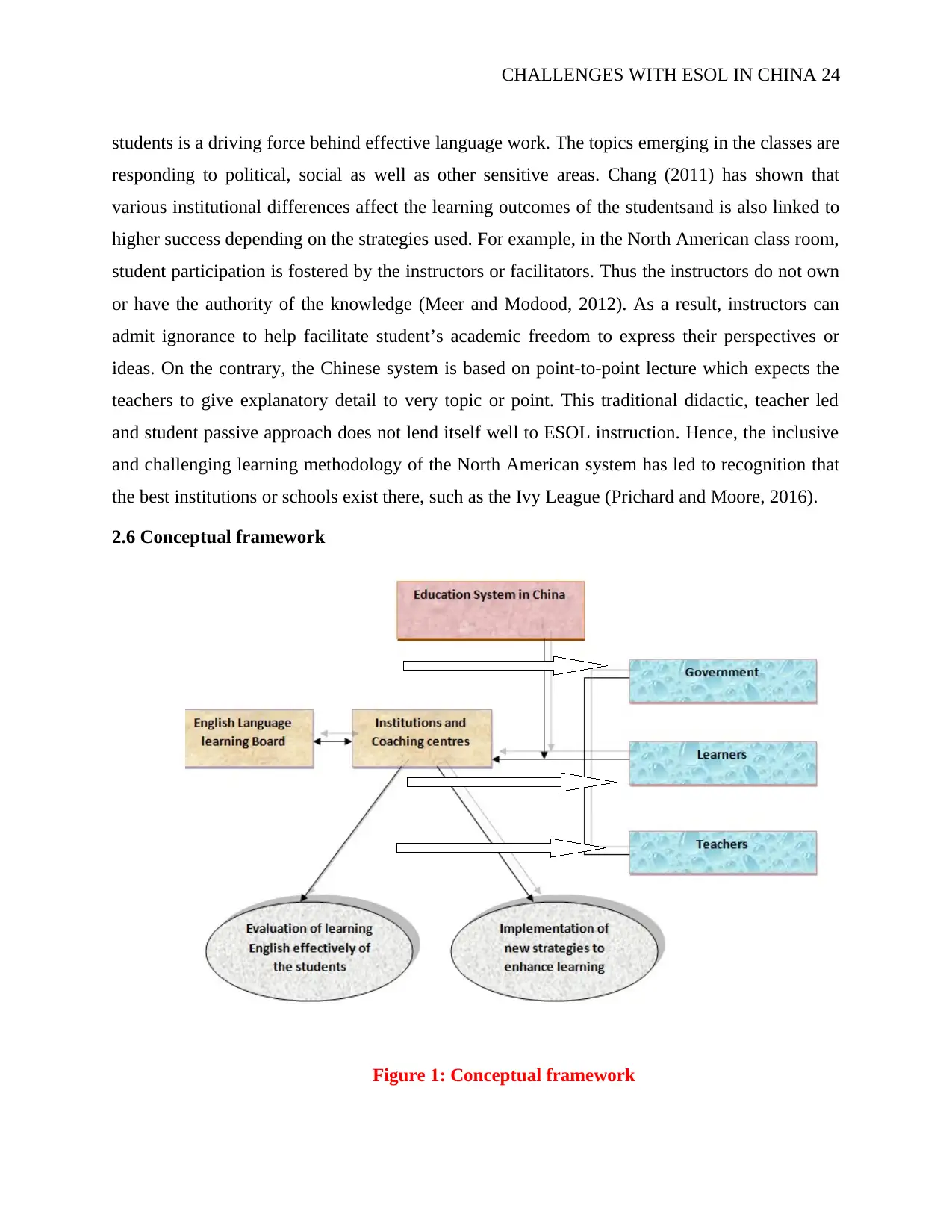
CHALLENGES WITH ESOL IN CHINA 24
students is a driving force behind effective language work. The topics emerging in the classes are
responding to political, social as well as other sensitive areas. Chang (2011) has shown that
various institutional differences affect the learning outcomes of the studentsand is also linked to
higher success depending on the strategies used. For example, in the North American class room,
student participation is fostered by the instructors or facilitators. Thus the instructors do not own
or have the authority of the knowledge (Meer and Modood, 2012). As a result, instructors can
admit ignorance to help facilitate student’s academic freedom to express their perspectives or
ideas. On the contrary, the Chinese system is based on point-to-point lecture which expects the
teachers to give explanatory detail to very topic or point. This traditional didactic, teacher led
and student passive approach does not lend itself well to ESOL instruction. Hence, the inclusive
and challenging learning methodology of the North American system has led to recognition that
the best institutions or schools exist there, such as the Ivy League (Prichard and Moore, 2016).
2.6 Conceptual framework
Figure 1: Conceptual framework
students is a driving force behind effective language work. The topics emerging in the classes are
responding to political, social as well as other sensitive areas. Chang (2011) has shown that
various institutional differences affect the learning outcomes of the studentsand is also linked to
higher success depending on the strategies used. For example, in the North American class room,
student participation is fostered by the instructors or facilitators. Thus the instructors do not own
or have the authority of the knowledge (Meer and Modood, 2012). As a result, instructors can
admit ignorance to help facilitate student’s academic freedom to express their perspectives or
ideas. On the contrary, the Chinese system is based on point-to-point lecture which expects the
teachers to give explanatory detail to very topic or point. This traditional didactic, teacher led
and student passive approach does not lend itself well to ESOL instruction. Hence, the inclusive
and challenging learning methodology of the North American system has led to recognition that
the best institutions or schools exist there, such as the Ivy League (Prichard and Moore, 2016).
2.6 Conceptual framework
Figure 1: Conceptual framework
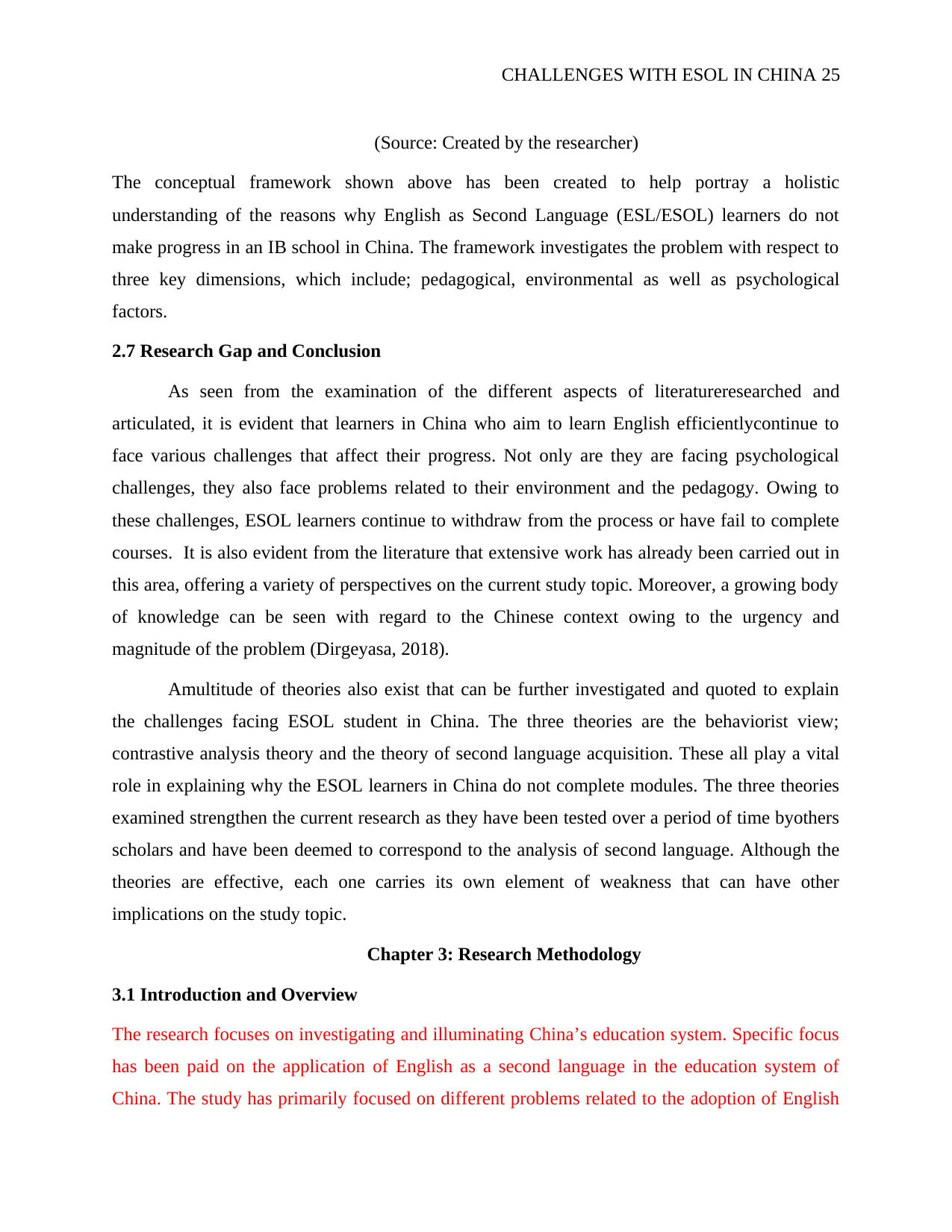
CHALLENGES WITH ESOL IN CHINA 25
(Source: Created by the researcher)
The conceptual framework shown above has been created to help portray a holistic
understanding of the reasons why English as Second Language (ESL/ESOL) learners do not
make progress in an IB school in China. The framework investigates the problem with respect to
three key dimensions, which include; pedagogical, environmental as well as psychological
factors.
2.7 Research Gap and Conclusion
As seen from the examination of the different aspects of literatureresearched and
articulated, it is evident that learners in China who aim to learn English efficientlycontinue to
face various challenges that affect their progress. Not only are they are facing psychological
challenges, they also face problems related to their environment and the pedagogy. Owing to
these challenges, ESOL learners continue to withdraw from the process or have fail to complete
courses. It is also evident from the literature that extensive work has already been carried out in
this area, offering a variety of perspectives on the current study topic. Moreover, a growing body
of knowledge can be seen with regard to the Chinese context owing to the urgency and
magnitude of the problem (Dirgeyasa, 2018).
Amultitude of theories also exist that can be further investigated and quoted to explain
the challenges facing ESOL student in China. The three theories are the behaviorist view;
contrastive analysis theory and the theory of second language acquisition. These all play a vital
role in explaining why the ESOL learners in China do not complete modules. The three theories
examined strengthen the current research as they have been tested over a period of time byothers
scholars and have been deemed to correspond to the analysis of second language. Although the
theories are effective, each one carries its own element of weakness that can have other
implications on the study topic.
Chapter 3: Research Methodology
3.1 Introduction and Overview
The research focuses on investigating and illuminating China’s education system. Specific focus
has been paid on the application of English as a second language in the education system of
China. The study has primarily focused on different problems related to the adoption of English
(Source: Created by the researcher)
The conceptual framework shown above has been created to help portray a holistic
understanding of the reasons why English as Second Language (ESL/ESOL) learners do not
make progress in an IB school in China. The framework investigates the problem with respect to
three key dimensions, which include; pedagogical, environmental as well as psychological
factors.
2.7 Research Gap and Conclusion
As seen from the examination of the different aspects of literatureresearched and
articulated, it is evident that learners in China who aim to learn English efficientlycontinue to
face various challenges that affect their progress. Not only are they are facing psychological
challenges, they also face problems related to their environment and the pedagogy. Owing to
these challenges, ESOL learners continue to withdraw from the process or have fail to complete
courses. It is also evident from the literature that extensive work has already been carried out in
this area, offering a variety of perspectives on the current study topic. Moreover, a growing body
of knowledge can be seen with regard to the Chinese context owing to the urgency and
magnitude of the problem (Dirgeyasa, 2018).
Amultitude of theories also exist that can be further investigated and quoted to explain
the challenges facing ESOL student in China. The three theories are the behaviorist view;
contrastive analysis theory and the theory of second language acquisition. These all play a vital
role in explaining why the ESOL learners in China do not complete modules. The three theories
examined strengthen the current research as they have been tested over a period of time byothers
scholars and have been deemed to correspond to the analysis of second language. Although the
theories are effective, each one carries its own element of weakness that can have other
implications on the study topic.
Chapter 3: Research Methodology
3.1 Introduction and Overview
The research focuses on investigating and illuminating China’s education system. Specific focus
has been paid on the application of English as a second language in the education system of
China. The study has primarily focused on different problems related to the adoption of English
Paraphrase This Document
Need a fresh take? Get an instant paraphrase of this document with our AI Paraphraser
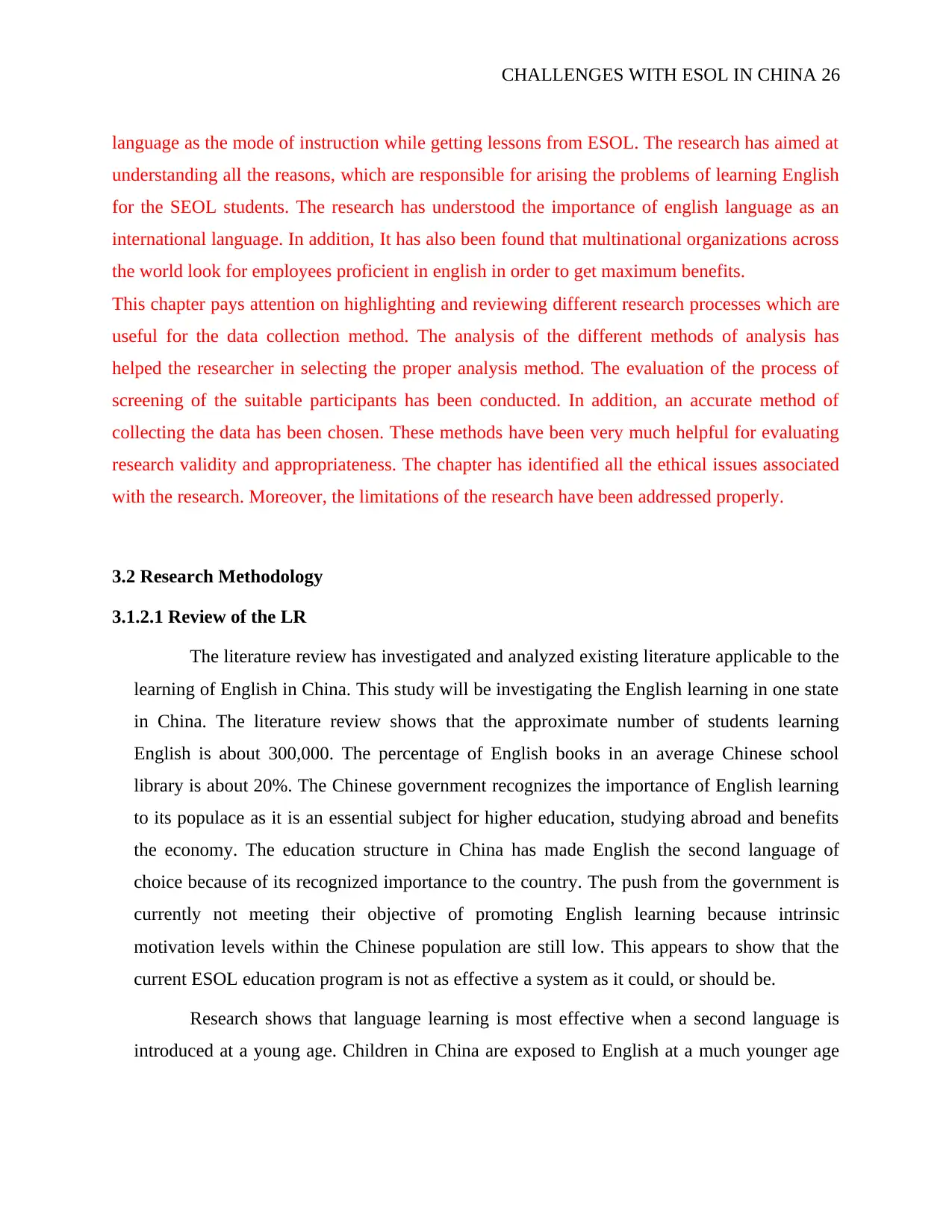
CHALLENGES WITH ESOL IN CHINA 26
language as the mode of instruction while getting lessons from ESOL. The research has aimed at
understanding all the reasons, which are responsible for arising the problems of learning English
for the SEOL students. The research has understood the importance of english language as an
international language. In addition, It has also been found that multinational organizations across
the world look for employees proficient in english in order to get maximum benefits.
This chapter pays attention on highlighting and reviewing different research processes which are
useful for the data collection method. The analysis of the different methods of analysis has
helped the researcher in selecting the proper analysis method. The evaluation of the process of
screening of the suitable participants has been conducted. In addition, an accurate method of
collecting the data has been chosen. These methods have been very much helpful for evaluating
research validity and appropriateness. The chapter has identified all the ethical issues associated
with the research. Moreover, the limitations of the research have been addressed properly.
3.2 Research Methodology
3.1.2.1 Review of the LR
The literature review has investigated and analyzed existing literature applicable to the
learning of English in China. This study will be investigating the English learning in one state
in China. The literature review shows that the approximate number of students learning
English is about 300,000. The percentage of English books in an average Chinese school
library is about 20%. The Chinese government recognizes the importance of English learning
to its populace as it is an essential subject for higher education, studying abroad and benefits
the economy. The education structure in China has made English the second language of
choice because of its recognized importance to the country. The push from the government is
currently not meeting their objective of promoting English learning because intrinsic
motivation levels within the Chinese population are still low. This appears to show that the
current ESOL education program is not as effective a system as it could, or should be.
Research shows that language learning is most effective when a second language is
introduced at a young age. Children in China are exposed to English at a much younger age
language as the mode of instruction while getting lessons from ESOL. The research has aimed at
understanding all the reasons, which are responsible for arising the problems of learning English
for the SEOL students. The research has understood the importance of english language as an
international language. In addition, It has also been found that multinational organizations across
the world look for employees proficient in english in order to get maximum benefits.
This chapter pays attention on highlighting and reviewing different research processes which are
useful for the data collection method. The analysis of the different methods of analysis has
helped the researcher in selecting the proper analysis method. The evaluation of the process of
screening of the suitable participants has been conducted. In addition, an accurate method of
collecting the data has been chosen. These methods have been very much helpful for evaluating
research validity and appropriateness. The chapter has identified all the ethical issues associated
with the research. Moreover, the limitations of the research have been addressed properly.
3.2 Research Methodology
3.1.2.1 Review of the LR
The literature review has investigated and analyzed existing literature applicable to the
learning of English in China. This study will be investigating the English learning in one state
in China. The literature review shows that the approximate number of students learning
English is about 300,000. The percentage of English books in an average Chinese school
library is about 20%. The Chinese government recognizes the importance of English learning
to its populace as it is an essential subject for higher education, studying abroad and benefits
the economy. The education structure in China has made English the second language of
choice because of its recognized importance to the country. The push from the government is
currently not meeting their objective of promoting English learning because intrinsic
motivation levels within the Chinese population are still low. This appears to show that the
current ESOL education program is not as effective a system as it could, or should be.
Research shows that language learning is most effective when a second language is
introduced at a young age. Children in China are exposed to English at a much younger age

CHALLENGES WITH ESOL IN CHINA 27
now, but the lack of consistent, appropriate and effective ESOL teaching and qualifications
for teachers has had a negative impact on progress in this area.
For adults, there are a number of institutes that are able to provide training in English
with the help of experienced instructors, but more needs to be done in this area. According to
the behaviorist theory, the learning and assimilation of a new language comes under the
human behavior of stimulus-response domain. In this domain, learning a topic when
instruction is given in the mother tongue is much easier because it is a natural process and
phenomenon. Learning something when instruction is given in a language that is not the
native tongue is a more difficult process because it falls outside the student’s natural frame of
reference which has been assimilated in their native language. The constructivist theory
proposes that learning a native language is a natural process that owes a lot of success because
it is the first language a child hears and needs. For a language to be embedded and learned at a
deeper level, it is necessary to use it as a method of communication rather than an objective
lesson in learning. Therefore, the processes and methods used to teach a second language need
to develop a level of motivation that becomes intrinsic for the learner. When a student can see
the need and application of the second language, a higher level of intrinsic motivation is
achieved and more successful progress can be made by the learner. Without this level of
intrinsic motivation from the student, there is a tendency for the student to use their native
language more frequently and this acts as a significant barrier to learning English.
3.2.1 Research Onion:
This chapter is very much helpful for discussing the research design and all the methods which
are required for carrying out the research properly. Research onion that is developed by Saunders
et al. (2009) has used the term research onion first. It is an important tool for developing the
research plan.. Just like an onion, the research onion is made up of a number of layers one on top
of another. As one layer (stage) is complete, the researcher can move to the next layer in a
structured and disciplined way until the core is reached (Peercy et al. 2016). The diagnostic tools
revealed at each layer inform the research design in a continuum.According to the research
design tool, the first layer to tackle is the research philosophy due to its importance to the
research. After that, each later reveals a design that structures the research. It also helpprovide
the style and nature of the research. The strategy layers perhaps the most important layer because
now, but the lack of consistent, appropriate and effective ESOL teaching and qualifications
for teachers has had a negative impact on progress in this area.
For adults, there are a number of institutes that are able to provide training in English
with the help of experienced instructors, but more needs to be done in this area. According to
the behaviorist theory, the learning and assimilation of a new language comes under the
human behavior of stimulus-response domain. In this domain, learning a topic when
instruction is given in the mother tongue is much easier because it is a natural process and
phenomenon. Learning something when instruction is given in a language that is not the
native tongue is a more difficult process because it falls outside the student’s natural frame of
reference which has been assimilated in their native language. The constructivist theory
proposes that learning a native language is a natural process that owes a lot of success because
it is the first language a child hears and needs. For a language to be embedded and learned at a
deeper level, it is necessary to use it as a method of communication rather than an objective
lesson in learning. Therefore, the processes and methods used to teach a second language need
to develop a level of motivation that becomes intrinsic for the learner. When a student can see
the need and application of the second language, a higher level of intrinsic motivation is
achieved and more successful progress can be made by the learner. Without this level of
intrinsic motivation from the student, there is a tendency for the student to use their native
language more frequently and this acts as a significant barrier to learning English.
3.2.1 Research Onion:
This chapter is very much helpful for discussing the research design and all the methods which
are required for carrying out the research properly. Research onion that is developed by Saunders
et al. (2009) has used the term research onion first. It is an important tool for developing the
research plan.. Just like an onion, the research onion is made up of a number of layers one on top
of another. As one layer (stage) is complete, the researcher can move to the next layer in a
structured and disciplined way until the core is reached (Peercy et al. 2016). The diagnostic tools
revealed at each layer inform the research design in a continuum.According to the research
design tool, the first layer to tackle is the research philosophy due to its importance to the
research. After that, each later reveals a design that structures the research. It also helpprovide
the style and nature of the research. The strategy layers perhaps the most important layer because
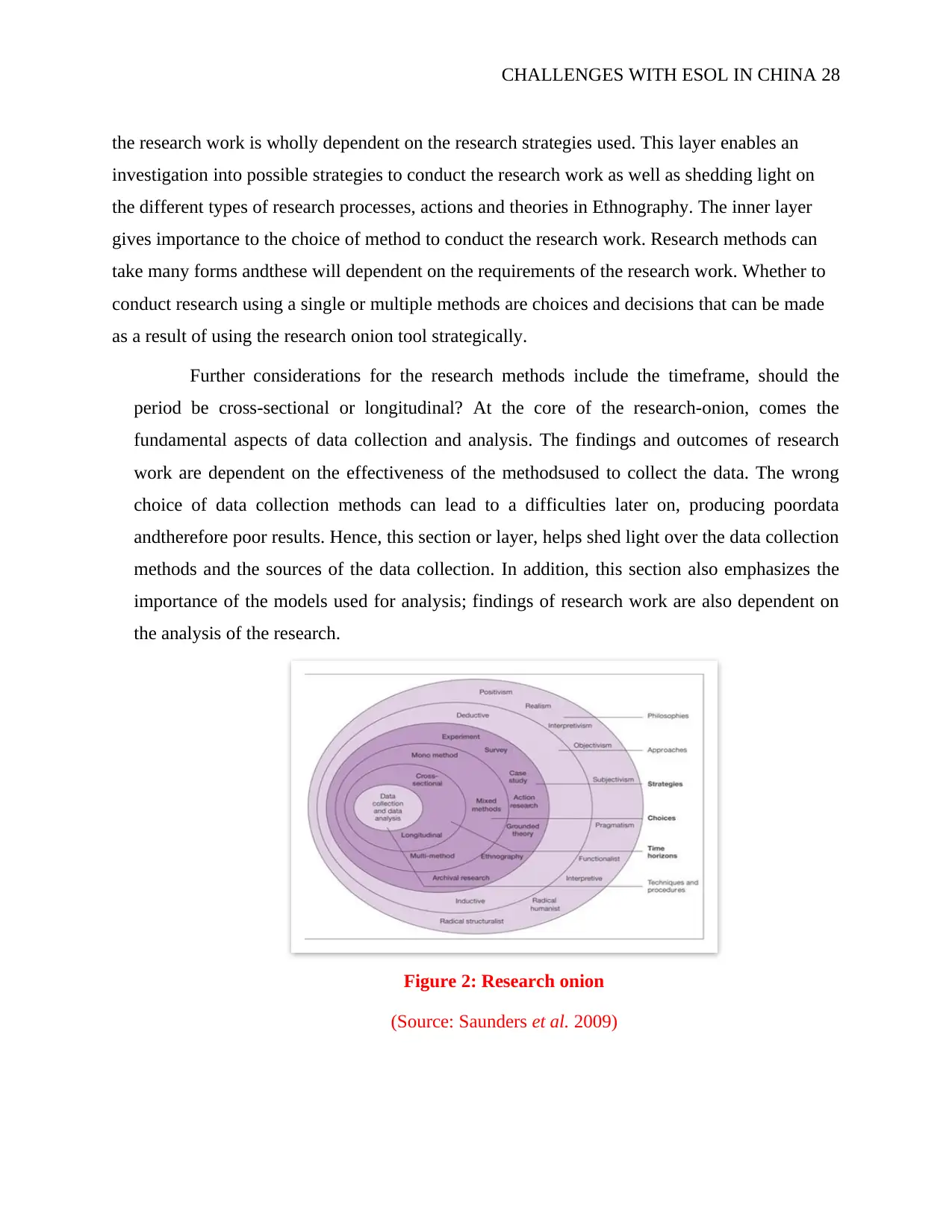
CHALLENGES WITH ESOL IN CHINA 28
the research work is wholly dependent on the research strategies used. This layer enables an
investigation into possible strategies to conduct the research work as well as shedding light on
the different types of research processes, actions and theories in Ethnography. The inner layer
gives importance to the choice of method to conduct the research work. Research methods can
take many forms andthese will dependent on the requirements of the research work. Whether to
conduct research using a single or multiple methods are choices and decisions that can be made
as a result of using the research onion tool strategically.
Further considerations for the research methods include the timeframe, should the
period be cross-sectional or longitudinal? At the core of the research-onion, comes the
fundamental aspects of data collection and analysis. The findings and outcomes of research
work are dependent on the effectiveness of the methodsused to collect the data. The wrong
choice of data collection methods can lead to a difficulties later on, producing poordata
andtherefore poor results. Hence, this section or layer, helps shed light over the data collection
methods and the sources of the data collection. In addition, this section also emphasizes the
importance of the models used for analysis; findings of research work are also dependent on
the analysis of the research.
Figure 2: Research onion
(Source: Saunders et al. 2009)
the research work is wholly dependent on the research strategies used. This layer enables an
investigation into possible strategies to conduct the research work as well as shedding light on
the different types of research processes, actions and theories in Ethnography. The inner layer
gives importance to the choice of method to conduct the research work. Research methods can
take many forms andthese will dependent on the requirements of the research work. Whether to
conduct research using a single or multiple methods are choices and decisions that can be made
as a result of using the research onion tool strategically.
Further considerations for the research methods include the timeframe, should the
period be cross-sectional or longitudinal? At the core of the research-onion, comes the
fundamental aspects of data collection and analysis. The findings and outcomes of research
work are dependent on the effectiveness of the methodsused to collect the data. The wrong
choice of data collection methods can lead to a difficulties later on, producing poordata
andtherefore poor results. Hence, this section or layer, helps shed light over the data collection
methods and the sources of the data collection. In addition, this section also emphasizes the
importance of the models used for analysis; findings of research work are also dependent on
the analysis of the research.
Figure 2: Research onion
(Source: Saunders et al. 2009)
Secure Best Marks with AI Grader
Need help grading? Try our AI Grader for instant feedback on your assignments.

CHALLENGES WITH ESOL IN CHINA 29
3.2.2 Research philosophy
The researcher has chosen a suitable research philosophy, which is very much helpful for
comprehending the needs of the research. The philosophy helps the researcher truly understand
the nature of the research work and the requirement of the research work. Going through the
philosophical process helps develop the strategy in order to conduct the research work. In
general terms, there are three philosophies for conducting the research; these are positivism,
interpretative, and realism.
The positivism theory of philosophy sheds light on the phenomena that are natural and already in
existence. This philosophy also highlights the inclusion of information from natural phenomena,
which are measurable and according to the theory and to logic. This philosophy is very much
useful for using valid information and knowledge which is helpful for conducting the research
rationally and viewing from different perspectives (Hughes & Sharrock, 2016). According to
Boothe and Wickstrom, (2017), research philosophy is not useful for accepting all the
knowledges which have no material existence. In addition, it is not useful for applying different
theories and information which are very much necessary for understanding the requirement of
different theories which do not have any existence. Zhang, (2016) has discarded the fact that
introspective and intuitive sources of knowledge are very much useful.
In order to oppose the theory of positivism, it is important to differentiate the positivist theory
and interpretive theory. The philosophy does not depend only on the statistical information. It is
very much important to analyze all the aspects of subjective philosophy. Subjective philosophy is
very much important for using the subjective philosophy properly in order to depend on the
numerical data available. THerefore, this philosophy is very much useful for changing a
particular research project or situation to other. Finally, realism theory helps to shed light on the
realization of the entities. As a more holistic approach, this theory of philosophy is very
dependent on the experience of any person and their view of the total experience. In such a case,
realismis highly likely to be different from one person's point of view to another due to the way
each person interprets the world and their experiences within it. The theory is not static and not
dependent on static data. In this philosophy, the emotions and thought processes of a person
willinform decision-making.
3.2.2 Research philosophy
The researcher has chosen a suitable research philosophy, which is very much helpful for
comprehending the needs of the research. The philosophy helps the researcher truly understand
the nature of the research work and the requirement of the research work. Going through the
philosophical process helps develop the strategy in order to conduct the research work. In
general terms, there are three philosophies for conducting the research; these are positivism,
interpretative, and realism.
The positivism theory of philosophy sheds light on the phenomena that are natural and already in
existence. This philosophy also highlights the inclusion of information from natural phenomena,
which are measurable and according to the theory and to logic. This philosophy is very much
useful for using valid information and knowledge which is helpful for conducting the research
rationally and viewing from different perspectives (Hughes & Sharrock, 2016). According to
Boothe and Wickstrom, (2017), research philosophy is not useful for accepting all the
knowledges which have no material existence. In addition, it is not useful for applying different
theories and information which are very much necessary for understanding the requirement of
different theories which do not have any existence. Zhang, (2016) has discarded the fact that
introspective and intuitive sources of knowledge are very much useful.
In order to oppose the theory of positivism, it is important to differentiate the positivist theory
and interpretive theory. The philosophy does not depend only on the statistical information. It is
very much important to analyze all the aspects of subjective philosophy. Subjective philosophy is
very much important for using the subjective philosophy properly in order to depend on the
numerical data available. THerefore, this philosophy is very much useful for changing a
particular research project or situation to other. Finally, realism theory helps to shed light on the
realization of the entities. As a more holistic approach, this theory of philosophy is very
dependent on the experience of any person and their view of the total experience. In such a case,
realismis highly likely to be different from one person's point of view to another due to the way
each person interprets the world and their experiences within it. The theory is not static and not
dependent on static data. In this philosophy, the emotions and thought processes of a person
willinform decision-making.

CHALLENGES WITH ESOL IN CHINA 30
3.2.3 Justification of the selected research philosophy
The research work in this study is very dependent on the learning processes in China.
Learning ability differs from one person to another person in the same way that interpretations
of experiences differ (as discussed in the previous research philosophy section). Closely
linked to this factor is the understanding that the will to learn any language also varies from
one person to another. In each case, the learning ability combined with the will for learning
are dependent on many psychological factors for the learners. In such cases, the research work
can follow the interpretive theory. This philosophy does not rely on statistical data, as this
theory is dependent on different factors and theories like phenomenology and relativist
ontology. The interpretive philosophy sheds light on the thinking process and the idea, but
research employingthis type of philosophy does not useany kind of numerical data (Da Veiga,
2016). Interpretive theory provides very qualitative data due to the subjective nature of the
philosophy and research tools used. This subjective angle is essential for this research to help
understand the thought process of the learners and subjects of the research. Behind each
subject taking part in this method of research, there will be different thought processes and
different reasons behind the lack of progress in learning English.
It is very much useful for understanding the motivations and suitable phiolosophy,
which is important for understanding the approaches of the research. In order to help
understand the motives and reasons for the learners undertaking ESOL, statistical data based
on several factors can also help the researcher gain a clearer understanding of the reasons. In
such cases, this research work followed the positivist philosophy because it also sheds light
another natural phenomenon. This philosophy holds knowledge as a central theme and helps
make the research logical. This philosophy does not accept knowledge that has no physical or
tangible existence. In addition, this philosophy does not give importance to other theories that
do not have any existence in reality. This philosophy also rejects knowledgethat is intuitive
and introspective. This is the theory, which is not all useful for improving the philosophy. It is
important for for gaining a broader perspective and getting effective outcomes from the
research. This is very much useful for improving research processes.
3.2.3 Justification of the selected research philosophy
The research work in this study is very dependent on the learning processes in China.
Learning ability differs from one person to another person in the same way that interpretations
of experiences differ (as discussed in the previous research philosophy section). Closely
linked to this factor is the understanding that the will to learn any language also varies from
one person to another. In each case, the learning ability combined with the will for learning
are dependent on many psychological factors for the learners. In such cases, the research work
can follow the interpretive theory. This philosophy does not rely on statistical data, as this
theory is dependent on different factors and theories like phenomenology and relativist
ontology. The interpretive philosophy sheds light on the thinking process and the idea, but
research employingthis type of philosophy does not useany kind of numerical data (Da Veiga,
2016). Interpretive theory provides very qualitative data due to the subjective nature of the
philosophy and research tools used. This subjective angle is essential for this research to help
understand the thought process of the learners and subjects of the research. Behind each
subject taking part in this method of research, there will be different thought processes and
different reasons behind the lack of progress in learning English.
It is very much useful for understanding the motivations and suitable phiolosophy,
which is important for understanding the approaches of the research. In order to help
understand the motives and reasons for the learners undertaking ESOL, statistical data based
on several factors can also help the researcher gain a clearer understanding of the reasons. In
such cases, this research work followed the positivist philosophy because it also sheds light
another natural phenomenon. This philosophy holds knowledge as a central theme and helps
make the research logical. This philosophy does not accept knowledge that has no physical or
tangible existence. In addition, this philosophy does not give importance to other theories that
do not have any existence in reality. This philosophy also rejects knowledgethat is intuitive
and introspective. This is the theory, which is not all useful for improving the philosophy. It is
important for for gaining a broader perspective and getting effective outcomes from the
research. This is very much useful for improving research processes.
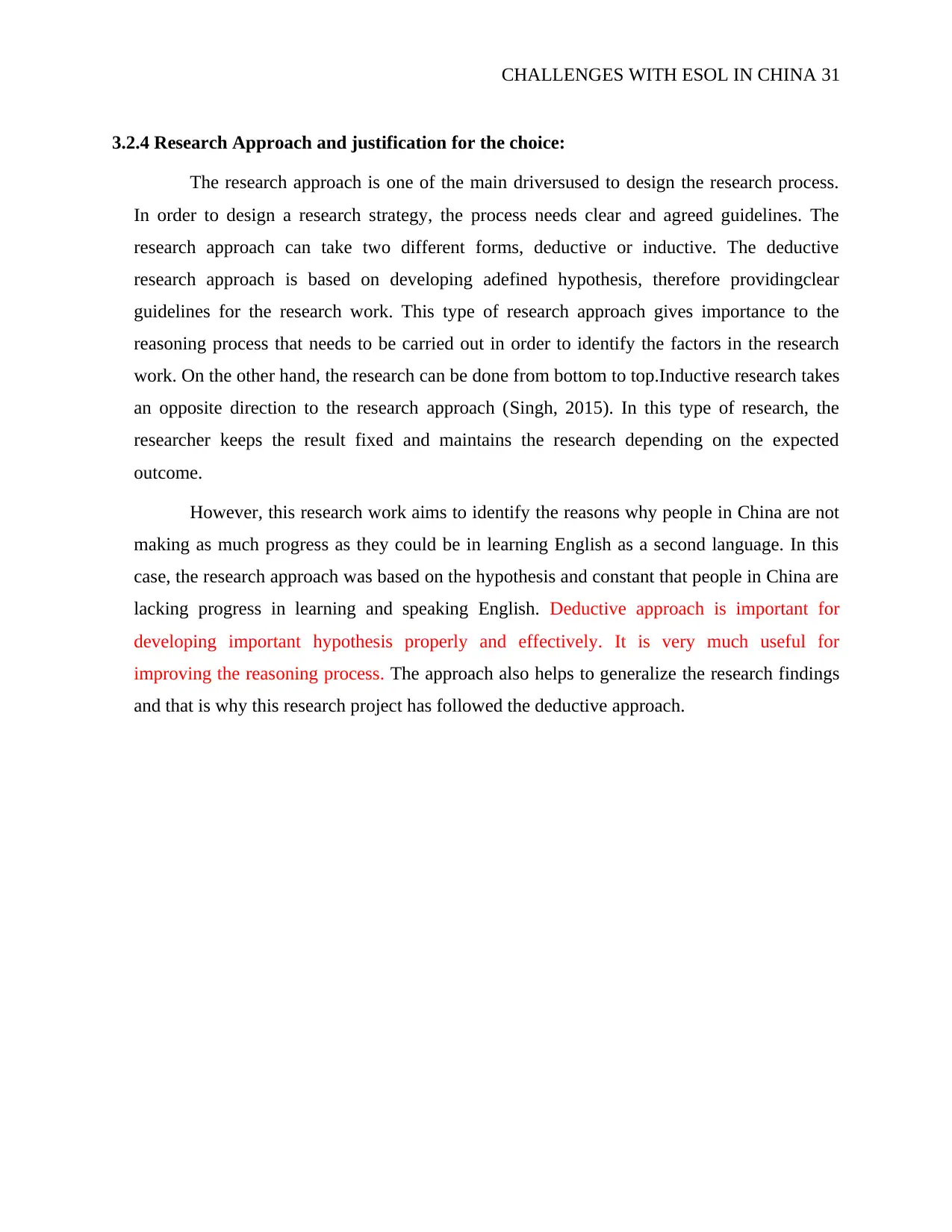
CHALLENGES WITH ESOL IN CHINA 31
3.2.4 Research Approach and justification for the choice:
The research approach is one of the main driversused to design the research process.
In order to design a research strategy, the process needs clear and agreed guidelines. The
research approach can take two different forms, deductive or inductive. The deductive
research approach is based on developing adefined hypothesis, therefore providingclear
guidelines for the research work. This type of research approach gives importance to the
reasoning process that needs to be carried out in order to identify the factors in the research
work. On the other hand, the research can be done from bottom to top.Inductive research takes
an opposite direction to the research approach (Singh, 2015). In this type of research, the
researcher keeps the result fixed and maintains the research depending on the expected
outcome.
However, this research work aims to identify the reasons why people in China are not
making as much progress as they could be in learning English as a second language. In this
case, the research approach was based on the hypothesis and constant that people in China are
lacking progress in learning and speaking English. Deductive approach is important for
developing important hypothesis properly and effectively. It is very much useful for
improving the reasoning process. The approach also helps to generalize the research findings
and that is why this research project has followed the deductive approach.
3.2.4 Research Approach and justification for the choice:
The research approach is one of the main driversused to design the research process.
In order to design a research strategy, the process needs clear and agreed guidelines. The
research approach can take two different forms, deductive or inductive. The deductive
research approach is based on developing adefined hypothesis, therefore providingclear
guidelines for the research work. This type of research approach gives importance to the
reasoning process that needs to be carried out in order to identify the factors in the research
work. On the other hand, the research can be done from bottom to top.Inductive research takes
an opposite direction to the research approach (Singh, 2015). In this type of research, the
researcher keeps the result fixed and maintains the research depending on the expected
outcome.
However, this research work aims to identify the reasons why people in China are not
making as much progress as they could be in learning English as a second language. In this
case, the research approach was based on the hypothesis and constant that people in China are
lacking progress in learning and speaking English. Deductive approach is important for
developing important hypothesis properly and effectively. It is very much useful for
improving the reasoning process. The approach also helps to generalize the research findings
and that is why this research project has followed the deductive approach.
Paraphrase This Document
Need a fresh take? Get an instant paraphrase of this document with our AI Paraphraser
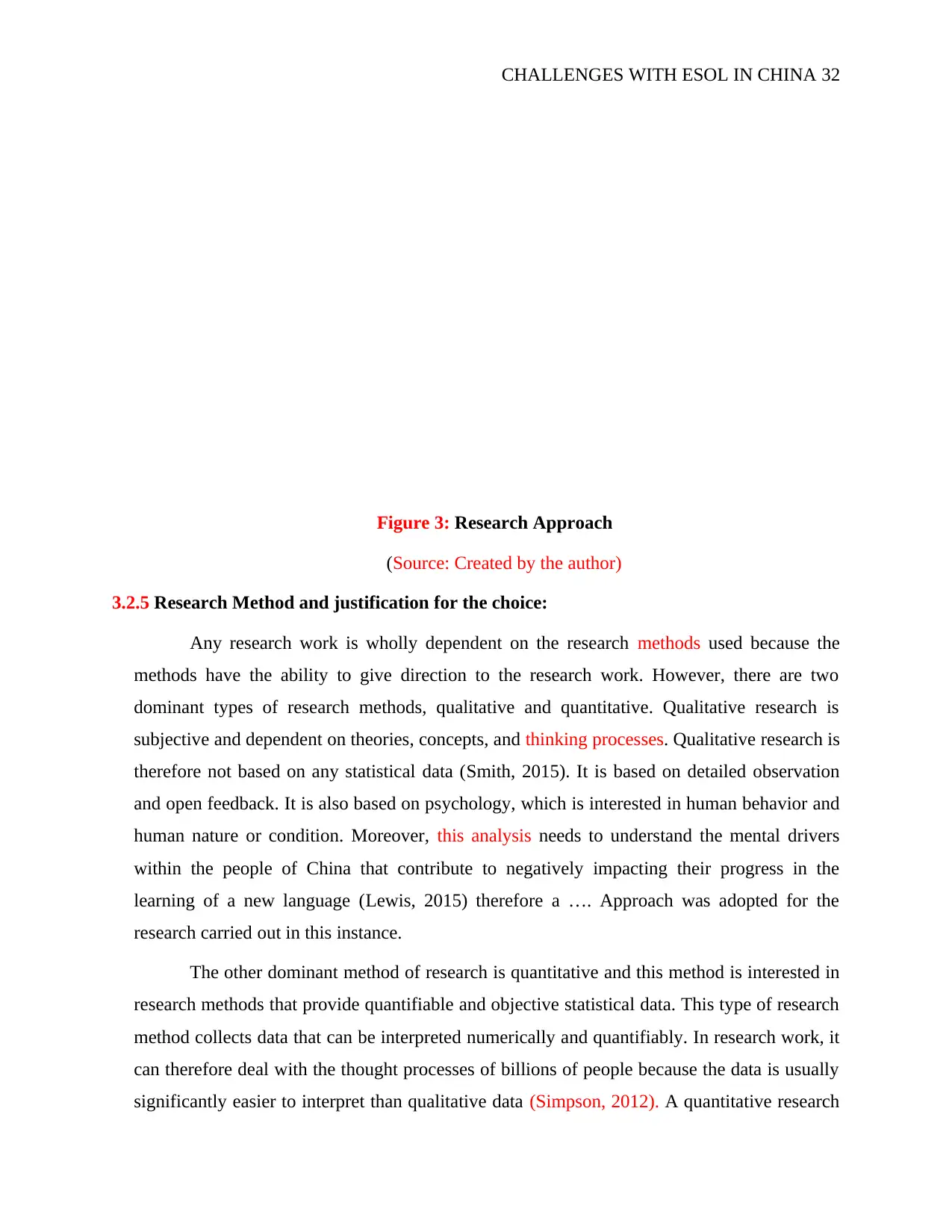
CHALLENGES WITH ESOL IN CHINA 32
Figure 3: Research Approach
(Source: Created by the author)
3.2.5 Research Method and justification for the choice:
Any research work is wholly dependent on the research methods used because the
methods have the ability to give direction to the research work. However, there are two
dominant types of research methods, qualitative and quantitative. Qualitative research is
subjective and dependent on theories, concepts, and thinking processes. Qualitative research is
therefore not based on any statistical data (Smith, 2015). It is based on detailed observation
and open feedback. It is also based on psychology, which is interested in human behavior and
human nature or condition. Moreover, this analysis needs to understand the mental drivers
within the people of China that contribute to negatively impacting their progress in the
learning of a new language (Lewis, 2015) therefore a …. Approach was adopted for the
research carried out in this instance.
The other dominant method of research is quantitative and this method is interested in
research methods that provide quantifiable and objective statistical data. This type of research
method collects data that can be interpreted numerically and quantifiably. In research work, it
can therefore deal with the thought processes of billions of people because the data is usually
significantly easier to interpret than qualitative data (Simpson, 2012). A quantitative research
Figure 3: Research Approach
(Source: Created by the author)
3.2.5 Research Method and justification for the choice:
Any research work is wholly dependent on the research methods used because the
methods have the ability to give direction to the research work. However, there are two
dominant types of research methods, qualitative and quantitative. Qualitative research is
subjective and dependent on theories, concepts, and thinking processes. Qualitative research is
therefore not based on any statistical data (Smith, 2015). It is based on detailed observation
and open feedback. It is also based on psychology, which is interested in human behavior and
human nature or condition. Moreover, this analysis needs to understand the mental drivers
within the people of China that contribute to negatively impacting their progress in the
learning of a new language (Lewis, 2015) therefore a …. Approach was adopted for the
research carried out in this instance.
The other dominant method of research is quantitative and this method is interested in
research methods that provide quantifiable and objective statistical data. This type of research
method collects data that can be interpreted numerically and quantifiably. In research work, it
can therefore deal with the thought processes of billions of people because the data is usually
significantly easier to interpret than qualitative data (Simpson, 2012). A quantitative research

CHALLENGES WITH ESOL IN CHINA 33
method helps to balance the research findings. This research has followed both the qualitative
method of research to help identify the factors that are affecting the thought processes of
people in China.
Figure 3.1.2.9: Research Method
(Source: Created by Researcher)
3.3 Research Design
3.3.1 Settings:
This research has focused on the learning process of the people in China. It has been
shown by (Simpson, 2012) that the general populace of China are lacking progress when
learning English. Given that the government has identified and settled on English as the
second language of preference to help the country, the people of this country should be
making better progress (Chen & Wright, 2017). It has been found that progress is still lagging
behind in areas such as fluency and motivation to speak in English, which could negatively
impact the economic and cultural progress of the country.
3.2.2 Participants:
The data collection process and the research work is totally dependent on the
participants involved. Participants in this research project act as the main source of data. This
method helps to balance the research findings. This research has followed both the qualitative
method of research to help identify the factors that are affecting the thought processes of
people in China.
Figure 3.1.2.9: Research Method
(Source: Created by Researcher)
3.3 Research Design
3.3.1 Settings:
This research has focused on the learning process of the people in China. It has been
shown by (Simpson, 2012) that the general populace of China are lacking progress when
learning English. Given that the government has identified and settled on English as the
second language of preference to help the country, the people of this country should be
making better progress (Chen & Wright, 2017). It has been found that progress is still lagging
behind in areas such as fluency and motivation to speak in English, which could negatively
impact the economic and cultural progress of the country.
3.2.2 Participants:
The data collection process and the research work is totally dependent on the
participants involved. Participants in this research project act as the main source of data. This
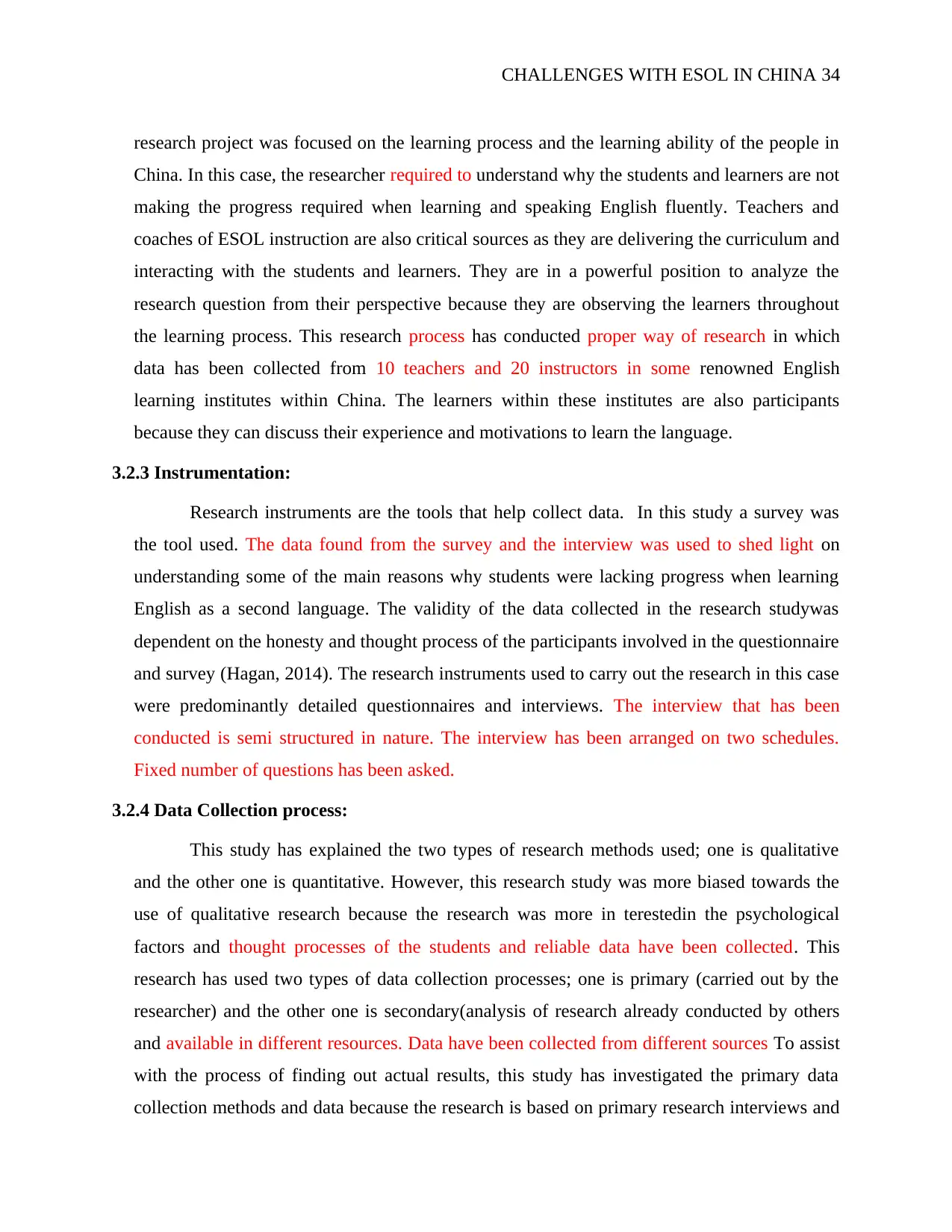
CHALLENGES WITH ESOL IN CHINA 34
research project was focused on the learning process and the learning ability of the people in
China. In this case, the researcher required to understand why the students and learners are not
making the progress required when learning and speaking English fluently. Teachers and
coaches of ESOL instruction are also critical sources as they are delivering the curriculum and
interacting with the students and learners. They are in a powerful position to analyze the
research question from their perspective because they are observing the learners throughout
the learning process. This research process has conducted proper way of research in which
data has been collected from 10 teachers and 20 instructors in some renowned English
learning institutes within China. The learners within these institutes are also participants
because they can discuss their experience and motivations to learn the language.
3.2.3 Instrumentation:
Research instruments are the tools that help collect data. In this study a survey was
the tool used. The data found from the survey and the interview was used to shed light on
understanding some of the main reasons why students were lacking progress when learning
English as a second language. The validity of the data collected in the research studywas
dependent on the honesty and thought process of the participants involved in the questionnaire
and survey (Hagan, 2014). The research instruments used to carry out the research in this case
were predominantly detailed questionnaires and interviews. The interview that has been
conducted is semi structured in nature. The interview has been arranged on two schedules.
Fixed number of questions has been asked.
3.2.4 Data Collection process:
This study has explained the two types of research methods used; one is qualitative
and the other one is quantitative. However, this research study was more biased towards the
use of qualitative research because the research was more in terestedin the psychological
factors and thought processes of the students and reliable data have been collected. This
research has used two types of data collection processes; one is primary (carried out by the
researcher) and the other one is secondary(analysis of research already conducted by others
and available in different resources. Data have been collected from different sources To assist
with the process of finding out actual results, this study has investigated the primary data
collection methods and data because the research is based on primary research interviews and
research project was focused on the learning process and the learning ability of the people in
China. In this case, the researcher required to understand why the students and learners are not
making the progress required when learning and speaking English fluently. Teachers and
coaches of ESOL instruction are also critical sources as they are delivering the curriculum and
interacting with the students and learners. They are in a powerful position to analyze the
research question from their perspective because they are observing the learners throughout
the learning process. This research process has conducted proper way of research in which
data has been collected from 10 teachers and 20 instructors in some renowned English
learning institutes within China. The learners within these institutes are also participants
because they can discuss their experience and motivations to learn the language.
3.2.3 Instrumentation:
Research instruments are the tools that help collect data. In this study a survey was
the tool used. The data found from the survey and the interview was used to shed light on
understanding some of the main reasons why students were lacking progress when learning
English as a second language. The validity of the data collected in the research studywas
dependent on the honesty and thought process of the participants involved in the questionnaire
and survey (Hagan, 2014). The research instruments used to carry out the research in this case
were predominantly detailed questionnaires and interviews. The interview that has been
conducted is semi structured in nature. The interview has been arranged on two schedules.
Fixed number of questions has been asked.
3.2.4 Data Collection process:
This study has explained the two types of research methods used; one is qualitative
and the other one is quantitative. However, this research study was more biased towards the
use of qualitative research because the research was more in terestedin the psychological
factors and thought processes of the students and reliable data have been collected. This
research has used two types of data collection processes; one is primary (carried out by the
researcher) and the other one is secondary(analysis of research already conducted by others
and available in different resources. Data have been collected from different sources To assist
with the process of finding out actual results, this study has investigated the primary data
collection methods and data because the research is based on primary research interviews and
Secure Best Marks with AI Grader
Need help grading? Try our AI Grader for instant feedback on your assignments.
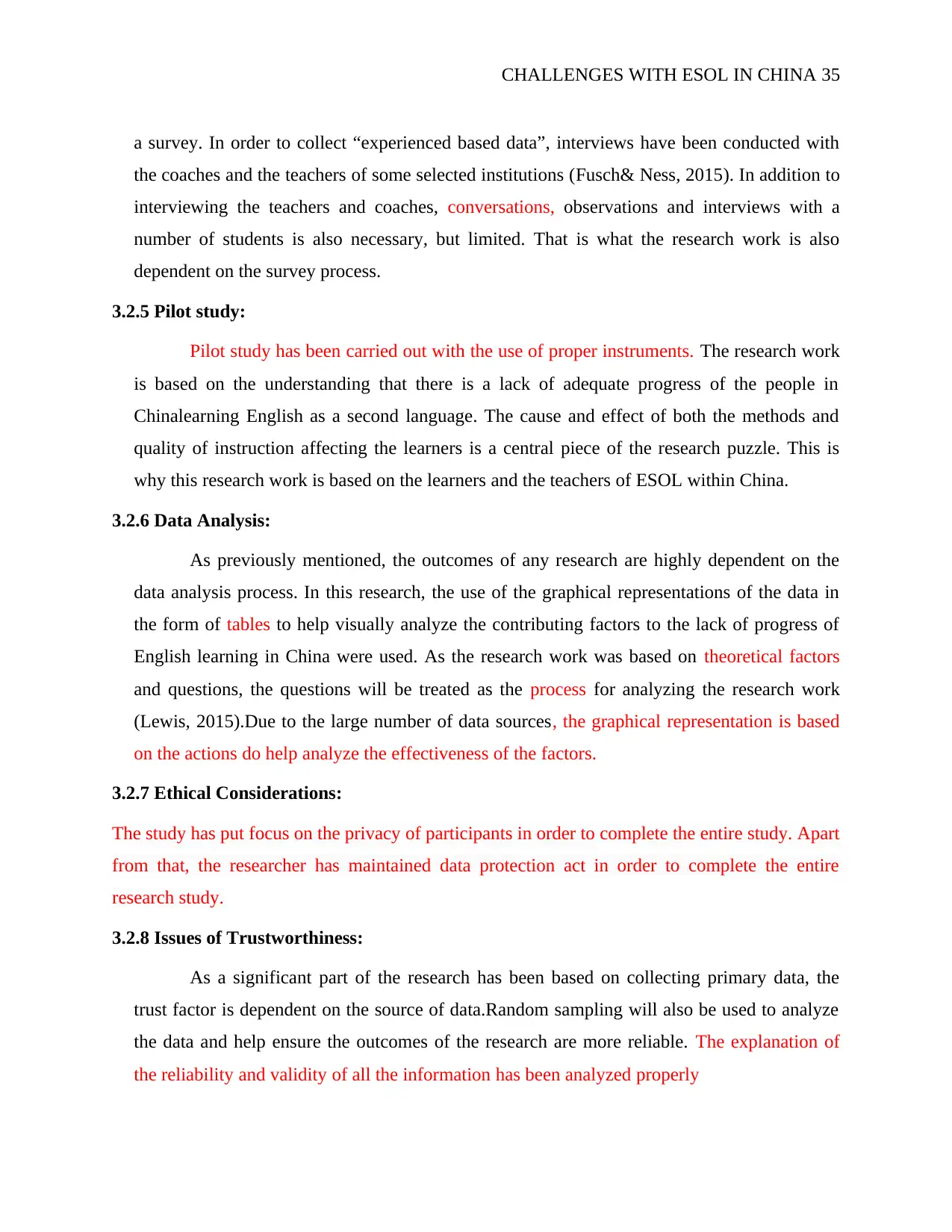
CHALLENGES WITH ESOL IN CHINA 35
a survey. In order to collect “experienced based data”, interviews have been conducted with
the coaches and the teachers of some selected institutions (Fusch& Ness, 2015). In addition to
interviewing the teachers and coaches, conversations, observations and interviews with a
number of students is also necessary, but limited. That is what the research work is also
dependent on the survey process.
3.2.5 Pilot study:
Pilot study has been carried out with the use of proper instruments. The research work
is based on the understanding that there is a lack of adequate progress of the people in
Chinalearning English as a second language. The cause and effect of both the methods and
quality of instruction affecting the learners is a central piece of the research puzzle. This is
why this research work is based on the learners and the teachers of ESOL within China.
3.2.6 Data Analysis:
As previously mentioned, the outcomes of any research are highly dependent on the
data analysis process. In this research, the use of the graphical representations of the data in
the form of tables to help visually analyze the contributing factors to the lack of progress of
English learning in China were used. As the research work was based on theoretical factors
and questions, the questions will be treated as the process for analyzing the research work
(Lewis, 2015).Due to the large number of data sources, the graphical representation is based
on the actions do help analyze the effectiveness of the factors.
3.2.7 Ethical Considerations:
The study has put focus on the privacy of participants in order to complete the entire study. Apart
from that, the researcher has maintained data protection act in order to complete the entire
research study.
3.2.8 Issues of Trustworthiness:
As a significant part of the research has been based on collecting primary data, the
trust factor is dependent on the source of data.Random sampling will also be used to analyze
the data and help ensure the outcomes of the research are more reliable. The explanation of
the reliability and validity of all the information has been analyzed properly
a survey. In order to collect “experienced based data”, interviews have been conducted with
the coaches and the teachers of some selected institutions (Fusch& Ness, 2015). In addition to
interviewing the teachers and coaches, conversations, observations and interviews with a
number of students is also necessary, but limited. That is what the research work is also
dependent on the survey process.
3.2.5 Pilot study:
Pilot study has been carried out with the use of proper instruments. The research work
is based on the understanding that there is a lack of adequate progress of the people in
Chinalearning English as a second language. The cause and effect of both the methods and
quality of instruction affecting the learners is a central piece of the research puzzle. This is
why this research work is based on the learners and the teachers of ESOL within China.
3.2.6 Data Analysis:
As previously mentioned, the outcomes of any research are highly dependent on the
data analysis process. In this research, the use of the graphical representations of the data in
the form of tables to help visually analyze the contributing factors to the lack of progress of
English learning in China were used. As the research work was based on theoretical factors
and questions, the questions will be treated as the process for analyzing the research work
(Lewis, 2015).Due to the large number of data sources, the graphical representation is based
on the actions do help analyze the effectiveness of the factors.
3.2.7 Ethical Considerations:
The study has put focus on the privacy of participants in order to complete the entire study. Apart
from that, the researcher has maintained data protection act in order to complete the entire
research study.
3.2.8 Issues of Trustworthiness:
As a significant part of the research has been based on collecting primary data, the
trust factor is dependent on the source of data.Random sampling will also be used to analyze
the data and help ensure the outcomes of the research are more reliable. The explanation of
the reliability and validity of all the information has been analyzed properly
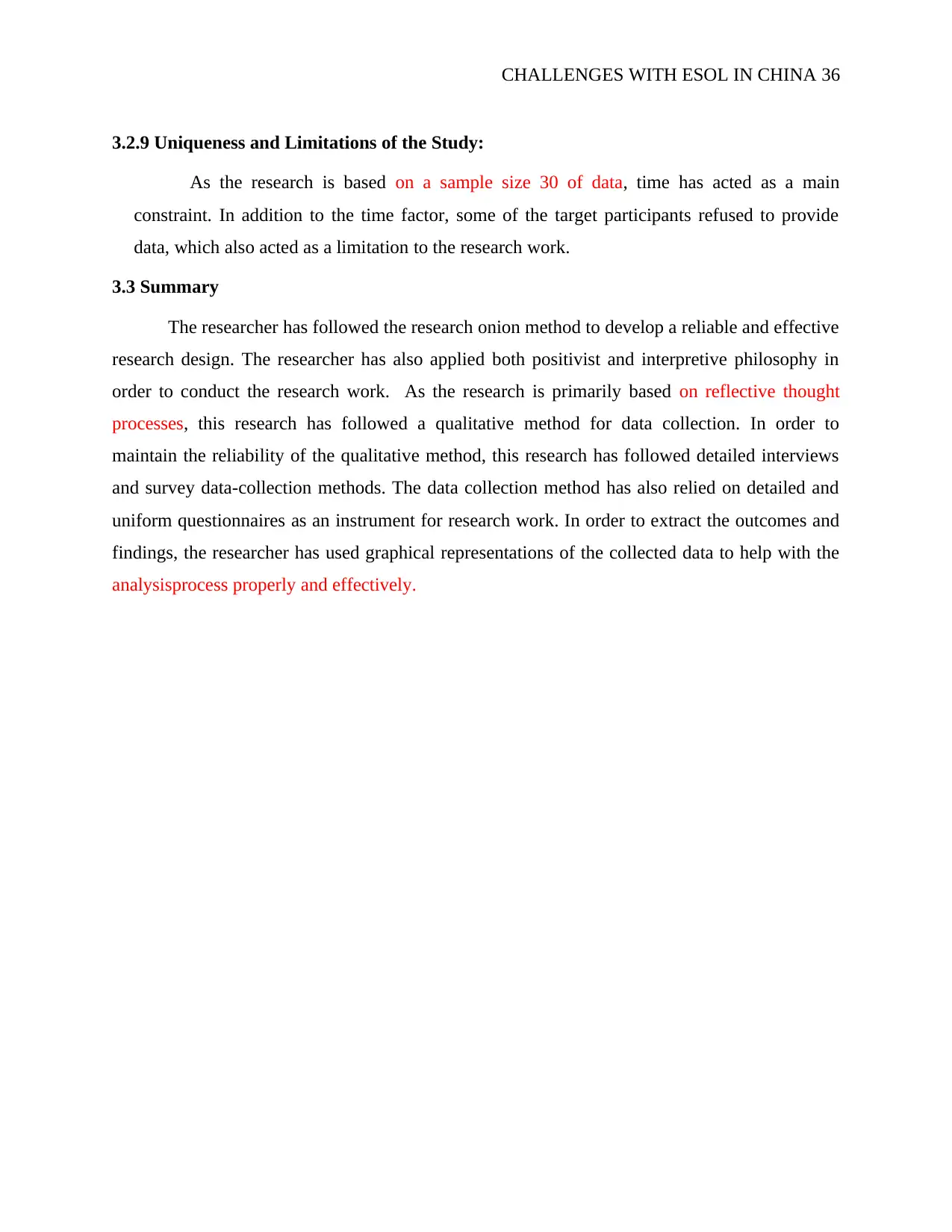
CHALLENGES WITH ESOL IN CHINA 36
3.2.9 Uniqueness and Limitations of the Study:
As the research is based on a sample size 30 of data, time has acted as a main
constraint. In addition to the time factor, some of the target participants refused to provide
data, which also acted as a limitation to the research work.
3.3 Summary
The researcher has followed the research onion method to develop a reliable and effective
research design. The researcher has also applied both positivist and interpretive philosophy in
order to conduct the research work. As the research is primarily based on reflective thought
processes, this research has followed a qualitative method for data collection. In order to
maintain the reliability of the qualitative method, this research has followed detailed interviews
and survey data-collection methods. The data collection method has also relied on detailed and
uniform questionnaires as an instrument for research work. In order to extract the outcomes and
findings, the researcher has used graphical representations of the collected data to help with the
analysisprocess properly and effectively.
3.2.9 Uniqueness and Limitations of the Study:
As the research is based on a sample size 30 of data, time has acted as a main
constraint. In addition to the time factor, some of the target participants refused to provide
data, which also acted as a limitation to the research work.
3.3 Summary
The researcher has followed the research onion method to develop a reliable and effective
research design. The researcher has also applied both positivist and interpretive philosophy in
order to conduct the research work. As the research is primarily based on reflective thought
processes, this research has followed a qualitative method for data collection. In order to
maintain the reliability of the qualitative method, this research has followed detailed interviews
and survey data-collection methods. The data collection method has also relied on detailed and
uniform questionnaires as an instrument for research work. In order to extract the outcomes and
findings, the researcher has used graphical representations of the collected data to help with the
analysisprocess properly and effectively.
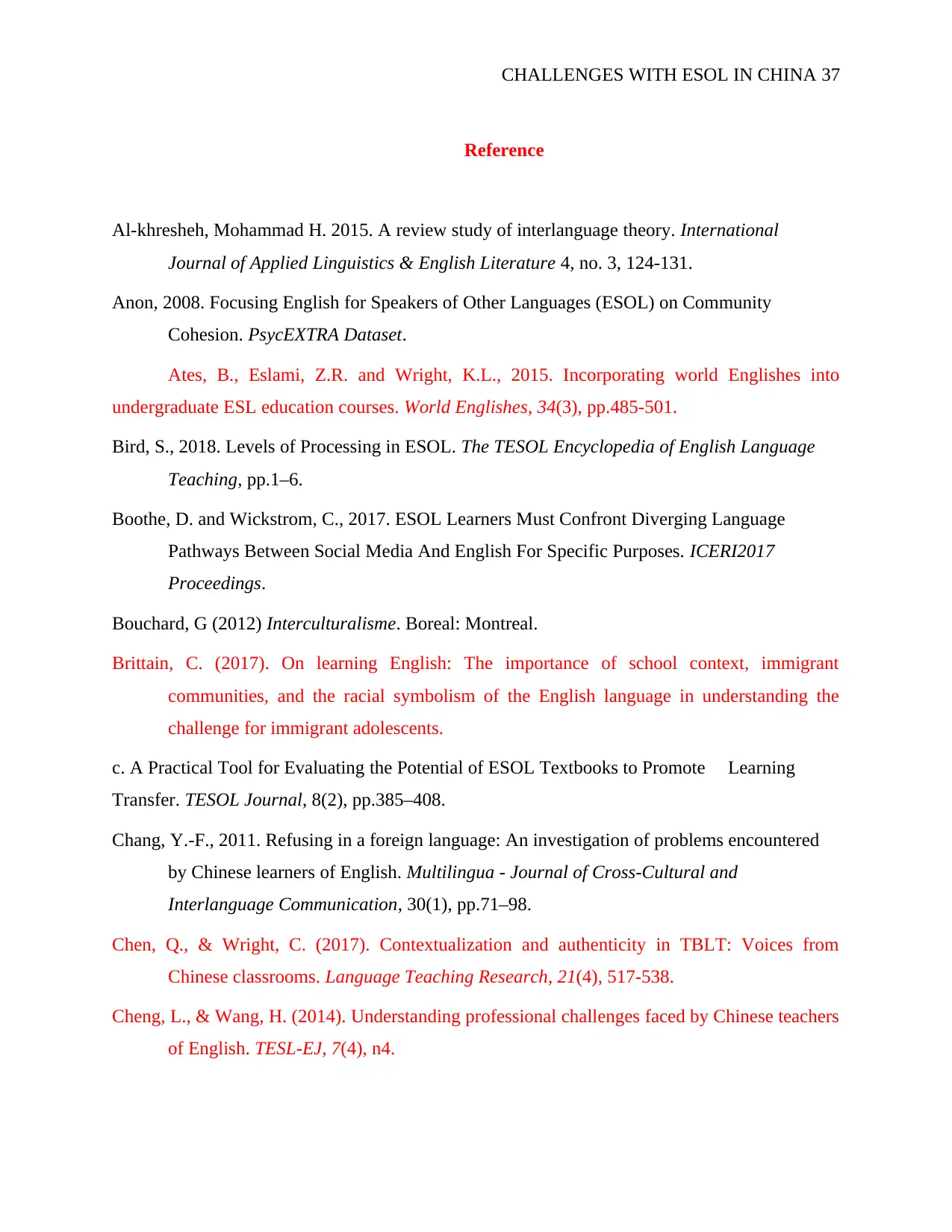
CHALLENGES WITH ESOL IN CHINA 37
Reference
Al-khresheh, Mohammad H. 2015. A review study of interlanguage theory. International
Journal of Applied Linguistics & English Literature 4, no. 3, 124-131.
Anon, 2008. Focusing English for Speakers of Other Languages (ESOL) on Community
Cohesion. PsycEXTRA Dataset.
Ates, B., Eslami, Z.R. and Wright, K.L., 2015. Incorporating world Englishes into
undergraduate ESL education courses. World Englishes, 34(3), pp.485-501.
Bird, S., 2018. Levels of Processing in ESOL. The TESOL Encyclopedia of English Language
Teaching, pp.1–6.
Boothe, D. and Wickstrom, C., 2017. ESOL Learners Must Confront Diverging Language
Pathways Between Social Media And English For Specific Purposes. ICERI2017
Proceedings.
Bouchard, G (2012) Interculturalisme. Boreal: Montreal.
Brittain, C. (2017). On learning English: The importance of school context, immigrant
communities, and the racial symbolism of the English language in understanding the
challenge for immigrant adolescents.
c. A Practical Tool for Evaluating the Potential of ESOL Textbooks to Promote Learning
Transfer. TESOL Journal, 8(2), pp.385–408.
Chang, Y.-F., 2011. Refusing in a foreign language: An investigation of problems encountered
by Chinese learners of English. Multilingua - Journal of Cross-Cultural and
Interlanguage Communication, 30(1), pp.71–98.
Chen, Q., & Wright, C. (2017). Contextualization and authenticity in TBLT: Voices from
Chinese classrooms. Language Teaching Research, 21(4), 517-538.
Cheng, L., & Wang, H. (2014). Understanding professional challenges faced by Chinese teachers
of English. TESL-EJ, 7(4), n4.
Reference
Al-khresheh, Mohammad H. 2015. A review study of interlanguage theory. International
Journal of Applied Linguistics & English Literature 4, no. 3, 124-131.
Anon, 2008. Focusing English for Speakers of Other Languages (ESOL) on Community
Cohesion. PsycEXTRA Dataset.
Ates, B., Eslami, Z.R. and Wright, K.L., 2015. Incorporating world Englishes into
undergraduate ESL education courses. World Englishes, 34(3), pp.485-501.
Bird, S., 2018. Levels of Processing in ESOL. The TESOL Encyclopedia of English Language
Teaching, pp.1–6.
Boothe, D. and Wickstrom, C., 2017. ESOL Learners Must Confront Diverging Language
Pathways Between Social Media And English For Specific Purposes. ICERI2017
Proceedings.
Bouchard, G (2012) Interculturalisme. Boreal: Montreal.
Brittain, C. (2017). On learning English: The importance of school context, immigrant
communities, and the racial symbolism of the English language in understanding the
challenge for immigrant adolescents.
c. A Practical Tool for Evaluating the Potential of ESOL Textbooks to Promote Learning
Transfer. TESOL Journal, 8(2), pp.385–408.
Chang, Y.-F., 2011. Refusing in a foreign language: An investigation of problems encountered
by Chinese learners of English. Multilingua - Journal of Cross-Cultural and
Interlanguage Communication, 30(1), pp.71–98.
Chen, Q., & Wright, C. (2017). Contextualization and authenticity in TBLT: Voices from
Chinese classrooms. Language Teaching Research, 21(4), 517-538.
Cheng, L., & Wang, H. (2014). Understanding professional challenges faced by Chinese teachers
of English. TESL-EJ, 7(4), n4.
Paraphrase This Document
Need a fresh take? Get an instant paraphrase of this document with our AI Paraphraser
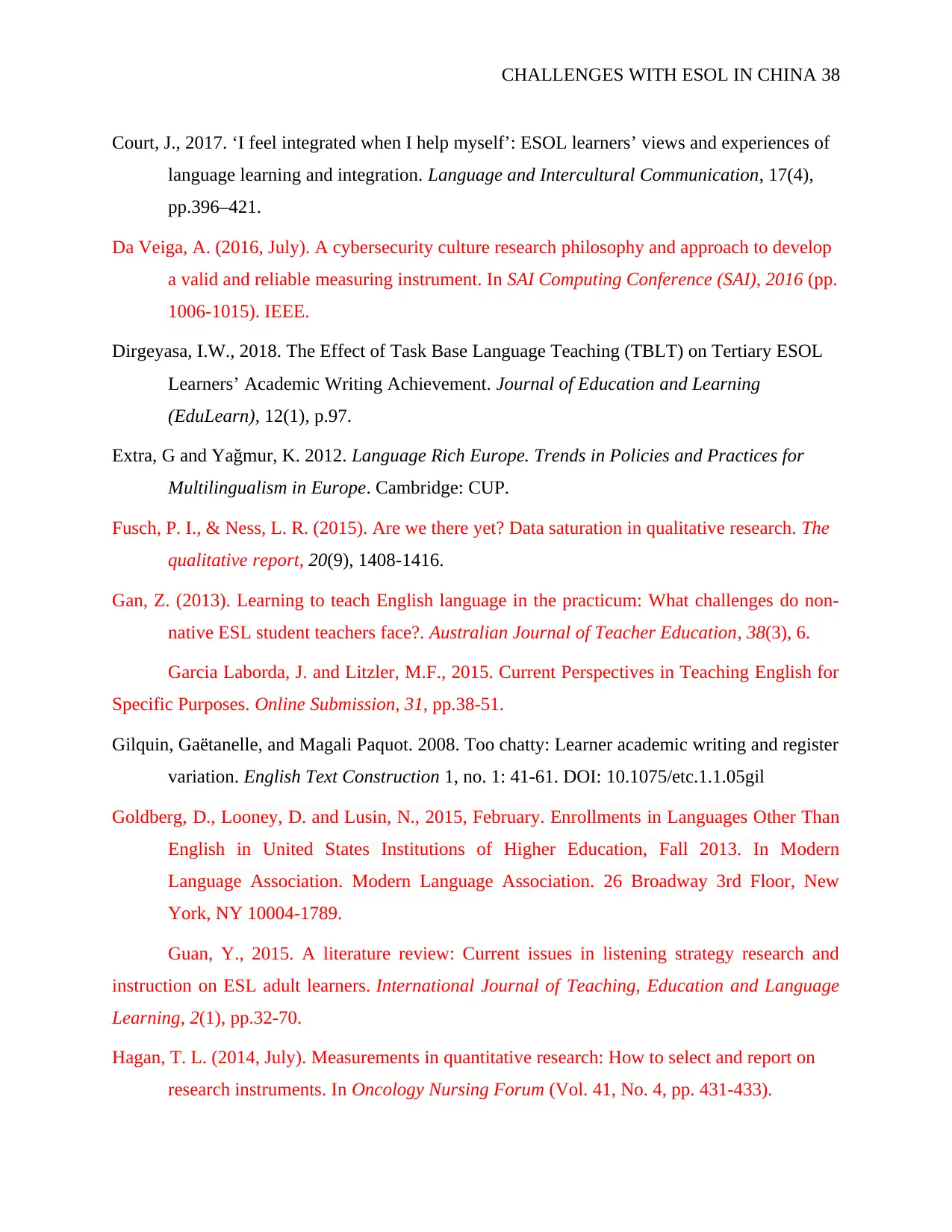
CHALLENGES WITH ESOL IN CHINA 38
Court, J., 2017. ‘I feel integrated when I help myself’: ESOL learners’ views and experiences of
language learning and integration. Language and Intercultural Communication, 17(4),
pp.396–421.
Da Veiga, A. (2016, July). A cybersecurity culture research philosophy and approach to develop
a valid and reliable measuring instrument. In SAI Computing Conference (SAI), 2016 (pp.
1006-1015). IEEE.
Dirgeyasa, I.W., 2018. The Effect of Task Base Language Teaching (TBLT) on Tertiary ESOL
Learners’ Academic Writing Achievement. Journal of Education and Learning
(EduLearn), 12(1), p.97.
Extra, G and Yağmur, K. 2012. Language Rich Europe. Trends in Policies and Practices for
Multilingualism in Europe. Cambridge: CUP.
Fusch, P. I., & Ness, L. R. (2015). Are we there yet? Data saturation in qualitative research. The
qualitative report, 20(9), 1408-1416.
Gan, Z. (2013). Learning to teach English language in the practicum: What challenges do non-
native ESL student teachers face?. Australian Journal of Teacher Education, 38(3), 6.
Garcia Laborda, J. and Litzler, M.F., 2015. Current Perspectives in Teaching English for
Specific Purposes. Online Submission, 31, pp.38-51.
Gilquin, Gaëtanelle, and Magali Paquot. 2008. Too chatty: Learner academic writing and register
variation. English Text Construction 1, no. 1: 41-61. DOI: 10.1075/etc.1.1.05gil
Goldberg, D., Looney, D. and Lusin, N., 2015, February. Enrollments in Languages Other Than
English in United States Institutions of Higher Education, Fall 2013. In Modern
Language Association. Modern Language Association. 26 Broadway 3rd Floor, New
York, NY 10004-1789.
Guan, Y., 2015. A literature review: Current issues in listening strategy research and
instruction on ESL adult learners. International Journal of Teaching, Education and Language
Learning, 2(1), pp.32-70.
Hagan, T. L. (2014, July). Measurements in quantitative research: How to select and report on
research instruments. In Oncology Nursing Forum (Vol. 41, No. 4, pp. 431-433).
Court, J., 2017. ‘I feel integrated when I help myself’: ESOL learners’ views and experiences of
language learning and integration. Language and Intercultural Communication, 17(4),
pp.396–421.
Da Veiga, A. (2016, July). A cybersecurity culture research philosophy and approach to develop
a valid and reliable measuring instrument. In SAI Computing Conference (SAI), 2016 (pp.
1006-1015). IEEE.
Dirgeyasa, I.W., 2018. The Effect of Task Base Language Teaching (TBLT) on Tertiary ESOL
Learners’ Academic Writing Achievement. Journal of Education and Learning
(EduLearn), 12(1), p.97.
Extra, G and Yağmur, K. 2012. Language Rich Europe. Trends in Policies and Practices for
Multilingualism in Europe. Cambridge: CUP.
Fusch, P. I., & Ness, L. R. (2015). Are we there yet? Data saturation in qualitative research. The
qualitative report, 20(9), 1408-1416.
Gan, Z. (2013). Learning to teach English language in the practicum: What challenges do non-
native ESL student teachers face?. Australian Journal of Teacher Education, 38(3), 6.
Garcia Laborda, J. and Litzler, M.F., 2015. Current Perspectives in Teaching English for
Specific Purposes. Online Submission, 31, pp.38-51.
Gilquin, Gaëtanelle, and Magali Paquot. 2008. Too chatty: Learner academic writing and register
variation. English Text Construction 1, no. 1: 41-61. DOI: 10.1075/etc.1.1.05gil
Goldberg, D., Looney, D. and Lusin, N., 2015, February. Enrollments in Languages Other Than
English in United States Institutions of Higher Education, Fall 2013. In Modern
Language Association. Modern Language Association. 26 Broadway 3rd Floor, New
York, NY 10004-1789.
Guan, Y., 2015. A literature review: Current issues in listening strategy research and
instruction on ESL adult learners. International Journal of Teaching, Education and Language
Learning, 2(1), pp.32-70.
Hagan, T. L. (2014, July). Measurements in quantitative research: How to select and report on
research instruments. In Oncology Nursing Forum (Vol. 41, No. 4, pp. 431-433).

CHALLENGES WITH ESOL IN CHINA 39
Horner, K and Weber, J. 2011. Not playing the game: Shifting patterns in the discourse of
integration. Journal of Language and Politics 10:2. iii (pp. 139-159).
Hsiao, S. J. (2018). Aging and ESL Learning among Older Adult Chinese-Speaking
Immigrants. Global Journal of Human-Social Science Research.
Hughes, J. A., & Sharrock, W. W. (2016). The philosophy of social research. UK: Routledge.
Kang, O., 2015. Learners' perceptions toward pronunciation instruction in Three Circles
of World Englishes. TESOL Journal, 6(1), pp.59-80.
Kawato, M. (2016). U.S. Patent Application No. 15/111,428.
Kurita, T. 2012. Issues in second language listening comprehension and the pedagogical
implications. Accents Asia, 5(1), 30-44.
Lamarre, P. 2013. ‘Catching “Montréal on the Move” and Challenging the Discourse of
Unilingualism in Québec’, in Anthropologica55: 1-16.
Lefstein, A and Snell, J. 2014. Better Than Best Practice: developing teaching and learning
through dialogue. Routledge.
Lewis, S. (2015). Qualitative inquiry and research design: Choosing among five
approaches. Health promotion practice, 16(4), 473-475.
Lewis, S. (2015). Qualitative inquiry and research design: Choosing among five
approaches. Health promotion practice, 16(4), 473-475.
Linville, H.A., 2015. ESOL Teachers as Advocates: An Important Role? TESOL Journal, 7(1),
pp.98–131.
Liontas, J.I., 2015. Developing Idiomatic Competence in the ESOL Classroom: A Pragmatic
Account. TESOL Journal, 6(4), pp.621–658.
MacKinnon, G. R., Greene, K., Rawn, E., Cressey, J., & He, W. (2017). Employing STEM
Curriculum in an ESL Classroom: A Chinese Case Study. K-12 STEM Education, 3(1),
143-155.
MacWhinney, B., 2014. The CHILDES project: Tools for analyzing talk, Volume II: The
database. Psychology Press.
Horner, K and Weber, J. 2011. Not playing the game: Shifting patterns in the discourse of
integration. Journal of Language and Politics 10:2. iii (pp. 139-159).
Hsiao, S. J. (2018). Aging and ESL Learning among Older Adult Chinese-Speaking
Immigrants. Global Journal of Human-Social Science Research.
Hughes, J. A., & Sharrock, W. W. (2016). The philosophy of social research. UK: Routledge.
Kang, O., 2015. Learners' perceptions toward pronunciation instruction in Three Circles
of World Englishes. TESOL Journal, 6(1), pp.59-80.
Kawato, M. (2016). U.S. Patent Application No. 15/111,428.
Kurita, T. 2012. Issues in second language listening comprehension and the pedagogical
implications. Accents Asia, 5(1), 30-44.
Lamarre, P. 2013. ‘Catching “Montréal on the Move” and Challenging the Discourse of
Unilingualism in Québec’, in Anthropologica55: 1-16.
Lefstein, A and Snell, J. 2014. Better Than Best Practice: developing teaching and learning
through dialogue. Routledge.
Lewis, S. (2015). Qualitative inquiry and research design: Choosing among five
approaches. Health promotion practice, 16(4), 473-475.
Lewis, S. (2015). Qualitative inquiry and research design: Choosing among five
approaches. Health promotion practice, 16(4), 473-475.
Linville, H.A., 2015. ESOL Teachers as Advocates: An Important Role? TESOL Journal, 7(1),
pp.98–131.
Liontas, J.I., 2015. Developing Idiomatic Competence in the ESOL Classroom: A Pragmatic
Account. TESOL Journal, 6(4), pp.621–658.
MacKinnon, G. R., Greene, K., Rawn, E., Cressey, J., & He, W. (2017). Employing STEM
Curriculum in an ESL Classroom: A Chinese Case Study. K-12 STEM Education, 3(1),
143-155.
MacWhinney, B., 2014. The CHILDES project: Tools for analyzing talk, Volume II: The
database. Psychology Press.
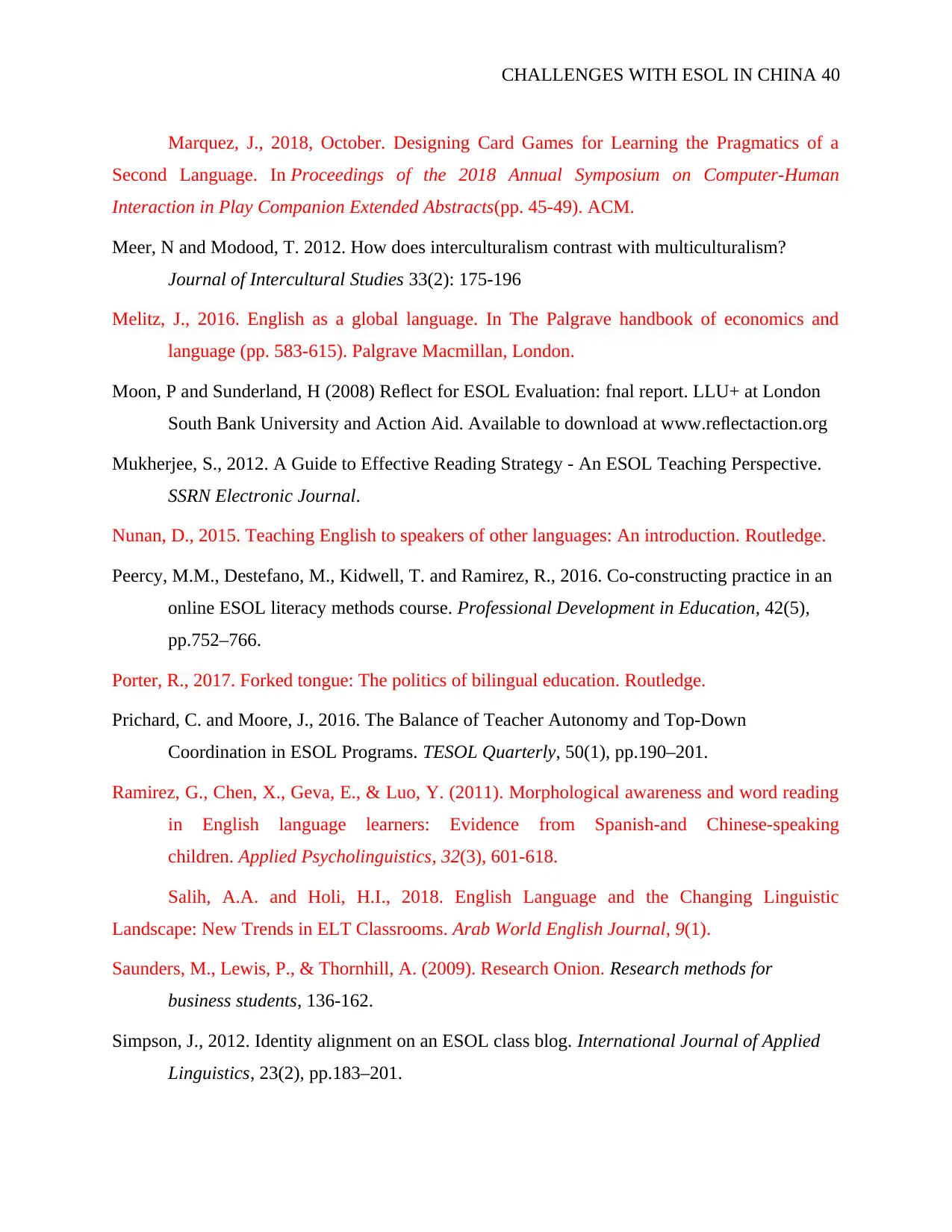
CHALLENGES WITH ESOL IN CHINA 40
Marquez, J., 2018, October. Designing Card Games for Learning the Pragmatics of a
Second Language. In Proceedings of the 2018 Annual Symposium on Computer-Human
Interaction in Play Companion Extended Abstracts(pp. 45-49). ACM.
Meer, N and Modood, T. 2012. How does interculturalism contrast with multiculturalism?
Journal of Intercultural Studies 33(2): 175-196
Melitz, J., 2016. English as a global language. In The Palgrave handbook of economics and
language (pp. 583-615). Palgrave Macmillan, London.
Moon, P and Sunderland, H (2008) Reflect for ESOL Evaluation: fnal report. LLU+ at London
South Bank University and Action Aid. Available to download at www.reflectaction.org
Mukherjee, S., 2012. A Guide to Effective Reading Strategy - An ESOL Teaching Perspective.
SSRN Electronic Journal.
Nunan, D., 2015. Teaching English to speakers of other languages: An introduction. Routledge.
Peercy, M.M., Destefano, M., Kidwell, T. and Ramirez, R., 2016. Co-constructing practice in an
online ESOL literacy methods course. Professional Development in Education, 42(5),
pp.752–766.
Porter, R., 2017. Forked tongue: The politics of bilingual education. Routledge.
Prichard, C. and Moore, J., 2016. The Balance of Teacher Autonomy and Top-Down
Coordination in ESOL Programs. TESOL Quarterly, 50(1), pp.190–201.
Ramirez, G., Chen, X., Geva, E., & Luo, Y. (2011). Morphological awareness and word reading
in English language learners: Evidence from Spanish-and Chinese-speaking
children. Applied Psycholinguistics, 32(3), 601-618.
Salih, A.A. and Holi, H.I., 2018. English Language and the Changing Linguistic
Landscape: New Trends in ELT Classrooms. Arab World English Journal, 9(1).
Saunders, M., Lewis, P., & Thornhill, A. (2009). Research Onion. Research methods for
business students, 136-162.
Simpson, J., 2012. Identity alignment on an ESOL class blog. International Journal of Applied
Linguistics, 23(2), pp.183–201.
Marquez, J., 2018, October. Designing Card Games for Learning the Pragmatics of a
Second Language. In Proceedings of the 2018 Annual Symposium on Computer-Human
Interaction in Play Companion Extended Abstracts(pp. 45-49). ACM.
Meer, N and Modood, T. 2012. How does interculturalism contrast with multiculturalism?
Journal of Intercultural Studies 33(2): 175-196
Melitz, J., 2016. English as a global language. In The Palgrave handbook of economics and
language (pp. 583-615). Palgrave Macmillan, London.
Moon, P and Sunderland, H (2008) Reflect for ESOL Evaluation: fnal report. LLU+ at London
South Bank University and Action Aid. Available to download at www.reflectaction.org
Mukherjee, S., 2012. A Guide to Effective Reading Strategy - An ESOL Teaching Perspective.
SSRN Electronic Journal.
Nunan, D., 2015. Teaching English to speakers of other languages: An introduction. Routledge.
Peercy, M.M., Destefano, M., Kidwell, T. and Ramirez, R., 2016. Co-constructing practice in an
online ESOL literacy methods course. Professional Development in Education, 42(5),
pp.752–766.
Porter, R., 2017. Forked tongue: The politics of bilingual education. Routledge.
Prichard, C. and Moore, J., 2016. The Balance of Teacher Autonomy and Top-Down
Coordination in ESOL Programs. TESOL Quarterly, 50(1), pp.190–201.
Ramirez, G., Chen, X., Geva, E., & Luo, Y. (2011). Morphological awareness and word reading
in English language learners: Evidence from Spanish-and Chinese-speaking
children. Applied Psycholinguistics, 32(3), 601-618.
Salih, A.A. and Holi, H.I., 2018. English Language and the Changing Linguistic
Landscape: New Trends in ELT Classrooms. Arab World English Journal, 9(1).
Saunders, M., Lewis, P., & Thornhill, A. (2009). Research Onion. Research methods for
business students, 136-162.
Simpson, J., 2012. Identity alignment on an ESOL class blog. International Journal of Applied
Linguistics, 23(2), pp.183–201.
Secure Best Marks with AI Grader
Need help grading? Try our AI Grader for instant feedback on your assignments.
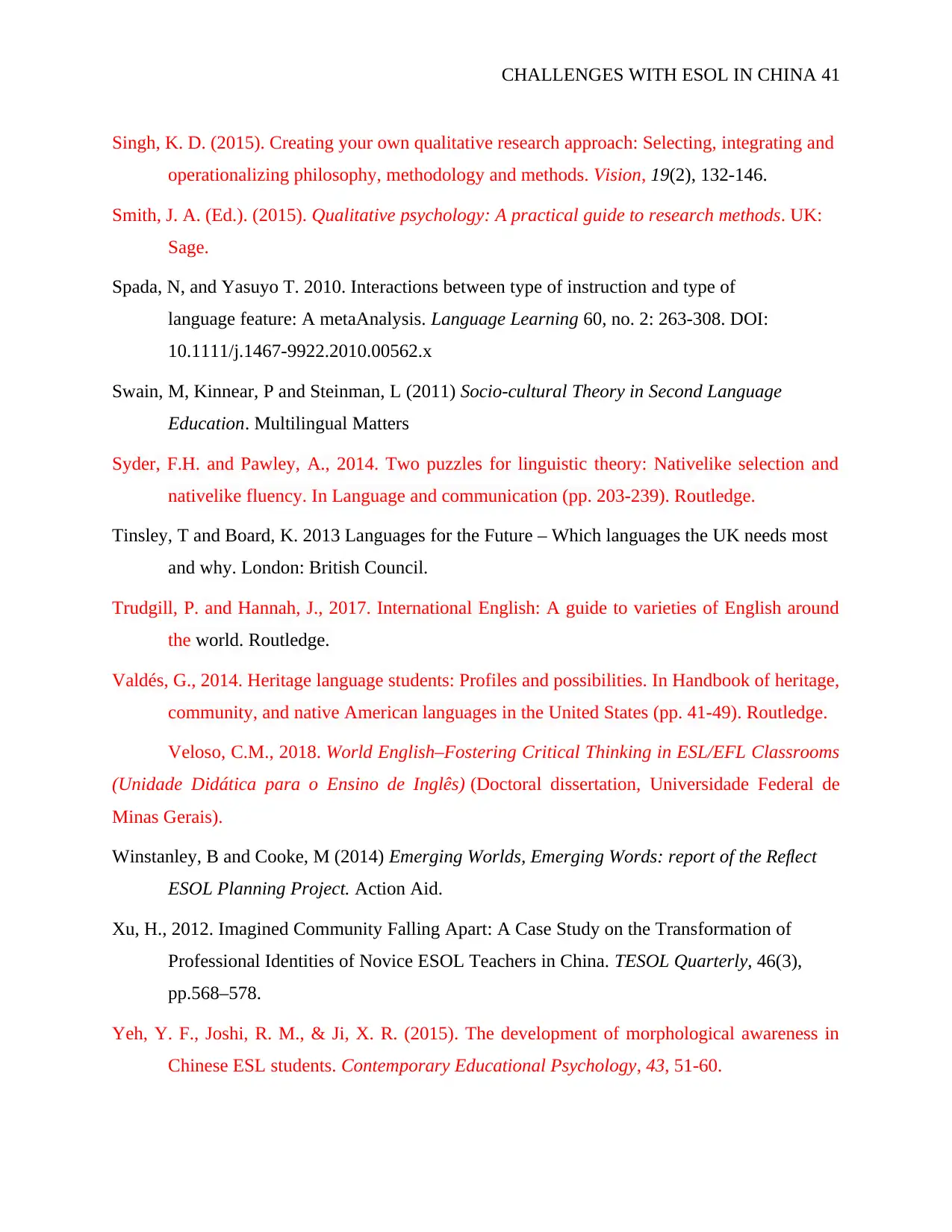
CHALLENGES WITH ESOL IN CHINA 41
Singh, K. D. (2015). Creating your own qualitative research approach: Selecting, integrating and
operationalizing philosophy, methodology and methods. Vision, 19(2), 132-146.
Smith, J. A. (Ed.). (2015). Qualitative psychology: A practical guide to research methods. UK:
Sage.
Spada, N, and Yasuyo T. 2010. Interactions between type of instruction and type of
language feature: A metaAnalysis. Language Learning 60, no. 2: 263-308. DOI:
10.1111/j.1467-9922.2010.00562.x
Swain, M, Kinnear, P and Steinman, L (2011) Socio-cultural Theory in Second Language
Education. Multilingual Matters
Syder, F.H. and Pawley, A., 2014. Two puzzles for linguistic theory: Nativelike selection and
nativelike fluency. In Language and communication (pp. 203-239). Routledge.
Tinsley, T and Board, K. 2013 Languages for the Future – Which languages the UK needs most
and why. London: British Council.
Trudgill, P. and Hannah, J., 2017. International English: A guide to varieties of English around
the world. Routledge.
Valdés, G., 2014. Heritage language students: Profiles and possibilities. In Handbook of heritage,
community, and native American languages in the United States (pp. 41-49). Routledge.
Veloso, C.M., 2018. World English–Fostering Critical Thinking in ESL/EFL Classrooms
(Unidade Didática para o Ensino de Inglês) (Doctoral dissertation, Universidade Federal de
Minas Gerais).
Winstanley, B and Cooke, M (2014) Emerging Worlds, Emerging Words: report of the Reflect
ESOL Planning Project. Action Aid.
Xu, H., 2012. Imagined Community Falling Apart: A Case Study on the Transformation of
Professional Identities of Novice ESOL Teachers in China. TESOL Quarterly, 46(3),
pp.568–578.
Yeh, Y. F., Joshi, R. M., & Ji, X. R. (2015). The development of morphological awareness in
Chinese ESL students. Contemporary Educational Psychology, 43, 51-60.
Singh, K. D. (2015). Creating your own qualitative research approach: Selecting, integrating and
operationalizing philosophy, methodology and methods. Vision, 19(2), 132-146.
Smith, J. A. (Ed.). (2015). Qualitative psychology: A practical guide to research methods. UK:
Sage.
Spada, N, and Yasuyo T. 2010. Interactions between type of instruction and type of
language feature: A metaAnalysis. Language Learning 60, no. 2: 263-308. DOI:
10.1111/j.1467-9922.2010.00562.x
Swain, M, Kinnear, P and Steinman, L (2011) Socio-cultural Theory in Second Language
Education. Multilingual Matters
Syder, F.H. and Pawley, A., 2014. Two puzzles for linguistic theory: Nativelike selection and
nativelike fluency. In Language and communication (pp. 203-239). Routledge.
Tinsley, T and Board, K. 2013 Languages for the Future – Which languages the UK needs most
and why. London: British Council.
Trudgill, P. and Hannah, J., 2017. International English: A guide to varieties of English around
the world. Routledge.
Valdés, G., 2014. Heritage language students: Profiles and possibilities. In Handbook of heritage,
community, and native American languages in the United States (pp. 41-49). Routledge.
Veloso, C.M., 2018. World English–Fostering Critical Thinking in ESL/EFL Classrooms
(Unidade Didática para o Ensino de Inglês) (Doctoral dissertation, Universidade Federal de
Minas Gerais).
Winstanley, B and Cooke, M (2014) Emerging Worlds, Emerging Words: report of the Reflect
ESOL Planning Project. Action Aid.
Xu, H., 2012. Imagined Community Falling Apart: A Case Study on the Transformation of
Professional Identities of Novice ESOL Teachers in China. TESOL Quarterly, 46(3),
pp.568–578.
Yeh, Y. F., Joshi, R. M., & Ji, X. R. (2015). The development of morphological awareness in
Chinese ESL students. Contemporary Educational Psychology, 43, 51-60.

CHALLENGES WITH ESOL IN CHINA 42
Zhang, Y. (2016). International Students in Transition: Voices of Chinese Doctoral Students in a
US Research University. Journal of International Students, 6(1), 175-194.
Zhang, Y. (2016). International Students in Transition: Voices of Chinese Doctoral Students in a
US Research University. Journal of International Students, 6(1), 175-194.
1 out of 42
Related Documents
Your All-in-One AI-Powered Toolkit for Academic Success.
+13062052269
info@desklib.com
Available 24*7 on WhatsApp / Email
![[object Object]](/_next/static/media/star-bottom.7253800d.svg)
Unlock your academic potential
© 2024 | Zucol Services PVT LTD | All rights reserved.





